
- Case Studies
- Free Coaching Session

Production Plan in Business Plan: A Comprehensive Guide to Success
Last Updated:
February 26, 2024

In any business venture, a solid production plan is crucial for success. A production plan serves as a roadmap that outlines the steps, resources, and strategies required to manufacture products or deliver services efficiently. By carefully crafting a production plan within a business plan, entrepreneurs can ensure optimal utilisation of resources, timely delivery, cost efficiency, and customer satisfaction. In this article, we will delve into the intricacies of creating an effective production plan in a business plan , exploring its key components, strategies, and the importance of aligning it with overall business objectives .
Key Takeaways on Production Plans in Business Planning
- A production plan : a detailed outline that guides efficient product manufacturing or service delivery.
- Importance of a production plan : provides a roadmap for operations, optimises resource utilisation, and aligns with customer demand.
- Key components : demand forecasting, capacity planning, inventory management, resource allocation, and quality assurance.
- Strategies : lean manufacturing, JIT inventory, automation and technology integration, supplier relationship management, and continuous improvement.
- Benefits of a well-executed production plan : improved efficiency, reduced costs, enhanced product quality, and increased profitability.

What is a Production Plan?
A production Seamless Searches plan is a detailed outline that specifies the processes, resources, timelines, and strategies required to convert raw materials into finished goods or deliver services. It serves as a blueprint for the entire production cycle, guiding decision-making and resource allocation. The production plan considers factors such as demand forecasting, capacity planning, inventory management, and quality assurance to ensure efficient operations and optimal customer satisfaction.
Why is a Production Plan Important in a Business Plan?
The inclusion of a production plan in a business plan is vital for several reasons. First and foremost, it provides a clear roadmap for business operations, helping entrepreneurs and managers make informed decisions related to production processes. A well-developed production plan ensures that resources are utilised efficiently, minimising wastage and optimising productivity.
Additionally, a production plan allows businesses to align their production capabilities with customer demand. By forecasting market trends and analysing customer needs, businesses can develop a production plan that caters to current and future demands, thus avoiding overstocking or understocking situations.
Furthermore, a production plan helps businesses enhance their competitive advantage. By implementing strategies such as lean manufacturing and automation, companies can streamline their production processes, reduce costs, improve product quality, and ultimately outperform competitors.
Key Components of a Production Plan
To create an effective production plan, it is crucial to consider several key components. These components work together to ensure efficient operations and successful fulfilment of customer demands. Let's explore each component in detail.
Demand Forecasting
Demand forecasting is a critical aspect of production planning. By analysing historical data, market trends, and customer behaviour, businesses can predict future demand for their products or services. Accurate demand forecasting allows companies to optimise inventory levels, plan production capacity, and ensure timely delivery to customers.
One approach to demand forecasting is quantitative analysis, which involves analysing historical sales data to identify patterns and make predictions. Another approach is qualitative analysis, which incorporates market research, customer surveys, and expert opinions to gauge demand fluctuations. By combining both methods, businesses can develop a robust demand forecast, minimising the risk of underproduction or overproduction. Utilising a free notion template for demand forecasting can further streamline this process, allowing businesses to organise and analyse both quantitative and qualitative data efficiently in one centralised location.
Capacity Planning
Capacity planning involves determining the optimal production capacity required to meet projected demand. This includes assessing the production capabilities of existing resources, such as machinery, equipment, and labour, and identifying any gaps that need to be addressed. By conducting a thorough capacity analysis, businesses can ensure that their production capacity aligns with customer demand, avoiding bottlenecks or excess capacity.
An effective capacity plan takes into account factors such as production cycle times, labour availability, equipment maintenance, and production lead times. It helps businesses allocate resources efficiently, minimise production delays, and maintain a consistent level of output to meet customer expectations.
Inventory Management
Efficient inventory management is crucial for a successful production plan. It involves balancing the cost of holding inventory with the risk of stockouts. By maintaining optimal inventory levels, businesses can reduce carrying costs while ensuring that sufficient stock is available to fulfil customer orders.
Inventory management techniques, such as the Economic Order Quantity (EOQ) model and Just-in-Time (JIT) inventory system, help businesses strike the right balance between inventory investment and customer demand. These methods consider factors such as order frequency, lead time, and carrying costs to optimise inventory levels and minimise the risk of excess or insufficient stock.
Resource Allocation
Resource allocation plays a pivotal role in a production plan. It involves assigning available resources, such as labour, materials, and equipment, to specific production tasks or projects. Effective resource allocation ensures that resources are utilised optimally, avoiding underutilisation or overutilisation.
To allocate resources efficiently, businesses must consider factors such as skill requirements, resource availability, project timelines, and cost constraints. By conducting a thorough resource analysis and implementing resource allocation strategies, businesses can streamline production processes, minimise bottlenecks, and maximise productivity.
Quality Assurance
Maintaining high-quality standards is essential for any production plan. Quality assurance involves implementing measures to monitor and control the quality of products or services throughout the production process. By adhering to quality standards and conducting regular inspections, businesses can minimise defects, ensure customer satisfaction, and build a positive brand reputation.
Quality assurance techniques, such as Total Quality Management (TQM) and Six Sigma , help businesses identify and rectify any quality-related issues. These methodologies involve continuous monitoring, process improvement, and employee training to enhance product quality and overall operational efficiency.
In addition to the core components of a production plan, it's also important for businesses to consider the broader aspects of their business strategy, including marketing and advertising. Understanding the costs and returns of different marketing approaches is crucial for comprehensive business planning. For instance, direct response advertising costs can vary significantly, but they offer the advantage of measurable responses from potential customers. This type of advertising can be a valuable strategy for businesses looking to directly engage with their target audience and track the effectiveness of their marketing efforts.
Strategies for Developing an Effective Production Plan
Developing an effective production plan requires implementing various strategies and best practices. By incorporating these strategies into the production planning process, businesses can optimise operations and drive success. Let's explore some key strategies in detail.
Lean Manufacturing
Lean manufacturing is a systematic Seamless Searches approach aimed at eliminating waste and improving efficiency in production processes. It emphasises the concept of continuous improvement and focuses on creating value for the customer while minimising non-value-added activities.
By adopting lean manufacturing principles, such as just-in-time production, standardised work processes, and visual management, businesses can streamline operations, reduce lead times, and eliminate unnecessary costs. Lean manufacturing not only improves productivity but also enhances product quality and customer satisfaction.
Just-in-Time (JIT) Inventory
Just-in-Time (JIT) inventory is a strategy that aims to minimise inventory levels by receiving goods or materials just when they are needed for production. This strategy eliminates the need for excess inventory storage, reducing carrying costs and the risk of obsolete inventory.
By implementing a JIT inventory system, businesses can optimise cash flow, reduce storage space requirements, and improve overall supply chain efficiency. However, it requires robust coordination with suppliers, accurate demand forecasting, and efficient logistics management to ensure timely delivery of materials.
Automation and Technology Integration
Automation and technology integration play a crucial role in modern production planning. By leveraging technology, businesses can streamline processes, enhance productivity, and reduce human error. Automation can be implemented in various aspects of production, including material handling, assembly, testing, and quality control.
Continuous Improvement
Continuous improvement is a fundamental principle of effective production planning. It involves regularly evaluating production processes, identifying areas for improvement, and implementing changes to enhance efficiency and quality.
By fostering a culture of continuous improvement, businesses can drive innovation, optimise resource utilisation, and stay ahead of competitors. Techniques such as Kaizen, Six Sigma, and value stream mapping can help businesses identify inefficiencies, eliminate waste, and streamline production workflows.
Frequently Asked Questions (FAQs)
What is the role of a production plan in business planning.
A1: A production plan plays a crucial role in business planning by providing a roadmap for efficient production processes. It helps align production capabilities with customer demand, optimise resource utilisation, and ensure timely delivery of products or services.
How does a production plan affect overall business profitability?
A2: A well-developed production plan can significantly impact business profitability. By optimising production processes, reducing costs, and enhancing product quality, businesses can improve their profit margins and gain a competitive edge in the market.
What are the common challenges faced in production planning?
A3: Production planning can present various challenges, such as inaccurate demand forecasting, capacity constraints, supply chain disruptions, and quality control issues. Overcoming these challenges requires robust planning, effective communication, and the implementation of appropriate strategies and technologies.
What is the difference between short-term and long-term production planning?
A4: Short-term production planning focuses on immediate production requirements, such as daily or weekly schedules. Long-term production planning, on the other hand, involves strategic decisions related to capacity expansion, technology investments, and market expansion, spanning months or even years.
How can a production plan be adjusted to accommodate changes in demand?
A5: To accommodate changes in demand, businesses can adopt flexible production strategies such as agile manufacturing or dynamic scheduling. These approaches allow for quick adjustments to production levels, resource allocation, and inventory management based on fluctuating customer demand.
In conclusion, a well-crafted production plan is essential for business success. By incorporating a production plan into a comprehensive business plan, entrepreneurs can optimise resource utilisation, meet customer demands, enhance product quality, and drive profitability. Through effective demand forecasting, capacity planning, inventory management, resource allocation, and quality assurance, businesses can streamline production processes and gain a competitive edge in the market.
Related Articles:
Client Success!! Watch THIS >>>
Client Success - Case Study

© 2016 - 2024 Robin Waite. All rights reserved.

Production Company Business Plan Template
Written by Dave Lavinsky

Production Company Business Plan
Over the past 20+ years, we have helped over 500 entrepreneurs and business owners create business plans to start and grow their production companies.
If you’re unfamiliar with creating a production company business plan, you may think creating one will be a time-consuming and frustrating process. For most entrepreneurs it is, but for you, it won’t be since we’re here to help. We have the experience, resources, and knowledge to help you create a great business plan.
In this article, you will learn some background information on why business planning is important. Then, you will learn how to write a production company business plan step-by-step so you can create your plan today.
Download our Ultimate Business Plan Template here >
What Is a Business Plan?
A business plan provides a snapshot of your production company as it stands today, and lays out your growth plan for the next five years. It explains your business goals and your strategies for reaching them. It also includes market research to support your plans.
Why You Need a Business Plan
If you’re looking to start a production company or grow your existing production company, you need a business plan. A business plan will help you raise funding, if needed, and plan out the growth of your production company to improve your chances of success. Your production company business plan is a living document that should be updated annually as your company grows and changes.
Sources of Funding for Production Companies
With regards to funding, the main sources of funding for a production company are personal savings, credit cards, bank loans, and angel investors. When it comes to bank loans, banks will want to review your business plan and gain confidence that you will be able to repay your loan and interest. To acquire this confidence, the loan officer will not only want to ensure that your financials are reasonable, but they will also want to see a professional plan. Such a plan will give them the confidence that you can successfully and professionally operate a business. Personal savings and bank loans are the most common funding paths for production companies.
Finish Your Business Plan Today!
How to write a business plan for a production company.
If you want to start a production company or expand your current one, you need a business plan. The guide below details the necessary information for how to write each essential component of your production company business plan.
Executive Summary
Your executive summary provides an introduction to your business plan, but it is normally the last section you write because it provides a summary of each key section of your plan.
The goal of your executive summary is to quickly engage the reader. Explain to them the kind of production company you are running and the status. For example, are you a startup, do you have a production company that you would like to grow, or are you operating a chain of production companies?
Next, provide an overview of each of the subsequent sections of your plan.
- Give a brief overview of the production industry.
- Discuss the type of production company you are operating.
- Detail your direct competitors. Give an overview of your target customers.
- Provide a snapshot of your marketing strategy. Identify the key members of your team.
- Offer an overview of your financial plan.
Company Overview
In your company overview, you will detail the type of production company you are operating.
For example, your production company might specialize in one of the following types of production companies:
- Feature Film Production Company : this type of production company handles all of the necessities that go with producing a major film – hiring on-screen and off-screen talent, writers, musicians, location scouts, a team for pre-production, post-production, legal, etc.
- Commercial Production Company: this type of production company can produce stock footage, short corporate videos, training videos, and creative projects such as music videos and short films
- Post Production Company: this type of production company handles video editing, special effects, color correction, sound mixing, and editing to eventually produce the final video.
- Niche Production Company: this type of production company focuses on one specific niche that it has perfected. They often combine the best of animation, commercial, and post-production companies.
In addition to explaining the type of production company you will operate, the company overview needs to provide background on the business.
Include answers to questions such as:
- When and why did you start the business?
- What milestones have you achieved to date? Milestones could include the number of clients served, the number of films with positive reviews, reaching X number of clients served, etc.
- Your legal business structure. Are you incorporated as an S-Corp? An LLC? A sole proprietorship? Explain your legal structure here.
Industry Analysis
In your industry or market analysis, you need to provide an overview of the production industry.
While this may seem unnecessary, it serves multiple purposes.
First, researching the production industry educates you. It helps you understand the market in which you are operating.
Secondly, market research can improve your marketing strategy, particularly if your analysis identifies market trends.
The third reason is to prove to readers that you are an expert in your industry. By conducting the research and presenting it in your plan, you achieve just that.
The following questions should be answered in the industry analysis section of your production company business plan:
- How big is the production industry (in dollars)?
- Is the market declining or increasing?
- Who are the key competitors in the market?
- Who are the key suppliers in the market?
- What trends are affecting the industry?
- What is the industry’s growth forecast over the next 5 – 10 years?
- What is the relevant market size? That is, how big is the potential target market for your production company? You can extrapolate such a figure by assessing the size of the market in the entire country and then applying that figure to your local population.
Customer Analysis
The customer analysis section of your production company business plan must detail the customers you serve and/or expect to serve.
The following are examples of customer segments: individuals, companies, filmmakers, studios.
As you can imagine, the customer segment(s) you choose will have a great impact on the type of production company you operate. Clearly, small businesses would respond to different marketing promotions than filmmakers, for example.
Try to break out your target customers in terms of their demographic and psychographic profiles. With regards to demographics, including a discussion of the ages, genders, locations, and income levels of the potential customers you seek to serve.
Psychographic profiles explain the wants and needs of your target customers. The more you can recognize and define these needs, the better you will do in attracting and retaining your customers.
Finish Your Production Company Business Plan in 1 Day!
Don’t you wish there was a faster, easier way to finish your business plan?
With Growthink’s Ultimate Business Plan Template you can finish your plan in just 8 hours or less!
Competitive Analysis
Your competitive analysis should identify the indirect and direct competitors your business faces and then focus on the latter.
Direct competitors are other production companies.
Indirect competitors are other options that customers have to purchase from that aren’t directly competing with your product or service. This includes social media platforms, web developers, apps and even college or university students. You need to mention such competition as well.
For each such competitor, provide an overview of their business and document their strengths and weaknesses. Unless you once worked at your competitors’ businesses, it will be impossible to know everything about them. But you should be able to find out key things about them such as
- What types of clients do they serve?
- What type of production company are they?
- What is their pricing (premium, low, etc.)?
- What are they good at?
- What are their weaknesses?
With regards to the last two questions, think about your answers from the customers’ perspective. And don’t be afraid to ask your competitors’ customers what they like most and least about them.
The final part of your competitive analysis section is to document your areas of competitive advantage. For example:
- Will you provide concierge services or customized packages for your clients?
- Will you offer products or services that your competition doesn’t?
- Will you provide better customer service?
- Will you offer better pricing?
Think about ways you will outperform your competition and document them in this section of your plan.
Marketing Plan
Traditionally, a marketing plan includes the four P’s: Product, Price, Place, and Promotion. For a production company business plan, your marketing strategy should include the following:
Product : In the product section, you should reiterate the type o f production company that you documented in your company overview. Then, detail the specific products or services you will be offering. For example, will you provide video editing, music editing, pre-production, or post-production services?
Price : Document the prices you will offer and how they compare to your competitors. Essentially in the product and price sub-sections of yo ur plan, yo u are presenting the products and/or services you offer and their prices.
Place : Place refers to the site of your production company. Document where your company is situated and mention how the site will impact your success. For example, is your production company located in New York or Los Angeles, a business district, a standalone office, or purely online? Discuss how your site might be the ideal location for your customers.
Promotions : The final part of your production company marketing plan is where you will document how you will drive potential customers to your location(s). The following are some promotional methods you might consider:
- Be part of filmmaker associations and networks
- Reach out to websites
- Distribute flyers
- Engage in email marketing
- Advertise on social media platforms
- Improve the SEO (search engine optimization) on your website for targeted keywords
Operations Plan
While the earlier sections of your business plan explained your goals, your operations plan describes how you will meet them. Your operations plan should have two distinct sections as follows.
Everyday short-term processes include all of the tasks involved in running your production company , including client communication and interaction, planning and producing production services, billing clients, etc.
Long-term goals are the milestones you hope to achieve. These could include the dates when you expect to book your Xth client, or when you hope to reach $X in revenue. It could also be when you expect to expand your production company to a new city.
Management Team
To demonstrate your production company’s potential to succeed, a strong management team is essential. Highlight your key players’ backgrounds, emphasizing those skills and experiences that prove their ability to grow a company.
Ideally, you and/or your team members have direct experience in managing production companies. If so, highlight this experience and expertise. But also highlight any experience that you think will help your business succeed.
If your team is lacking, consider assembling an advisory board. An advisory board would include 2 to 8 individuals who would act as mentors to your business. They would help answer questions and provide strategic guidance. If needed, look for advisory board members with experience in managing a production company or successfully running a small filmmaking company.
Financial Plan
Your financial plan should include your 5-year financial statement broken out both monthly or quarterly for the first year and then annually. Your financial statements include your income statement, balance s heet, and cash flow statements.
Income Statement
An income statement is more commonly called a Profit and Loss statement or P&L. It shows your revenue and then subtracts your costs to show whether you turned a profit or not.
In developing your income statement, you need to devise assumptions. For example, will you book 5 films or videos per day, and/or offer production packages ? And will sales grow by 2% or 10% per year? As you can imagine, your choice of assumptions will greatly impact the financial forecasts for your business. As much as possible, conduct research to try to root your assumptions in reality.
Balance Sheets
Balance sheets show your assets and liabilities. While balance sheets can include much information, try to simplify them to the key items you need to know about. For instance, if you spend $50,000 on building out your production company, this will not give you immediate profits. Rather it is an asset that will hopefully help you generate profits for years to come. Likewise, if a lender writes you a check for $50,000, you don’t need to pay it back immediately. Rather, that is a liability you will pay back over time.
Cash Flow Statement
Your cash flow statement will help determine how much money you need to start or grow your business, and ensure you never run out of money. What most entrepreneurs and business owners don’t realize is that you can turn a profit but run out of money and go bankrupt.
When creating your Income Statement and Balance Sheets be sure to include several of the key costs needed in starting or growing a production company:
- Cost of equipment and production studio supplies
- Payroll or salaries paid to staff
- Business insurance
- Other start-up expenses (if you’re a new business) like legal expenses, permits, computer software, and equipment
Attach your full financial projections in the appendix of your plan along with any supporting documents that make your plan more compelling. For example, you might include your studio location lease or a list of production services you plan to offer.
Writing a business plan for your production company is a worthwhile endeavor. If you follow the template above, by the time you are done, you will truly be an expert. You will understand the production industry, your competition, and your customers. You will develop a marketing strategy and will understand what it takes to launch and grow a successful production company.
Production Company Business Plan FAQs
What is the easiest way to complete my production company business plan.
Growthink's Ultimate Business Plan Template allows you to quickly and easily write your production company business plan.
How Do You Start a Production Company Business?
Starting a production company business is easy with these 14 steps:
- Choose the Name for Your Production Company Business
- Create Your Production Company Business Plan
- Choose the Legal Structure for Your Production Company Business
- Secure Startup Funding for Your Production Company Business (If Needed)
- Secure a Location for Your Business
- Register Your Production Company Business with the IRS
- Open a Business Bank Account
- Get a Business Credit Card
- Get the Required Business Licenses and Permits
- Get Business Insurance for Your Production Company Business
- Buy or Lease the Right Production Company Business Equipment
- Develop Your Production Company Business Marketing Materials
- Purchase and Setup the Software Needed to Run Your Production Company Business
- Open for Business
Don’t you wish there was a faster, easier way to finish your Production Company business plan?
OR, Let Us Develop Your Plan For You
Since 1999, Growthink has developed business plans for thousands of companies who have gone on to achieve tremendous success. Click here to hire someone to write a business plan for you from Growthink’s team.
Other Helpful Business Plan Articles & Templates

Production Company Business Plan Template
Written by Dave Lavinsky
Production Company Business Plan
You’ve come to the right place to create your Production Company business plan.
We have helped over 1,000 entrepreneurs and business owners create business plans and many have used them to start or grow their production companies.
Below is a template to help you create each section of your Production Company business plan.
Executive Summary
Business overview.
ABQ Reels Video Production is a startup production company located in Albuquerque, New Mexico. The company is founded by Mark Johnson, an entertainment industry veteran who has over 25 years of experience working in video production. Now that Mark has experienced managing a production business, he is ready to start his own company, ABQ Reels Video Production. Mark is confident that his video production skills, combined with his understanding of business management, will enable him to run a profitable production company of his own. Mark is recruiting a team of highly qualified professionals to help manage the day-to-day complexities of video production – sales and marketing, client relationship management, budgeting, financial reporting, and project management.
ABQ Reels Video Production will provide a full suite of production services for small scale video projects in the Albuquerque area. ABQ Reels Video will be the go-to production studio in Albuquerque for its tailored approach and client-first focus. The company will be the ultimate choice for customer service while ensuring the highest quality standards for production in the area.
Product Offering
The following are the services that ABQ Reels Video Production will provide:
- Content Development
- Sourcing & Hiring Film Crew
- Planning & Logistics
- Post-Production Services
Customer Focus
ABQ Reels Video Production will target businesses and individuals in Albuquerque that are looking for video production services for small-scale projects, commercials, and social media. No matter the customer, ABQ Reels Video Production will deliver the best communication, service, and customized production tailored to fit each project’s needs.
Management Team
ABQ Reels Video Production will be owned and operated by Mark Johnson. Mark is a graduate of New Mexico University with a degree in Film Production. He has over 25 years of experience working in video production, and over ten years as a production manager. Mark will be the company’s Chief Executive Officer and Production Manager. He will oversee the production process, production equipment, and production staff’s activities.
Mark has recruited a business management expert, Emily Martinez, to be the company’s Chief Operating Officer and help oversee the production business operations. Emily will handle the day-to-day operations, including budgeting, client relationships, and logistics.
Mark and Emily have recruited an experienced marketing director, Steve Smith, to become a member of the ABQ Reels Video Production management team. Steve is a graduate of the University of California with a bachelor’s degree in marketing. Mark and Emily rely on Steve’s expertise to execute the company’s marketing plan and advertising strategies.
Success Factors
ABQ Reels Video Production will be able to achieve success by offering the following competitive advantages:
- Skilled team of production experts and project management professionals who will oversee each project from start to finish and ensure the customers’ needs are met.
- ABQ Reels Video Production is able to provide production services for a wide range of purposes using the latest production technology.
- The company is able to leverage the expertise of its leadership team to provide customers with the best possible production services from knowledgeable industry veterans.
Financial Highlights
ABQ Reels Video Production is seeking $800,000 in debt financing to launch its production business. The funding will be dedicated towards securing the production facility and purchasing production equipment and supplies. Funding will also be dedicated towards three months of overhead costs to include payroll of the staff and marketing expenses. The breakout of the funding is below:
- Facility build-out: $340,000
- Production equipment, supplies, and materials: $280,000
- Three months of overhead expenses (payroll, utilities): $160,000
- Marketing costs: $10,000
- Working capital: $10,000
The following graph below outlines the pro forma financial projections for ABQ Reels Video Production.
Company Overview
Who is abq reels video production.
ABQ Reels Video Production is a newly established production company in Albuquerque, New Mexico. The company will provide a full suite of production services for small scale video projects in the Albuquerque area. ABQ Reels will be the go-to production studio in Albuquerque for its tailored approach and client-first focus.
The company will be the ultimate choice for customer service while providing the highest quality standards for production in the area. ABQ Reels Video Production will be able to guarantee the highest quality standards for all of its productions thanks to the latest and most innovative production equipment and oversight from industry veterans. The company’s team of highly qualified professionals experienced in production and project management will oversee each project from start to finish.
ABQ Reels Video Production History
ABQ Reels Video Production is owned and operated by Mark Johnson, an entertainment industry veteran who has over 25 years of experience working in video production. Now that Mark has experienced managing a production business, he is ready to start his own company, ABQ Reels Video Production. Mark is confident that his video production skills, combined with his understanding of business management, will enable him to run a profitable production company of his own. Mark is recruiting a team of highly qualified professionals to help manage the day-to-day complexities of video production – sales and marketing, client relationship management, budgeting, financial reporting, and project management.
Since incorporation, ABQ Reels Video Production has achieved the following milestones:
- Registered ABQ Reels Video Production, LLC to transact business in the state of New Mexico
- Has identified the ideal facility for lease to set up the business operations
- Reached out to numerous contacts to include former colleagues, employees, and production assistants to start putting a skilled core team together
- Began recruiting a staff of accountants, production assistants, and sales personnel to work at ABQ Reels Video Production
ABQ Reels Video Production Services
Industry analysis.
The production industry in the U.S. is a $26B market with approximately 6.3K businesses and over 46K employees nationwide. The outlook for the production market is positive with demand expected to remain steady over the next several years.
The production industry can be categorized by type of production. Some of the most common types of production companies are film production, TV production, commercial production, and post-production. Production companies perform a wide range of services including scripting, casting, hiring, planning, and logistics. Some production companies handle large-scale projects like major motion pictures, while others specialize in small-scale projects like commercials.
Some of the most significant demand drivers are the growing popularity of streaming content, consumer preferences for viewing on smartphones, and social media influence. All of these factors have contributed to increased demand for content, which leads to increased demand for production services.
Customer Analysis
Demographic profile of target market.
ABQ Reels Video Production will target businesses and individuals in Albuquerque that are looking for video production services for small-scale projects such as video for commercials and social media.
The precise demographics for Albuquerque, New Mexico are:
Customer Segmentation
ABQ Reels Video will primarily target the following customer profiles:
- Small Businesses in Albuquerque in need of commercial production services
- Mid-Sized Businesses in Albuquerque in need of commercial production services
- Individuals and groups of people in Albuquerque who need video production services for small personal or professional projects
Competitive Analysis
Direct and indirect competitors.
ABQ Reels Video Production will face competition from other companies with similar business profiles. A description of each competitor company is below.
VIEWR 1st Video Production
VIEWR 1st Video Production is one of the largest commercial production companies in Albuquerque, New Mexico. The company provides a variety of production services including content development, logistics, and film crew recruitment. VIEWR 1st Video Production specializes in creating commercials for local businesses to use in their advertising campaigns. VIEWR 1st Video Production aims to deliver high quality production through the latest production equipment and experienced crew. VIEWR 1st Video Production’s team of production professionals are well-known in the area for their outstanding commercial work.
Albuquerque’s Best Productions
Albuquerque’s Best Productions is a small production company established in 2005 that caters to local businesses and residents in Albuquerque, New Mexico and surrounding areas. Albuquerque’s Best Productions provides pre-to-post-production services for projects of various sizes and purposes. The company also provides tours of the production facility to local residents, businesses, and schools for a nominal fee. The owners of Albuquerque’s Best Production are former production assistants of some of the biggest production companies in the nation so they understand the production process from start to finish.
SPESHAL EFFEX
SPESHAL EFFEX is a trusted Albuquerque, New Mexico-based production company that provides superior production services to clients in Albuquerque and the surrounding areas. Established in 2018, the company is able to provide a wide variety of production services using its state-of-the-art production equipment. SPESHAL EFFEX serves local business owners, students, and individuals on small-to-large scale video projects. The company prides itself on being the number one choice for innovative special effects used in all of its videos.
Competitive Advantage
ABQ Reels Video Production will be able to offer the following advantages over their competition:
Marketing Plan
Brand & value proposition.
ABQ Reels Video Production will offer the unique value proposition to its clientele:
- The company is able to leverage the expertise of its leadership team to provide customers with the best possible production process from knowledgeable industry veterans and project management professionals.
Promotions Strategy
The promotions strategy for ABQ Reels Video Production is as follows:
Social Media Marketing
The company’s marketing director will create accounts on social media platforms such as LinkedIn, Twitter, Instagram, Facebook, TikTok, and YouTube. He will ensure ABQ Reels Video Production maintains an active social media presence with regular updates and fun content to get customers excited about production.
Professional Associations and Networking
ABQ Reels Video Production will become a member of professional associations such as the American Production Company Association, Albuquerque Video Production Society, and the New Mexico Video Production Association. The leadership team will focus their networking efforts on expanding the company’s vendor and client network.
Print Advertising
ABQ Reels Video Production will invest in professionally designed print ads to display in programs or flyers at industry networking events. The company will also send direct mailers to local businesses who are in the target market.
Website/SEO Marketing
ABQ Reels Video Production will utilize the in-house marketing director that designed the print ads to also design the company website. The website will be well organized, informative, and list all the services that ABQ Reels Video is able to provide. The website will also list information on the company’s events and client success stories.
The marketing director will also manage ABQ Reels Video’s website presence with SEO marketing tactics so that when someone types in a search engine “Albuquerque production company” or “video production near me”, ABQ Reels Video Production will be listed at the top of the search results.
The pricing of ABQ Reels Video Production will be moderate and on par with competitors so customers feel they receive value when purchasing the company’s production services.
Operations Plan
The following will be the operations plan for ABQ Reels Video Production.
Operation Functions:
- Mark Johnson will be the CEO and Production Manager of the company. He will oversee the production staff, production process, and the production equipment. Mark has spent the past year recruiting the following staff:
- Emily Martinez – Chief Operating Officer who will manage the budgeting, vendor and customer relationships, and day-to-day logistics.
- John Miller – Accountant/Bookkeeper will provide all accounting, tax payments, and monthly financial reporting.
- Steve Smith – Marketing Director who will oversee all marketing strategies for the company and manage the website, social media, and outreach.
Milestones:
ABQ Reels Video Production will have the following milestones complete in the next six months.
12/1/2022 – Finalize lease on the facility
12/15/2022 – Finalize personnel and staff employment contracts for the ABQ Reels Video Production management team
1/1/2023 – Begin build-out of the facility, purchase equipment, and set up for production
1/15/2023 – Begin networking at industry events and implement the marketing plan
2/15/2032 – Finalize contracts for initial production assistants, sales personnel, and office staff
3/15/2023 – ABQ Reels Video Production officially opens for business and starts taking on projects
Financial Plan
Key revenue & costs.
The revenue drivers for ABQ Reels Video Production are the fees charged to customers in exchange for the company’s production services. When it comes to pricing, the studio will monitor production costs, average prices charged by competitors, and market demand to ensure its prices will generate a healthy profit margin.
The cost drivers will be the overhead costs required in order to staff a production company. The expenses will be the payroll cost, utilities, equipment and supplies, and marketing materials.
Funding Requirements and Use of Funds
Key assumptions.
The following outlines the key assumptions required in order to achieve the revenue and cost numbers in the financials and in order to pay off the startup business loan.
- Average number of minutes produced per month: 12,000
- Average fees per month: $36,000
- Overhead costs per year: $840,000
Financial Projections
Income statement, balance sheet, cash flow statement, production company business plan faqs, what is a production company business plan.
A production company business plan is a plan to start and/or grow your production company business. Among other things, it outlines your business concept, identifies your target customers, presents your marketing plan and details your financial projections.
You can easily complete your production company business plan using our Production Company Business Plan Template here .
What are the Main Types of Production Companies?
There are a number of different kinds of music companies , some examples include: Feature Film Production, Commercial Production, Post Production, and Niche Production Company.
How Do You Get Funding for Your Production Company Business Plan?
Production companies are often funded through small business loans. Personal savings, credit card financing and angel investors are also popular forms of funding. This is true for a business plan for a film production company or a film production company business plan.
What are the Steps To Start a Production Company?
Starting a production company can be an exciting endeavor. Having a clear roadmap of the steps to start a business will help you stay focused on your goals and get started faster.
1. Develop A Video Production Business Plan - The first step in starting a business is to create a detailed video production company business plan that outlines all aspects of the venture. This should include potential market size and target customers, the services or products you will offer, pricing strategies and a detailed financial forecast.
2. Choose Your Legal Structure - It's important to select an appropriate legal entity for your production company . This could be a limited liability company (LLC), corporation, partnership, or sole proprietorship. Each type has its own benefits and drawbacks so it’s important to do research and choose wisely so that your production company is in compliance with local laws.
3. Register Your Production Company - Once you have chosen a legal structure, the next step is to register your production company with the government or state where you’re operating from. This includes obtaining licenses and permits as required by federal, state, and local laws.
4. Identify Financing Options - It’s likely that you’ll need some capital to start your production company , so take some time to identify what financing options are available such as bank loans, investor funding, grants, or crowdfunding platforms.
5. Choose a Location - Whether you plan on operating out of a physical location or not, you should always have an idea of where you’ll be based should it become necessary in the future as well as what kind of space would be suitable for your operations.
6. Hire Employees - There are several ways to find qualified employees including job boards like LinkedIn or Indeed as well as hiring agencies if needed – depending on what type of employees you need it might also be more effective to reach out directly through networking events.
7. Acquire Necessary Production Company Equipment & Supplies - In order to start your production company , you'll need to purchase all of the necessary equipment and supplies to run a successful operation.
8. Market & Promote Your Business - Once you have all the necessary pieces in place, it’s time to start promoting and marketing your production company . This includes creating a website, utilizing social media platforms like Facebook or Twitter, and having an effective Search Engine Optimization (SEO) strategy. You should also consider traditional marketing techniques such as radio or print advertising.

- Development
How to Create a Production Company Business Plan [FREE Template]
H ighly successful video companies start with a strong production company business plan. Whether your company has been around for a while, or you’re a freelancer ready to take your services to the next level, this post will provide you with actionable strategies for success to compete more effectively right now.
It all beings with formulating the business plan that will get you where you want to go. If you don’t have a business plan, don’t worry. We provide a free business plan template below and will walk you through it.
Step by step.
- Production Company Business Plan
- The Executive Summary
- Perform a Video Company Self Assessment
- How to Get Started
- Financing a Video Production Company
- Marketing Plan
- Day to Day Operations
Freebie: Business Plan Template for Video Production
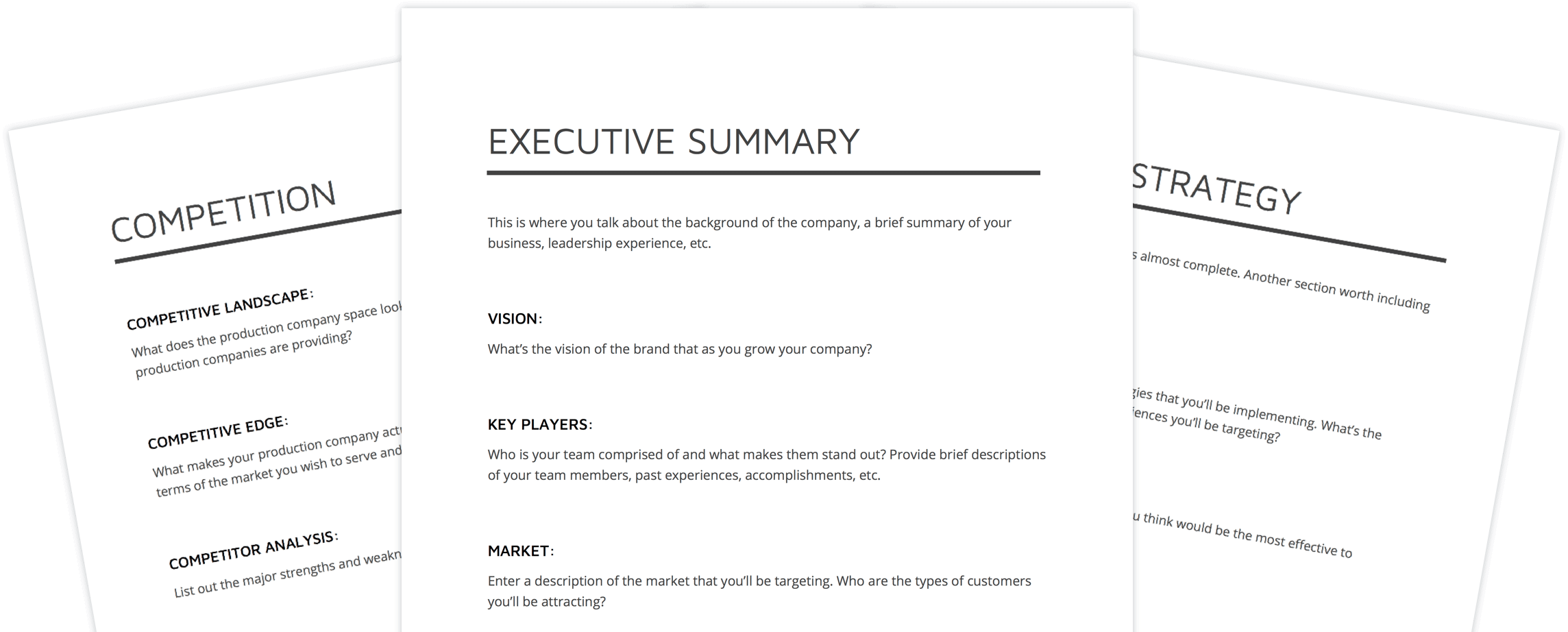
Download your FREE printable business plan template for your video production. Just enter your email address and we'll instantly send it to you!
business plan template
1. what is a production company business plan.
Essentially it's a tool for raising funds, creating a roadmap, or altering course and plotting out the next steps.
One purpose of any business plan to so convey to investors, or a bank, why they should put money into this business.

Think of creating a business plan you could bring to them
What does that mean?
It means you need this business plan for a production company to prove that you will make money. To prove it to you, but also to any investors.
After all, nobody invests to lose money. Or break even. So with that in mind, let's forge ahead into the actual writing of the business plan.
how to make a business plan
2. what is an executive summary.
Every business plan starts from the top down, with an executive summary.
What is that, exactly?
An executive summary is a short part of a larger proposal or report that summarizes the main points so the reader can become quickly educated on the whole document without having to read it all.
So it’s a detailed overview.
Of course, "executive summary" has a nice ring to it...
Your job here is to lay out the big picture of your plan. Some questions to ask yourself: Why do you want this business in the first place?
Similarly, what inspired you to start it? What's going to make it work?
Next, start to answer the questions your investors might have. Try getting into their head-space.
"Why would YOU invest in this business?"
You might want to write about the competition. The targeted demographic. Be specific here.
What need does your business fill? Which kinds of customers and clients are you targeting?
Think about your target market
Furthermore, what else sets you and your business apart?
Especially relevant is using concrete examples and not only ideas. Can you cite previous work you've done?
This brings us to...
Your production companies competition
What does the rest of the field looks like. Your investor will want to know if they don't already.
What sets this company and this production company business plan apart from others?
Knowing the entire field of competitors you have is a good idea, even if it's a very long list.
Your production company business plan must factor in what else is being offered. That way you can adjust, and target a more specific niche.
Or, you can figure out what you can do better.
For example: what can you identify in your competitor's list of services that you know you can nail?
This is what your video company plan needs to convey.
Finally, remember to think of it from the investor's standpoint. How is this an opportunity for them?
how to create a business plan
3. why a video company self-assessment.
This step is easy to do, but hard to do well.
Can you take a good long look at your video production studio? With the intent to circle problems? Areas that need improvement?
The second part of this step might be easier. Find the areas where your video production studio can really shine.
In contrast, you don't want to elaborate on weaknesses in your video production company business plan. Rather, you want to identify them so you can find ways to address them.
You need to have answers to the questions these flaws might bring to the mind of your investors.

You are not required to sing “Man in the Mirror”
Then go beyond looking in the mirror.
Look back at the field before you.
This is a business plan for a production company. What opportunities exist for that?
Most of all, try and tailor this production house business plan to specific needs.
Here are a few methods of company self-analysis:
This is a way to identify changes in your industry, to target potential growth opportunities. The acronym stands for:
P olitical Factors
E conomic Factors
S ocial Factors
T echnological Factors
P roduction company business plan would include a PEST
We've mentioned elements of SWOT:
W eaknesses
O pportunities
The one to focus in on here is threats. Don't assume everything will work out for the plan just the why you'd like it to.
Because it won't. Investors will know that. You should not only know it, you should expect it.
Most important of all: prove that you're prepared for whatever may happen.
Here's a cool way to approach your SWOT analysis. Try applying your strengths to your opportunities and see what kind of leverage you can create.
Then theoretically expose your weaknesses to your threats. Are you in trouble? Do you need to address something to better protect your company?
Think of this as planning for a battle. Therefore, you don't want to ignore cracks in the wall if your enemy is bringing a battering ram.
Business plan can benefit from SWOT
Strategy, structure, systems, style, shared values, staff, and skills. The 7S model was developed by business consultants Robert H. Waterman Jr. and Tom Peters . It's also known as the McKinsey 7S framework.
The idea here is that your business needs these elements to be aligned and "mutually reinforcing". Let's go over each "S".
Strategy: How does this business plan to gain an advantage.
Structure: How do you divide the various operations of the company.
Systems: Procedure for measurement, reward and resource allocation.
Skills: the companies core and distinctive capabilities.
Staff: Human resources.
Style: Behavior patterns of the key groups like managers.
Shared values are in the middle of them all on the diagram. It's somewhat self-explanatory.
In theory, using these methods of self-analysis will help you a great deal. Due to them you'll know, and decide, all sorts of things about your production company.
The 7 S model of analysis
Start putting these ideas onto paper now! If you haven’t already…
Gentlemen, start your engines
4. how to get started.
A business plan for a production company must lay out how you will get started. This is also referred to as a "roll out plan".
How you engineer your beginning is critical to your cash flow. What do you need to get started?
And can you start at a sustainable level?
Will you open a physical office space right off the bat?
Overhead is a major cost. If this is more of a production house business plan then you’ll want to factor that in.
Do you have existing clients?
Equipment or gear already in place?
A video production business plan suggests that your focus will be on video production. Things like equipment will be critical.
In addition to considering this an entertainment production company business plan you may also want to focus on creative development.
How you want to focus effects how you want to phrase things. And it matters almost immediately.
START FEES YOU CAN AVOID
It's a good idea to propose that you start small.
There are two reasons for this.
The first is that you will scare away investors if you ask for too much up front, almost without fail they can tell if you are asking for more than it seems like you need.
It also throws into question how serious you are about sustaining success.
Which leads to the second reason.
It'll be much harder for you to sustain success if you ask for big upfront funding that you aren't sure you can earn back plus profit.
Let's say because you know of a few jobs you'll have early on, that you ask for less up front.
You'll be able to get rolling right away, earning back the initial investments and then some.
Above all you want to start off with easy wins.
Or as close to easy wins as you can get when launching or re-launching a video production business plan.
Seems like it would somewhat obvious not to ask for more than you can earn back...
Rather, it's a mistake people make all the time.
Speaking of which...
do have the capital?
5. financing a company.
Any business needs capital. As a result, you need a section where you lay out the cash flow for the production house business plan.
What kind of money do you expect to have coming in, and how much do you expect to be spending?
Make the budget, while also estimating how you'll be earning.
If you can't demonstrate this, then you need to go back to the drawing board.

Just pose like this and you’ll reassure any investor
You will want to get involved with an accountant at some point soon.
But remember, this is a business plan for a production company. So you may have a lot of costs coming at you early just to get started.
What is a marketing plan?
Your video production business plan is almost complete. Another section worth including would be one on marketing.
Here is a good additional resource on small business accounting .
You want to prove that business will be coming in, and not assume it will on faith alone.
Building a strong portfolio is a must. Consider again what niche you may be able to serve best. Find a solid "bread and butter" to start with.
Remember, good businesses expand when they need to. They don't bite off more than they can chew right out of the gate.
INVEST IN A GOOD WEBSITE
Do some research on how you’ll be building the best website for your product.
Get your production company a few social media accounts, and start trying to create a presence there. You'll need to find many ways to attract clients, and show your work.
Do some additional research on how to market a production company.
All this needs to find its way into the marketing section of your production company business plan.
what's your daily workflow?
7. day to day operations.
The day to day operations are a critical part of the plan. Have you visualized what the daily workflow will be?
Now is the time to do that. Who is going to be on your team, and how will it grow and change over time?
Determine what tasks will take priority each day, and how to best utilize your resources and finances.
This will be a key step in determining if your production company business plan is sustainable.
Ask yourself a few of the following questions:
How much time per day will you spend building your client base? What elements of each job will you tackle in-house? Which tasks might you outsource?
What equipment and gear do you own?
When will it need to be replaced and/or upgraded?
Are you going to hire anyone to start? Will they be full-time employees?
Will you hire independent contractors per project? How many, roughly?
As mentioned in the finance section, you need to know how you'll plan your reporting for taxes and your bookkeeping process.
These questions will help you start to determine what each "day at the office" will look like.
The clearer a picture you can paint here, the better.
Write a Business Plan
Get as specific as possible in each section of your entertainment company business plan. The more you know... right?
Now, let's get a little more advanced. In our next post we'll dive into writing a 4 part business plan.
Up Next: Write a 4-Part Business Plan →
Project management for video creatives. tasks, file sharing, calendars and more..
Manage video production timelines, tasks, storyboards, shot lists, breakdowns, call sheets. Made for video creatives, new media and film.
Learn More ➜
1.1 CHAPTER TITLE HERE...
Short, actionable h3 phrase....
Marshmallow pie sweet roll gummies candy icing. I love candy canes soufflé I love jelly beans biscuit. Marshmallow pie sweet roll gummies candy icing.
- Pricing & Plans
- Product Updates
- Featured On
- StudioBinder Partners
- The Ultimate Guide to Call Sheets (with FREE Call Sheet Template)
- How to Break Down a Script (with FREE Script Breakdown Sheet)
- The Only Shot List Template You Need — with Free Download
- Managing Your Film Budget Cashflow & PO Log (Free Template)
- A Better Film Crew List Template Booking Sheet
- Best Storyboard Softwares (with free Storyboard Templates)
- Movie Magic Scheduling
- Gorilla Software
- Storyboard That
A visual medium requires visual methods. Master the art of visual storytelling with our FREE video series on directing and filmmaking techniques.
We’re in a golden age of TV writing and development. More and more people are flocking to the small screen to find daily entertainment. So how can you break put from the pack and get your idea onto the small screen? We’re here to help.
- Making It: From Pre-Production to Screen
- What is Film Distribution — The Ultimate Guide for Filmmakers
- What is a Fable — Definition, Examples & Characteristics
- Whiplash Script PDF Download — Plot, Characters and Theme
- What Is a Talking Head — Definition and Examples
- What is Blue Comedy — Definitions, Examples and Impact
- 1.2K Facebook
- 44 Pinterest
- 20 LinkedIn
- Search Search Please fill out this field.
- Building Your Business
- Becoming an Owner
- Business Plans
How To Write the Operations Plan Section of the Business Plan
Susan Ward wrote about small businesses for The Balance for 18 years. She has run an IT consulting firm and designed and presented courses on how to promote small businesses.
:max_bytes(150000):strip_icc():format(webp)/SusanWardLaptop2crop1-57aa62eb5f9b58974a12bac9.jpg)
Stage of Development Section
Production process section, the bottom line, frequently asked questions (faqs).
The operations plan is the section of your business plan that gives an overview of your workflow, supply chains, and similar aspects of your business. Any key details of how your business physically produces goods or services will be included in this section.
You need an operations plan to help others understand how you'll deliver on your promise to turn a profit. Keep reading to learn what to include in your operations plan.
Key Takeaways
- The operations plan section should include general operational details that help investors understand the physical details of your vision.
- Details in the operations plan include information about any physical plants, equipment, assets, and more.
- The operations plan can also serve as a checklist for startups; it includes a list of everything that must be done to start turning a profit.
In your business plan , the operations plan section describes the physical necessities of your business's operation, such as your physical location, facilities, and equipment. Depending on what kind of business you'll be operating, it may also include information about inventory requirements, suppliers, and a description of the manufacturing process.
Keeping focused on the bottom line will help you organize this part of the business plan.
Think of the operating plan as an outline of the capital and expense requirements your business will need to operate from day to day.
You need to do two things for the reader of your business plan in the operations section: show what you've done so far to get your business off the ground and demonstrate that you understand the manufacturing or delivery process of producing your product or service.
When you're writing this section of the operations plan, start by explaining what you've done to date to get the business operational, then follow up with an explanation of what still needs to be done. The following should be included:
Production Workflow
A high-level, step-by-step description of how your product or service will be made, identifying the problems that may occur in the production process. Follow this with a subsection titled "Risks," which outlines the potential problems that may interfere with the production process and what you're going to do to negate these risks. If any part of the production process can expose employees to hazards, describe how employees will be trained in dealing with safety issues. If hazardous materials will be used, describe how these will be safely stored, handled, and disposed.
Industry Association Memberships
Show your awareness of your industry's local, regional, or national standards and regulations by telling which industry organizations you are already a member of and which ones you plan to join. This is also an opportunity to outline what steps you've taken to comply with the laws and regulations that apply to your industry.
Supply Chains
An explanation of who your suppliers are and their prices, terms, and conditions. Describe what alternative arrangements you have made or will make if these suppliers let you down.
Quality Control
An explanation of the quality control measures that you've set up or are going to establish. For example, if you intend to pursue some form of quality control certification such as ISO 9000, describe how you will accomplish this.
While you can think of the stage of the development part of the operations plan as an overview, the production process section lays out the details of your business's day-to-day operations. Remember, your goal for writing this business plan section is to demonstrate your understanding of your product or service's manufacturing or delivery process.
When writing this section, you can use the headings below as subheadings and then provide the details in paragraph format. Leave out any topic that does not apply to your particular business.
Do an outline of your business's day-to-day operations, including your hours of operation and the days the business will be open. If the business is seasonal, be sure to say so.
The Physical Plant
Describe the type, site, and location of premises for your business. If applicable, include drawings of the building, copies of lease agreements, and recent real estate appraisals. You need to show how much the land or buildings required for your business operations are worth and tell why they're important to your proposed business.
The same goes for equipment. Besides describing the equipment necessary and how much of it you need, you also need to include its worth and cost and explain any financing arrangements.
Make a list of your assets , such as land, buildings, inventory, furniture, equipment, and vehicles. Include legal descriptions and the worth of each asset.
Special Requirements
If your business has any special requirements, such as water or power needs, ventilation, drainage, etc., provide the details in your operating plan, as well as what you've done to secure the necessary permissions.
State where you're going to get the materials you need to produce your product or service and explain what terms you've negotiated with suppliers.
Explain how long it takes to produce a unit and when you'll be able to start producing your product or service. Include factors that may affect the time frame of production and describe how you'll deal with potential challenges such as rush orders.
Explain how you'll keep track of inventory .
Feasibility
Describe any product testing, price testing, or prototype testing that you've done on your product or service.
Give details of product cost estimates.
Once you've worked through this business plan section, you'll not only have a detailed operations plan to show your readers, but you'll also have a convenient list of what needs to be done next to make your business a reality. Writing this document gives you a chance to crystalize your business ideas into a clear checklist that you can reference. As you check items off the list, use it to explain your vision to investors, partners, and others within your organization.
What is an operations plan?
An operations plan is one section of a company's business plan. This section conveys the physical requirements for your business's operations, including supply chains, workflow , and quality control processes.
What is the main difference between the operations plan and the financial plan?
The operations plan and financial plan tackle similar issues, in that they seek to explain how the business will turn a profit. The operations plan approaches this issue from a physical perspective, such as property, routes, and locations. The financial plan explains how revenue and expenses will ultimately lead to the business's success.
Want to read more content like this? Sign up for The Balance's newsletter for daily insights, analysis, and financial tips, all delivered straight to your inbox every morning!
- Contact sales
Start free trial
Production Planning in Manufacturing: Best Practices for Production Plans

As the creation of products and services has become more extensive and varied, the manufacturing industry has become more competitive. There are many things to keep an eye on such as material requirements planning, supply chain management and inventory control. Operations continue to become more complex, and this means manufacturing companies require more thorough production planning.
A production plan is the best way to guarantee you deliver high-quality products/services as efficiently as possible.
What Is Production Planning?
Production planning is the process of deciding how a product or service will be manufactured before the manufacturing process begins. In other words, it is how you plan to manage your supply chain, raw materials, employees and the physical space where the manufacturing process takes place.
Production planning is very important for manufacturers as it affects other important aspects of their business such as:
- Supply chain management
- Production scheduling
- Material requirements planning
- Production lead time
- Capacity planning
ProjectManager is a project management software that helps manufacturers cover every aspect of production planning. Plan with Gantt charts, execute with kanban boards and manage your resources along the way. No other software offers sophisticated project and resource management features in one intuitive package. Get started today for free.

Why Is Production Planning Important?
If a manufacturing operation wishes to expand, that evolution demands careful production planning and production scheduling. Someone must take on the responsibility of managing resources and deciding how they will be allocated. This process is a big part of capacity planning —how much can be made in a certain period of time, with the available resources?
Without production planning, it is easy to use too much of a resource for one product and not leave enough for another, or fail to schedule your resources properly, which results in delays that affect your overall production management process. It’s just as easy to let resources go to waste. These issues indicate a lack of efficiency in your production planning process.
Production planning is the best way to ensure resources are used appropriately, products and services are high-quality and nothing goes over budget .
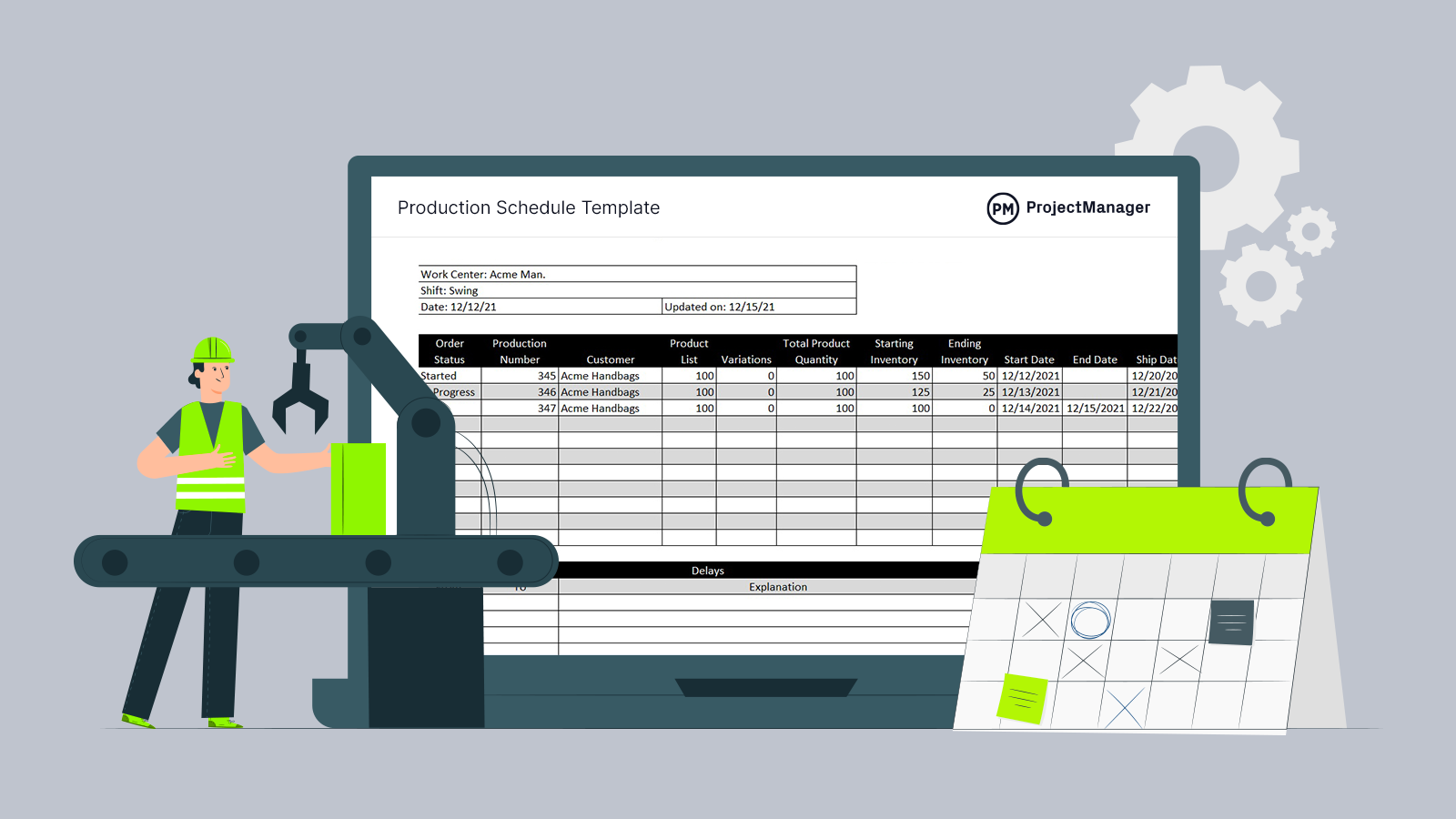
Get your free
Master Production Schedule Template
Use this free Master Production Schedule Template for Excel to manage your projects better.
Types of Production Planning
Every operation is unique, and the same production plan isn’t right for everyone. In order to get the most from project planning, you need to decide which method is best for your manufacturing process. Here’s a quick intro to the different types of production planning.
The job method is often used when manufacturing a single product, for which a unique production plan is created. This production planning method is generally used in smaller-scale productions, but it can also be applied to larger manufacturing facilities. The job method is especially advantageous when a production order requires specific customizations.
Batch Production Method
Batch production consists in manufacturing goods in groups, instead of being produced individually or through continuous production . This method is useful when manufacturing products on a large scale.
Flow Method
The flow method is a demand-based manufacturing model that minimizes the production lead time by speeding up the production line. The manufacturing process starts based on work orders, and once it starts, it doesn’t stop until all finished goods are produced. This is called continuous production and it’s achieved by using machinery and little intervention to minimize waiting time.
Process Method
The process method is more or less what most people picture when they think about production—an assembly line. With the process method, there will generally be different types of machinery completing separate tasks to put together the finished goods.
Related: 10 Free Manufacturing Templates for Excel
Mass Production Method
The mass production method is primarily focused on creating a continuous flow of identical products. It’s similar to the flow method, but at a much bigger scale, which cuts production costs. When uniformity is just as critical as efficiency, you need to use “standardized processes” to guarantee all products look exactly the same.
What Is a Production Plan?
A production plan is a document that describes how production processes will be executed, and it’s the final outcome of the production planning process. It describes the human resources, raw materials and equipment that will be needed and the production schedule that will be followed.
The person responsible for production planning must also be very familiar with the operation’s inner workings, project resources and the products/services they produce. This usually entails collaborating with people on the floor, in the field or in different departments to create products and deliver services.
- Production Schedule Template
This free production schedule template helps you keep track of the status of your production orders, starting and ending production inventories, due dates and more.
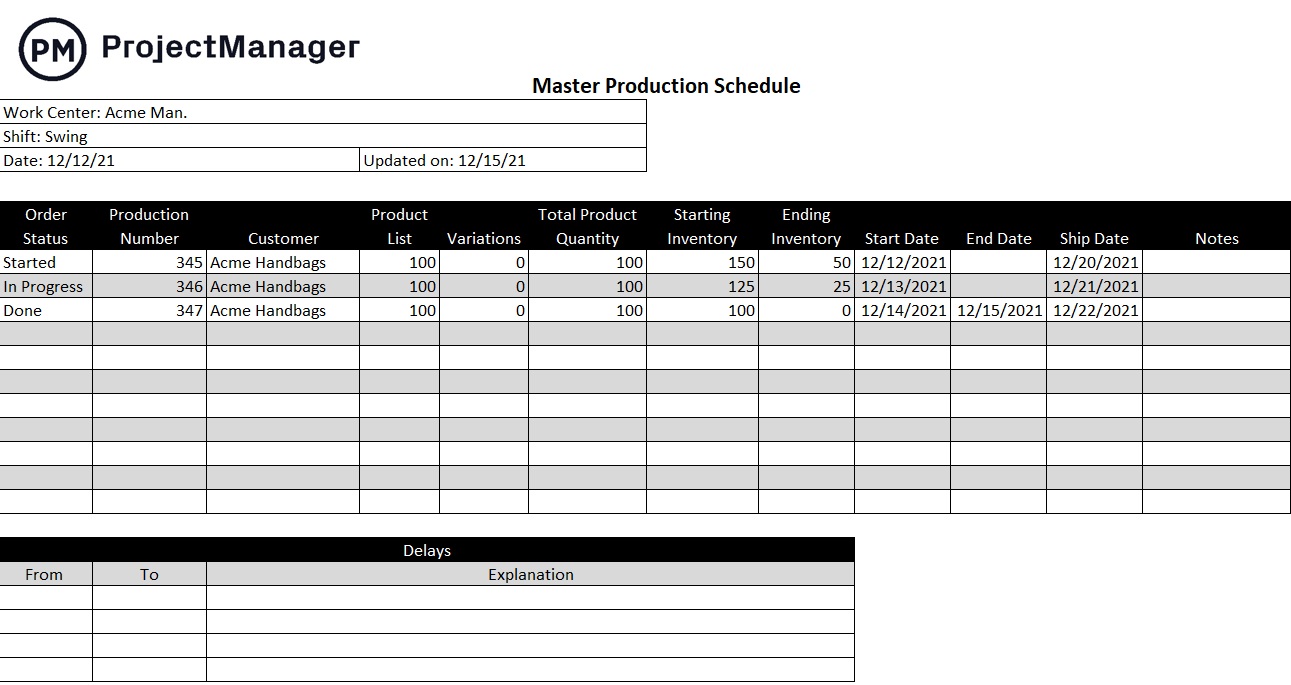
How to Make a Production Plan
When you set out to create a production plan, make sure to follow these steps to make it as robust as possible.
1. Estimate/Forecast Product Demand
Understanding product demand planning is the best way to decide which product planning method is the best choice for your operation. You’ll need to use diverse sales forecasting techniques to better understand what will be the future demand for your product. From here, you’ll be able to estimate which resources are required and how they’ll be used in the manufacturing process.
2. Access Inventory
Accessing inventory is about more than simply taking stock: you should make an inventory management plan so that you don’t experience shortages or let things go to waste. For this step, focus on the inventory control and inventory management techniques you can use to handle inventory in the most efficient way possible.
3. Create a Production Budget
A production budget is a document that’s used to calculate the number of units that should be produced by a company to meet the customer demand for a period of time such as a month, quarter or even a year.
Creating a production budget involves doing an assessment of the current product inventory, the production capacity, sales forecasts and the ending inventory that should remain at the end of the time period. Once you analyze these variables and use the production budgeting formula, you’ll know what’s the required level of production for a given time period.
4. Resource Planning
A successful production plan requires you to be familiar with the resource planning details of the manufacturing process. Note the minimum number of people and raw material requirements necessary to create a product or execute a service. You need to also consider what machines and systems are essential for executing your production plan.
Related: Free Resource Plan Template for Excel
5. Estimate Production Costs
Once you’ve determined what the required level of production is and the resources that will be needed, you’ll need to estimate the cost of production . It’s important to make sure the production process will be profitable before creating a production schedule.
6. Create a Production Schedule
Now it’s time to create a production schedule based on the sales forecasts, production capacity and production budget that you’ve outlined. Making a production schedule is key to making sure your manufacturing team delivers products on time, but also guides efforts in other areas such as supply chain management and logistics management.
7. Production control
As production takes place, monitor how the results compare to the production schedule and resource management projections. This is something that should continually take place and be documented during the production process. Production control is especially important for the fifth step in the production planning process.
8. Adjust the Plan to Make Production More Efficient in the Future
The final step of production planning is to reflect on the information you gained in step four and strategize what can be done to make the production plan run more smoothly in the future. Production planning is about manufacturing a product or service, yes, but it should also be a learning experience for creating even better production plans for next time.
Common Production Planning Mistakes
You must stay vigilant of common missteps, as you go through the production planning process. Here are three mistakes often made during production planning. Luckily, they can be prevented.
Not Expecting the Unexpected
This means having risk management strategies in place if things go awry. The goal is to never have to employ them, of course, but it’s better to have them and not need them. Production planning is not complete if it doesn’t anticipate risks, issues and changes. When you plan for them, you’re ready to problem-solve if and when they happen.
Getting Stuck Behind the Desk
You should work with intelligent production planning tools, but that doesn’t mean you should only rely on enterprise resource planning software for production planning and not oversee resources and manufacturing operations in person. When production planning is only done from behind a screen, the end result will not be as informed as it could be. The best production planning is active and collaborative.
Neglecting Equipment
In order to get the most from your equipment, you need to take care of it. This means tracking usage and keeping up with regular maintenance. This looks different depending on the industry and product or service, but the principle is the same: continually take care of your equipment before it becomes a problem that will slow down production.

Production Planning Best Practices
No matter what product or service is being manufactured, there are many tried-and-true best practices to increase your operational efficiency . When creating a production plan, keep these two in mind.
Make Accurate Forecasts
When you don’t properly estimate the demand for your product or service, it is impossible to create a detailed production plan. Demand planning is never static. You need to consider buying trends from previous years, changes in demographics, changes in resource availability and many other factors. These demand planning forecasts are the foundation of skillful production planning.
Know Your Capacity
Capacity planning means knowing the maximum capacity your operation can manage—the absolute most of a product or service it can offer during a period of time. This is the only way to anticipate how much of each resource you will need in order to create X amount of products.
When you don’t know the production capacity , your production planning is like taking a shot in the dark.
Use ProjectManager for Production Planning and Scheduling
As the nature of manufacturing goods and services changes, you need modern tools to plan production and make schedules. ProjectManager is an award-winning project management software that offers all the tools you need for excellent production planning and scheduling. With it, you can plan projects, create schedules, manage resources and track changes with one tool.
Plan with Gantt Charts
Manage your product manufacturing across a timeline with our Gantt chart view. With it, you can view your resources to help you track your cost of production to make sure you’re never overspending. You can then link any dependent tasks to avoid bottlenecks in your manufacturing.
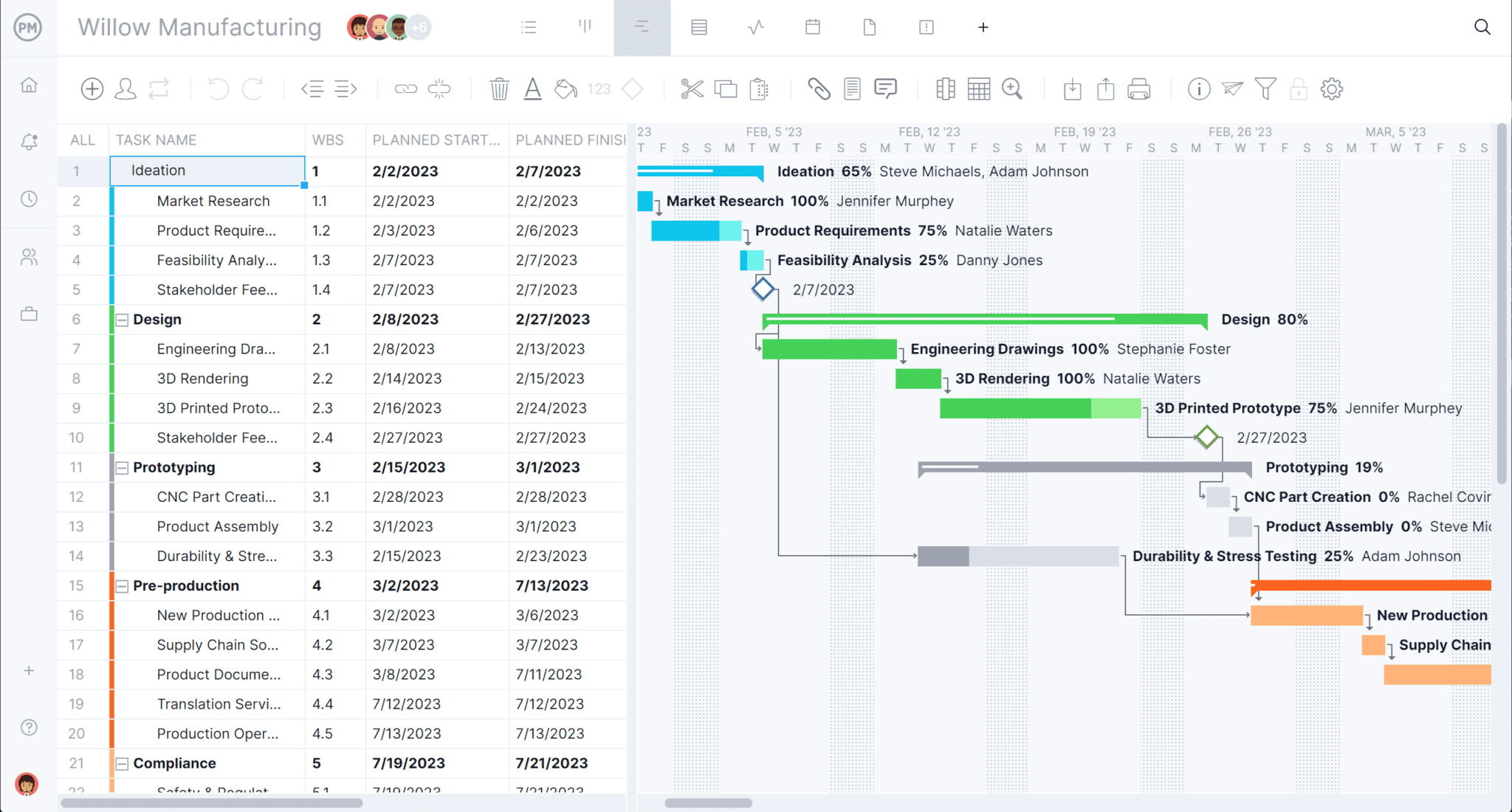
Get a Birds-Eye-View
To keep your production plan on track, you need to have a high-level view so that you can pinpoint setbacks before or as they occur. Our real-time dashboard collects your data and converts it into colorful graphs and charts that give you at-a-glance analytics.
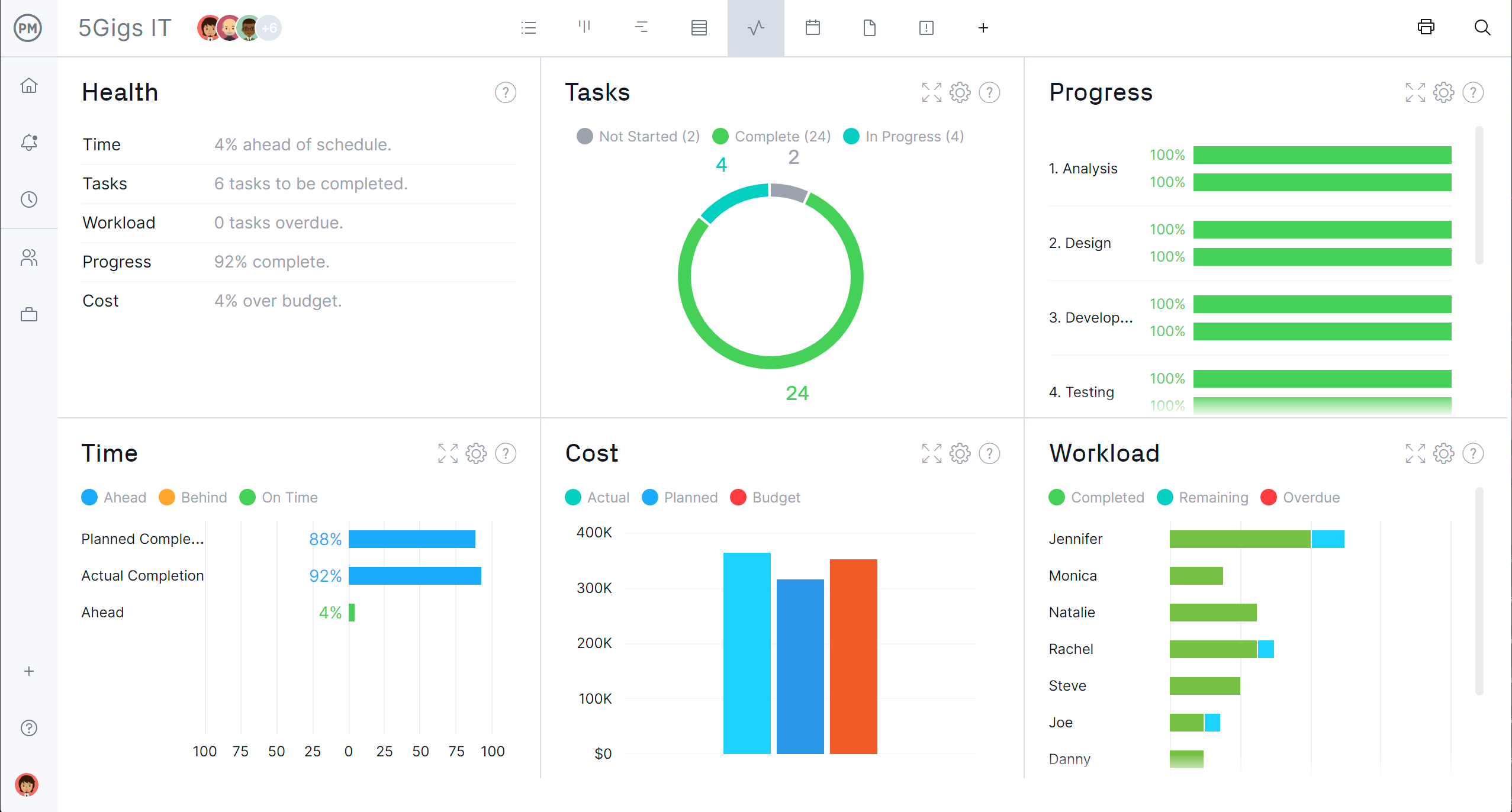
Easily Measure and Report Your Progress
Any operation will have stakeholders, and they want to be kept in the loop. ProjectManager’s project status reports make it easy to share key data points. They can be generated in a single click, making it simple to generate them before important meetings.
Related Production Planning Content
The production planning process involves many different activities such as estimating the quantity of goods to be produced, the resources that will be needed, the production schedule and much more. That’s why we’ve created dozens of blogs, guides and templates on production-related topics. Here are some of them.
- Production vs. Manufacturing
- How to Make a Production Flow Chart for Manufacturing
- Best Production Scheduling Software Rankings
- How to Create a Master Production Schedule (MPS)
Manage every detail of your operation with ProjectManager’s powerful cloud-based project management tools. Our suite of tools is trusted by tens of thousands of teams, from NASA to Volvo, to aid them in the planning, scheduling, tracking and reporting on the progress and performance of their production plans. Our software makes lets you get out from behind your desk and make adjustments on the go. Try it for yourself for free for 30 days!

Deliver your projects on time and under budget
Start planning your projects.

Item added to your cart
How to write a business plan for your production company.

Starting a production company is a great way to create and distribute content to a wide range of audiences.
It also allows for creative control over the production process, allowing for the production of unique and innovative content.
Don't start without having built a business plan though.
A business plan is essential for any new project, as it provides a roadmap to success and helps to identify potential risks. It also helps to ensure that resources are allocated appropriately and that the project is completed on time and within budget.
In short, a good business plan will help ensure the profitability of your production company .
What are the necessary elements for a business plan for a production company? How should it be organized? Which metrics should be part of the financial analysis? What's the fastest way to outline a comprehensive business plan?
Rest assured, the article you're reading will provide answers to all these questions.
One last thing: you can avoid starting your business plan from scratch.
Feel free to download our business plan for a production company and adapt it to your project.

Developing a business plan for a production company
Do you need to develop a business plan for your production company.
Yes, you need to develop a business plan for your production company.
Formulating a comprehensive business plan will allow to:
- learn about the production company market
- stay abreast of the industry's newest developments
- find key factors for success in a production company
- understand clients' project goals and creative vision to produce high-quality and captivating visual content
- come up with a unique value proposition for your production company
- study the competitive landscape
- find relevant competitive advantages for your media production firm
- find a business model that will lead to a positive bottom line
- define a bulletproof strategy to make the business grow
- evaluate risks associated with operating a production company, including production delays, equipment breakdowns, and legal compliance
Our team has created a business plan for a production company that is designed to make it easier for you to achieve all the elements listed.
How to organize a business plan for a production company?
Your business plan incorporates multiple metrics and valuable data. It should be arranged in a way that makes it simple to read and comprehend.
When we designed our business plan for a production company , we ensured it was properly organized.
The document consists of 5 sections (Opportunity, Project, Market Research, Strategy and Finances).
1. Market Opportunity
The first section is named "Market Opportunity".
In this section, you will find a comprehensive analysis of the production industry, including market trends, production methods, distribution channels, and emerging technologies, providing insights for entrepreneurs and professionals in establishing and managing successful production companies.
The data here is always kept current; we update it biannually.
2. Project Presentation
The second part is called "Project" and this is where you talk about your production company. In this section, you can outline the types of productions you specialize in (e.g., film, television, commercials), your portfolio of projects, production capabilities, creative team, and the unique value proposition that ensures high-quality productions tailored to client needs.
Also include a short description about yourself at the end of this section.
Discuss your experience in production, your range of production services, and how you plan to provide creative and professional production solutions to clients. Highlight your portfolio of successful projects, your talented team of professionals, and your dedication to delivering high-quality productions that captivate audiences and bring visions to life through your production company.
We put together language in our business plan. Adjust it to suit your idea as needed.
3. Market Research
The third part is the "Market Research" section.
This section describes the target audience for your production company.
It includes a comprehensive analysis of competitors in the production industry and emphasizes your company's unique production services and competitive advantages.
A tailored SWOT analysis is provided as well.
4. Strategy
In the "Strategy" section, you will find a detailed growth plan for your production company, outlining all the necessary steps and initiatives to ensure its high profitability.
Furthermore, there is a marketing strategy for a production company, a way to manage risks, and a completed Business Model Canvas included in this section.
5. Finances
Ultimately, the "Finances" section serves as a platform to present the financial aspects of your project.

How to elaborate an Executive Summary for a production company?
The Executive Summary gives a summarized glimpse into the business plan of your production company.
Don't go beyond 2 pages; concentrate on the crucial information.
This document is meant to make the reader curious to know more about your business plan.
In the Executive Summary of your production company, address the following queries: what services does your production company offer? who is your target market? who are your competitors in the industry? how do you differentiate from them? what is your budget?
How to do the market analysis for a production company?
Conducting a market study for your production company enables you to grasp external factors like customer demands for specific media content, competition within the entertainment industry, and emerging trends in production techniques.
By conducting an extensive market analysis, a production company can understand client production needs, offer professional production services, optimize pricing strategies, and execute targeted marketing campaigns, ultimately leading to a larger client base, increased project contracts, and a prominent position in the production industry.
Here's what we've incorporated into the "Market Research" section of our business plan for a production company :
- fresh and updated data and statistics about production companies, including production industry revenue, film and TV production trends, and distribution methods
- a compilation of potential customer segments for a production company
- the competitor analysis
- the competitive advantages for a production company

The key points of the business plan for a production company
What's the business model of a production company, business model of a production company.
A production company's business model revolves around creating and producing various forms of media content such as films, television shows, commercials, or digital content. Revenue is generated through content production contracts, licensing deals, or advertising partnerships.
The business model focuses on identifying market demands, developing compelling content concepts, securing funding or investments, assembling talented production teams, managing production logistics, and distributing or monetizing content through various platforms.
Success depends on industry connections, delivering high-quality content, effective marketing and distribution strategies, fostering creative collaborations, and staying adaptable to evolving media consumption trends and technologies.
Business model ≠ Business plan
It's important to understand the distinction between "business plan" and "business model."
A business model defines how a company creates, delivers, and monetizes its offerings.
In a business plan, you make use of the Business Model Canvas as an easy-to-understand tool to depict how your business operates.
Rest assured, we provide a Business Model Canvas in our business plan for a production company .
How do you identify the market segments of a production company?
Market segmentation for your production company involves dividing your potential clients into different groups based on their media production needs, industries, and preferences.
These categories may include factors such as film production, commercial production, music video production, or clients seeking specific production services (e.g., scriptwriting, cinematography, editing).
By segmenting your market, you can offer specialized production services and solutions that cater to each segment's specific requirements. For example, you might provide film production services for independent filmmakers or production companies, offer commercial production services for businesses and advertising agencies looking to create compelling commercials or promotional videos, specialize in music video production and provide creative and visually stunning music videos for musicians and record labels, or focus on specific production services such as scriptwriting, cinematography, or editing.
Market segmentation allows you to effectively target your marketing efforts, communicate your expertise in media production, and deliver high-quality and captivating production experiences that meet the unique needs and preferences of each client segment.
In the business plan for a production company , you will find a detailed market segmentation that gives you insights into your potential customers.
How to conduct a competitor analysis for a production company?
Without surprise, you won't be the only production company in your market. There will be other companies offering film, video, or media production services to clients.
It is vital to study your competitors' strengths and weaknesses in detail when constructing your business plan.
Identify their weaknesses (such as inadequate production equipment, inconsistent project delivery, or poor client communication).
Why should you pay attention to these points? Because these weaknesses can impact the efficiency and effectiveness of production companies. By addressing these aspects, you can offer professional and reliable production services, provide state-of-the-art equipment and technology, and deliver excellent project management and client communication, positioning your production company as a trusted and preferred partner for creating high-quality and impactful audiovisual content.
It's what we call competitive advantages—invest in them to make your business unique.
Here are some examples of competitive advantages for an audiovisual production agency: creative and innovative content creation, professional equipment and editing, timely delivery.
How to draft a SWOT analysis for an audiovisual production agency?
A SWOT analysis can help identify the strengths, weaknesses, opportunities, and threats of starting a production company, allowing for informed decisions to be made.
As you can guess, there is indeed a completed and editable SWOT matrix in our business plan for a production company
The strengths for a production company
The "S" in SWOT denotes Strengths, which are the project's areas or aspects that provide a competitive advantage.
For a production company, strengths could include having experienced personnel, access to cutting-edge technology, strong financial resources, and a robust portfolio of past projects.
The weaknesses for a production company
When we mention the "W," we're referring to Weaknesses, which are the weak areas or aspects of the project that need to be improved.
For a production company, potential weaknesses include inadequate capital, lack of resources, insufficient marketing, and inadequate planning.
The opportunities for a production company
The "O" in SWOT symbolizes Opportunities, highlighting the potential advantages or positive factors that can benefit the project.
In the case of a production company, potential opportunities include creating web content, filming commercials, producing television shows, and creating music videos.
The threats for a production company
The "T" in SWOT symbolizes Threats, indicating the potential risks or unfavorable conditions that the project needs to mitigate.
How to outline a marketing strategy for an audiovisual production agency?
A marketing strategy is a vital component of a business plan as it specifies how a business will draw in customers and generate income.
Developing an effective marketing plan will help your production company gain visibility and appeal to clients seeking high-quality video and media production services.
Clients won't choose your audiovisual production agency without proper promotion; highlighting your creative capabilities and successful projects is necessary.
Have you considered marketing techniques to attract clients to your production company? Consider showcasing your portfolio of past projects, attending industry events or film festivals, and utilizing social media platforms to engage with potential clients and collaborators.
No need to worry if you're clueless about marketing and communication – it's not a big deal.
How to build a solid financial plan for an audiovisual production agency?
A successful business plan requires comprehensive financial data in order to accurately forecast future performance.
As part of your business plan, it will be necessary to forecast the revenue for your production company.
The presence of a relevant and credible revenue forecast is crucial to give your business plan a strong appeal to banks or investors.
Our financial plan for a production company is straightforward and equipped with automated checks, enabling you to validate and adjust your assumptions easily. This way, we make sure you're building solid financial projections.
Without a doubt, you'll need to come up with a basic budget for starting your production company. Don't forget any expense (we have listed them all in our financial plan !).
The break-even analysis is a crucial tool in your financial plan, providing insight into whether your production company will be profitable or not.
- Choosing a selection results in a full page refresh.
- Opens in a new window.
What Is Production Planning & Why Is It Important?

Business success often hinges on making the products that customers want in a timely and cost-effective way. Production planning helps companies achieve those goals. It maps out all the processes, resources and steps involved in production, from forecasting demand to determining the raw materials, labor and equipment needed. Production planning helps companies build realistic production schedules, ensure production processes run smoothly and efficiently, and adjust operations when problems occur.
What Is a Production Plan?
A production plan describes in detail how a company’s products and services will be manufactured. It spells out the production targets, required resources, processes and overall schedule. The plan also maps all of the operational steps involved and their dependencies. The goal is to design the most efficient way to make and deliver the company’s products at the desired level of quality. A well-designed production plan can help companies increase output and save money by developing a smoother workflow and reducing waste.
What Is Production Planning?
Production planning involves developing a comprehensive strategy for making the company’s products and services. Initially adopted by large manufacturers, production planning has since become more popular among small and midsize businesses in multiple industries — largely because technology has made it easier to plan and track production processes with less effort. Production planning covers many different aspects of production, from forecasting demand to determining the raw materials, workforce, equipment and steps needed to make the company’s products.
Production Planning vs. Production Scheduling
While production planning provides an overview of what the company plans to do, production scheduling creates a more detailed view of exactly how the company will do it. The production schedule describes when each step in the production plan will occur, as well as the workers, machinery and other specific resources assigned to the job. Production scheduling can be extremely complex, especially when there are many interdependent production steps and the company is making multiple products simultaneously. Production scheduling software (opens in new tab) can help businesses create complex schedules, monitor progress in real time and quickly make adjustments when necessary.
Key Takeaways
- Production planning describes in detail how a company’s products and services will be manufactured.
- A production plan defines the production targets, required resources and overall schedule, together with all the steps involved in production and their dependencies.
- A well-designed production plan helps companies deliver products on time, reduce costs and respond to problems.
- Technology has made it easier for small and midsize companies in multiple industries to use production planning to optimize operations.
Product Planning Explained
Production planning is a broad discipline that involves much more than a focus on manufacturing process efficiency. It is intertwined with nearly every other aspect of the business, including finance, sales, inventory and human resources. Production planning activities include demand forecasting to determine the right mix of products to meet customer needs, as well as selecting the optimal approach to building those products. Production planning also assesses the resources needed to meet production goals and lays out in detail all the operations in the production process. Production plans must include the flexibility to make operational adjustments when problems occur — such as machine breakdowns, staffing shortages and supply-chain problems.
Why Is Production Planning Important?
A well-constructed production plan can help to boost revenue, profit and customer satisfaction, while a poorly designed plan can cause production problems and perhaps even sink the company. Specific benefits of production planning include:
- Knowledge. A production plan provides a framework for understanding the resources and production steps required to meet customer needs. It also helps companies understand the potential problems that may occur during production and how to mitigate them.
- Efficiency. Detailed production planning reduces bottlenecks and helps minimize costs. It also helps ensure the high quality of a product, and it keeps expenses on budget.
- Customer satisfaction. Production planning helps ensure that the company can make and deliver products to customers on time, leading to higher customer satisfaction and a greater likelihood of repeat business.
Types of Production Planning
The design of a product plan depends on the production method that the company uses, as well as other factors, such as product type, equipment capabilities and order size. Here are three of the main types of production planning:
Batch production planning.
Refers to manufacturing identical items in groups rather than one at a time or in a continuous process. For some businesses, batch production can greatly increase efficiency. A bakery creating items for sale the next day might first make a batch of chocolate chip cookies, then move on to oatmeal raisin cookies followed by loaves of semolina bread. A clothing manufacturer making goods for the summer might first set up its cutting and sewing machines to make 500 navy-blue T-shirts, then switch to red fabric and thread to make 400 tank tops. A good production plan for batch processing should look out for potential bottlenecks or delays when switching between batches.
Job- or project-based planning.
Used by many small- and medium-sized businesses, job production planning focuses on the creation of a single item by one person or team. Job-based planning is typically used where the specificity of each client’s requirements means it is difficult to make products in bulk. Many construction businesses use this method. Makers of custom jewelry and dresses are other examples of businesses that may use job production planning.
Flow production planning.
In flow production, also known as continuous production, standardized items are continuously mass-produced on an assembly line. Large manufacturers use this method to create a constant stream of finished goods. During production, each item should move seamlessly from one step along the assembly line to the next. Flow production is most effective at reducing costs and delays when there’s steady demand for the company’s products. Manufacturers can then readily determine their needs for equipment, materials and labor at each stage along the assembly line to help streamline production and avoid delays. The automotive industry and makers of canned foods and drinks are among the companies that use this method.
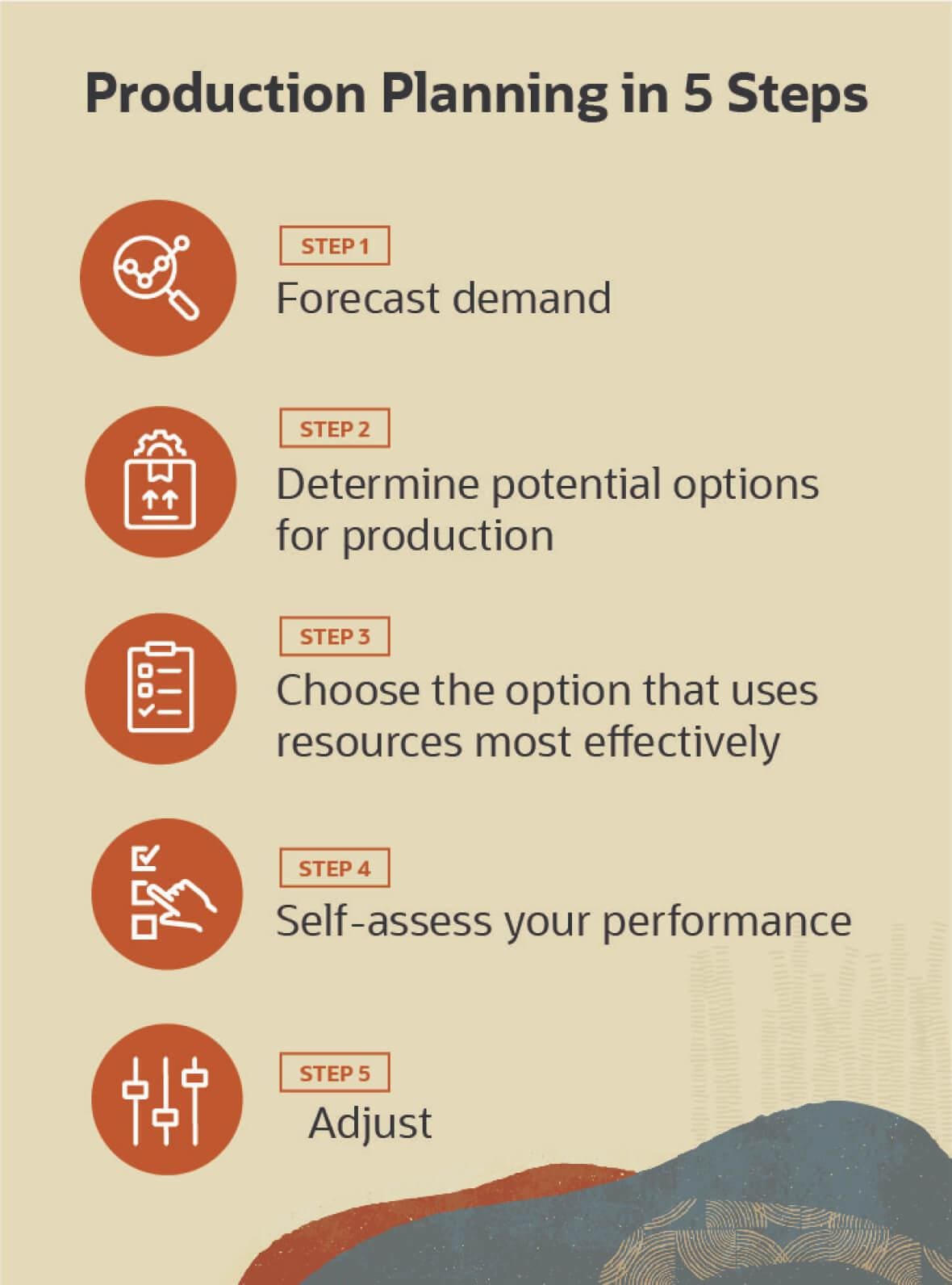
5 Steps to Make a Production Plan
Production planning is a robust undertaking that starts with forecasting and includes process design and monitoring. Here are five typical production planning steps:
Forecast product demand.
Estimate how much of each product you’ll need to produce over a designated period. Historical data can help with forecasting, but you’ll also need to pay attention to other factors that can affect demand, such as market trends and the economic situation for your customer base. Demand planning software can help companies make more informed decisions about the right amount of product needed to meet demand.
Map out production steps and options.
This step determines the processes, steps and resources needed to produce the required output. At this stage, the company may also examine different options for achieving its production goals, such as outsourcing some stages. The production mapping identifies which steps are interdependent and which can be performed simultaneously. Let’s say the job is to produce 1,000 children’s bicycles. Manufacturing the bicycle frames consists of a series of steps that must happen in sequence — cutting metal tubes, welding and painting — while other activities like assembling wheels can occur in parallel. Do you have all the right equipment? What happens if a machine breaks down? Are your suppliers able to meet your demand?
Choose a plan and schedule production.
Select a production plan after comparing the cost, time required and risks for each option. Sharing the selected plan with all necessary stakeholders typically helps assure a smoother production process since all the stakeholders are aware of what’s needed. Create a detailed production schedule that lays out in detail how the company will execute the plan, including the resources and timing for each step.
Monitor and control.
Once production has begun, you’ll need to track performance and continually compare it against the targets described in the production plan. Careful monitoring helps the company to detect any issues as soon as they pop up, so they can be quickly addressed.
Adjust accordingly.
It’s almost inevitable that production will be affected by events that you can’t plan for or predict. Those events can include changes to client specifications, supply chain lags, equipment failures and worker illness. You may also see ways to improve the production plan after seeing it in action for a while. So it’s vital to keep production plans flexible enough to allow for adjustment when needed. Football coaches often make adjustments to their game strategy at halftime — and the same holds true for production planning.
3 Common Product Planning Mistakes
Being aware of potential pitfalls ahead of time can help companies avoid or mitigate problems once production has started. Here are three of the most common production planning mistakes.
Not anticipating hiccups along the way.
In any complex production process, plans can go awry. Production planning should therefore include risk management strategies, including backup plans companies can rely on in the event of problems. Failing to do so can result in serious problems. For example, if a machine breaks on the line and you didn’t budget for repairs and workforce overtime, the issue may strain the company’s financial resources.
Keeping your distance.
Though production management software can provide real-time visibility into a company’s production status, it’s a good idea to supplement that information with in-person visits to the production line. Those visits can provide valuable insights into how production works in practice — insights that you might not gain if you’re stuck behind a desk.
Failing to maintain equipment.
There’s a tradition in football that the quarterback buys presents for his offensive linemen at the end of each season. Why? Because they protect him and enable him to do his job. Your manufacturing equipment is your company’s offensive line, so don’t neglect it. Tracking usage and paying for regular preventive maintenance helps ensure that your machines can keep your business functioning.
Production Planning KPIs
Key performance indicators (KPIs) are important metrics that help companies track the health of their production processes. By monitoring KPIs and comparing them to target values defined in production plans, businesses can determine whether production is on track and pinpoint problems that need to be addressed. Typical production KPIs include:
This key efficiency metric tracks the percentage of time that production is not occurring during scheduled operating hours. Causes include machine breakdowns, tool adjustments and accidents. Some downtime may be necessary for functions such as machine maintenance, but generally, the less downtime the better.
Setup time.
Also referred to as changeover time, this is the amount of time it takes to switch between jobs. Setup time impacts overall productivity because production is halted during these periods. Production schedules should consider how much time and effort it takes to reconfigure production for each job, including changes to the equipment, raw materials and workforce. Designing production schedules to minimize changeover time can increase efficiency.
Production rate.
In a manufacturing environment, this is typically measured as the number of units produced during a specific period. Comparing the actual production rate for each process with the planned rate can help businesses identify strengths and weaknesses and begin to address problems.
Overall equipment effectiveness (OEE).
This is a measure of overall manufacturing productivity that accounts for quality, performance and availability. The formula for OEE is:
OEE = Quality x performance x availability
Quality is typically measured as the percentage of parts that meet quality standards. Performance is how fast a process is running compared to its maximum speed, which is expressed as a percentage. Availability is the percentage of uptime during a company’s scheduled operating hours. Increasing OEE can be achieved by lowering downtime, reducing waste and maintaining a high production rate.
Rejection rate.
This is the number or percentage of products that failed to pass quality checks. Depending on the nature of the product and the problem, it may be possible to salvage some rejected items by reworking them, while others may need to be scrapped.
On-time orders.
Production delays can be costly both in terms of money and reputation. Generating products on schedule means you’re less likely to need costly expedited shipping or other emergency measures to meet deadlines. And delivering orders on time helps keep customers happy, which means they’re more likely to keep doing business with your company.
Production Planning Tools
Businesses rely on a variety of tools to build production plans and track progress, ranging from visualization tools to sophisticated software that automates many of the steps involved. Typical tools include:
Gantt charts.
A Gantt chart is a detailed visual timeline of all the tasks scheduled for a particular job. More than 100 years since its invention by mechanical engineer Henry Laurence Gantt, this chart remains integral to manufacturing and many other industries. Production planning involves coordinating and scheduling many tasks , and the Gantt chart visually represents when each task will take place and how long it will last. Manually creating and updating Gantt charts to reflect complex, ever-changing production schedules can be a time-consuming and error-prone job, however.
Spreadsheets.
Small companies sometimes start out by tracking simple production plans using spreadsheets. However, for most companies, the inherent complexity of production planning quickly outstrips the capabilities of spreadsheet software.
Production planning software.
Production planning involves a wide range of activities, including forecasting, managing the supply chain, tracking inventory and scheduling jobs. Those activities require information from across the company and beyond. Production planning information is integral to business operations and is used by other groups within the company, including finance. That’s a key reason many companies use enterprise resource planning (ERP) application suites that include production planning software and provide a single solution for managing the entire business.
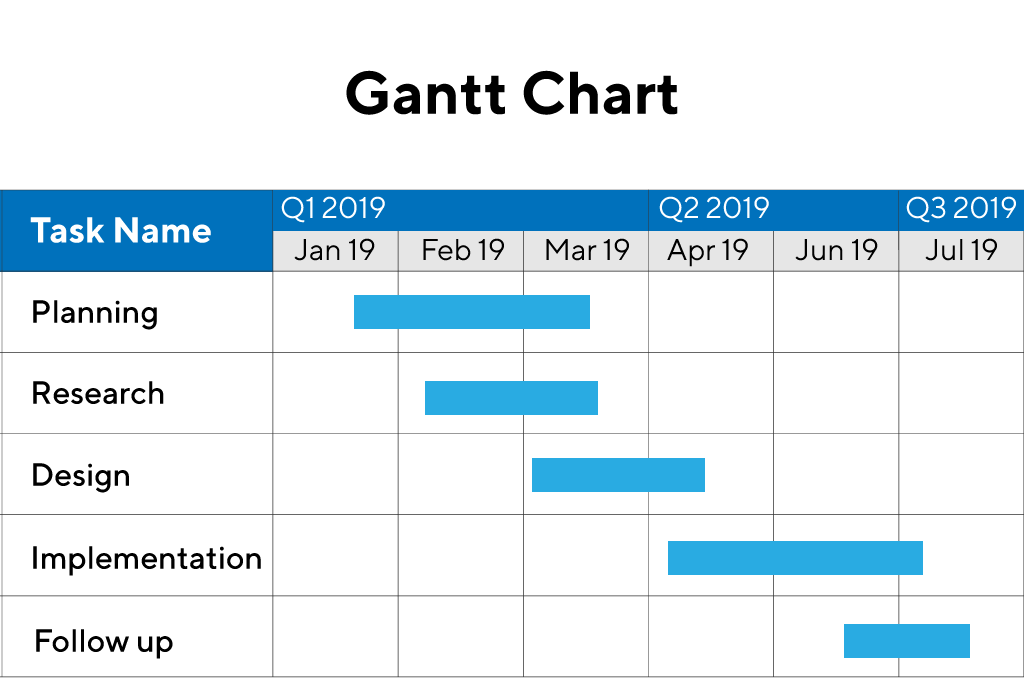
Manage and Optimize Production With NetSuite
NetSuite cloud-based production management software helps companies maximize manufacturing productivity and minimize cost. NetSuite provides real-time visibility into each aspect of the production process, from inventory tracking and monitoring the production floor to fulfilling orders. Production scheduling capabilities let businesses create and update complex real-time production schedules with minimal effort. Because NetSuite production management software is part of an integrated suite of ERP applications , businesses can share production progress with the entire organization and link production processes to financial reports, inventory management and order management.
Production planning is an important function that can boost profitability and customer satisfaction as well as efficiency. It helps companies match output to demand, optimize production processes and determine how to overcome production problems.
Award Winning Cloud Inventory
Production Planning FAQs
What are the 5 steps in production planning.
Here are five typical steps in the production planning process:
- Forecast the short- and long-term demand for your product.
- Map out the various options and processes for manufacturing these goods
- Choose the option that checks as many boxes as possible, and develop a production schedule.
- Monitor production against the plan.
- Adjust the plan where needed. In other words, if it’s broken, fix it.
What are the 3 activities of production planning?
Production planning activities can be divided into three main areas: Develop a production process and strategy; gather the resources needed, from raw materials to machinery and personnel; and select and train the necessary people.
What are the types of production planning?
Three of the main types of production planning are batch planning, job planning and flow or continuous planning . The choice depends on your resources as well as the nature of the product. Batch planning makes the same item in bulk before moving on to another item. Job planning, also called project-based planning, focuses more on custom design and single-item production. Flow production involves a steady stream of mass-produced items moving along the line.
What is the role of production planning?
Production planning is critical to ensure the production process runs smoothly and efficiently and delivers products on time. Planning allows a business to make certain that all necessary preparation is completed before starting production.
Inventory Management

What Is Perishable Inventory? Strategies, Tracking & Free Template
Inventory management is a challenge faced by any business selling a product, but the challenge is particularly acute for businesses dealing in products that expire or quickly lose value over time. By giving special attention…

Trending Articles

Learn How NetSuite Can Streamline Your Business
NetSuite has packaged the experience gained from tens of thousands of worldwide deployments over two decades into a set of leading practices that pave a clear path to success and are proven to deliver rapid business value. With NetSuite, you go live in a predictable timeframe — smart, stepped implementations begin with sales and span the entire customer lifecycle, so there’s continuity from sales to services to support.
Before you go...
Discover the products that 37,000+ customers depend on to fuel their growth.
Before you go. Talk with our team or check out these resources.
Want to set up a chat later? Let us do the lifting.
NetSuite ERP
Explore what NetSuite ERP can do for you.
Business Guide
Complete Guide to Cloud ERP Implementation
Don't bother with copy and paste.
Get this complete sample business plan as a free text document.
Brewery Business Plan
Start your own brewery business plan
Sedibeng Breweries
Executive summary executive summary is a brief introduction to your business plan. it describes your business, the problem that it solves, your target market, and financial highlights.">.
Sedibeng Breweries is a medium-scale brewery that is located in the growing industrial centre of Selebi Phikwe, Botswana. This is a relatively new business in its start-up phase having been incorporated recently.
We are on the brink of penetrating a lucrative market in a rapidly-growing economy. The current trend towards an increase in the number of entrepreneurs and competition amongst existing companies presents an opportunity for Sedibeng Breweries to penetrate the market. Our products will be positioned very carefully. They will be of extremely high quality to ensure customer satisfaction, supported by impeccable service to our customers. Our primary goal will be to establish and strengthen our license to trade, which will be bestowed by the communities in which we function. As Sedibeng Breweries prospers and grows, these communities will continue to benefit from both the value created by Sedibeng Breweries and its behavior as a corporate citizen.
Initial plans are to produce three main lines of products primarily focusing on X, Y, and Z beer (which comes in different flavors: B, P, C and S). These products will be sold in different sized containers ranging from the 250 ml ginger beer to the 500 ml traditional beer. These products shall be extensively distributed to remote, yet extremely viable areas where the market is appreciative of readily available, good quality brew.
To prosper there is need for Sedibeng to be flexible and responsive, to delight customers by providing them with what they want, when they want it and before the competition. From product concept to goods dispatch we intend to ensure that every policy and procedure, system and process must have the objective of improving the flexibility and response of the whole company. There is a need for interaction between all functional areas, particularly between marketing and manufacturing, if the organization is to realize its full potential, with manufacturing being employed as a strategic weapon.
Our marketing strategy will be based mainly on ensuring customers know what need the product(s) is able to fulfill, and making the right product and information available to the right target customer. Hence we intend to implement a market penetration strategy that will ensure that we are well known and respected in our respective industry. We will ensure that our products’ prices take into consideration people’s budgets, and that these people appreciate the product(s) and know that it exists, including where to find it. However these prices will also take into consideration the cost of production and distribution so as to ensure that we remain viable and operational. The marketing effort will convey the sense of quality and satisfaction in every picture, every promotion, and every publication. Our promotional strategy will involve integrating advertising, events, personal selling, public relations and direct marketing. In the long term Internet marketing shall also be undertaken, details of which are provided in the marketing section of the following plan.
Our target markets will primarily constitute the corporate and working class who appreciate good quality traditional beer. The working class will range from the miners, who constitute a large portion of the market, to administrative personnel appreciative of good quality traditional beer. The corporate or managerial segment will constitute those managers, who though aware of their image and reputation, want to put aside their ties and jackets after hours and/or on weekends to drink good traditional beer, easily accessible in the urban areas. The common bond will be the appreciation of a good-quality traditional brew able to fulfill their thirst. Sedibeng is primarily targeting a market share of 6% to attain sales of approximately $1.5 million in our initial year. Sedibeng Breweries will pride itself on its production ability, competitive prices, its high standards of quality and its adaptability to changes in the market and in the method of its practice.
It is important to recognize that we do not intend that our tangible resources alone will make us potent competitors but more so our intangibles, such as our ability to relate to consumers, management style, corporate culture and commitment. These elements will differentiate us from our competitors and contribute towards the development of a sustainable competitive advantage.
We intend to compensate our personnel well, so as to retain their invaluable expertise and to ensure job satisfaction and enrichment through delegation of authority. Our compensation will include health care, generous profit sharing, plus a minimum of three weeks vacation. As an equal opportunity employer, we respect the diversity and human rights of our people, and strive to achieve optimal productivity, while realizing each employee’s full potential. Awards will be given out to outstanding individuals, groups and plants for hard work and production so as to instill a sense of fun and promote the maintenance of high standards. By encouraging all employees close to our customers to think tactically about what Sedibeng Breweries service offerings should be, and by having enthusiastic, capable and empowered people interacting with our customers, we build the competitive advantage of being able to meet our customers’ needs better than anyone else.
Sedibeng Breweries intends to provide the customer with more than just a traditional brew. We intend to provide a quality brew that will not only be refreshing and pleasurable, but also encourage gatherings and sharing of fun. Our customers are assured of products that have been produced using the highest quality standards.
As we grow we want to grow right. Initially pursuing organic development and expansion we intend to undertake vertical integration in the future so as to be in total control of our raw materials and goods dispatch. For example, we realizing that we have to be in constant touch with our stakeholders to ensure market knowledge at all times. This is the nature of the channels we deal with. Also, we intend to build our management team correctly. We need the right people, in the right place, at the right time if we are to ensure optimum growth. We intend to develop our team so that our people can grow as the company grows– a mutually beneficial relationship. We shall strive to attain our primary goal, which is to develop and strengthen our license to trade, bestowed by the communities in which we function. As Sedibeng Breweries prospers and grows, these communities will continue to benefit from both the value created by Sedibeng and its behavior as a corporate citizen.

1.1 Objectives
Our business strategy will revolve around the need to provide quality brew to our various target customers, in the process fully satisfying their needs. This shall be undertaken through the implementation of high quality control standards and technological innovations, as well as the recruitment of a professional production and sales team, and the production of good quality marketing material designed to cater for various kinds of customers. This marketing material shall be professionally done so as to be reflective of our intended image and reputation. We shall position ourselves as a quality manufacturer that strives to provide quench fulfillment, enjoyment, reliability and a good image. We intend to establish a good rapport with all the relevant stakeholders.
With time we intend to establish our presence on the World Wide Web, which will increase the knowledge of our products to the various market segments we shall be targeting. Web presence is a natural objective in reaching the appropriate potential customers. Well-done brochures, company profiles and business cards often has a triggering effect on clients contemplating on ordering our products. Hence this will undoubtedly generate increased sales of our products.
Our objectives will revolve around the following guiding principles:
- Provision of a great work environment, treating each other with respect and dignity.
- Apply high-quality standards of excellence to all business processes.
- Develop enthusiastically-satisfied customers all of the time.
- Contribute positively to our communities and our environment.
- To continuously formalize and measure cross-functional working communication so as to ensure that the various departments work harmoniously towards attainment of company objectives.
- To instill a culture of continuous improvement in beating standards of customer satisfaction and efficiency.
- Fully commit to supporting growth and development in the economy.
Ultimately we intend to create a stable business platform that will create prosperity for all those involved in the business venture at all levels, and to uplift unemployed Botswanans who are prepared to participate in this venture.
1.2 Keys to Success
The keys to Sedibeng Breweries success will undoubtedly be effective market segmentation through identification of several niche markets and implementation strategies. Along these lines the company intends to implement advertising, personal selling and direct marketing strategies aimed at the target markets. Our advertising marketing strategies will rotate around.
Hence our key success factors will include the following:
Excellence in Fulfilling the Promise: We intend to produce and provide products of uncompromised quality to our customers. This is so as to meet the needs and standards of our customers. Effective and Efficient Distribution Network: The importance of such cannot be overemphasized in our line of business. We intend to establish an excellent distribution network that will enable us to rapidly respond to customers’ orders, and be available in remote areas our competitor has not yet exploited. Assembly Technology: To ensure quality brewed beverages it is essential to utilize the latest and most efficient assembly technology. Keeping abreast with technological developments will ensure we gain, and maintain, a competitive advantage utilizing the latest production techniques. Loyalty and Dedication: The loyalty and dedication of our employees shall be essential to the prosperity of the organization. We recognize that Corporate commitment to success should lead to the survival and prosperity of the products, and ultimately the organization as a whole. Marketing Know-how: In an increasingly competitive market there is need to aggressively market our business so as to be continuously at the top of our prospective and current client’s minds. Adherence to Stringent Values and Principles: Sedibeng needs to acknowledge the fact that the financial and strategic management of the business will ultimately determine its prosperity and success. Hence we intend to adhere to stringent values and principles that will enable such to be achieved.
1.3 Mission
Sedibeng Breweries intends to create a pleasant, enjoyable and sociable environment through the provision of refreshing high-quality brews. Hence we intend to assist in the creation of a welcoming and relaxed ambiance reflective of people enjoying themselves. We are sensitive to the taste, look and feel of good beer, as well as affordable prices depending on the market. We intend to provide the best possible value to our customers who care about quality products at affordable prices, and we want every dollar spent on our products to be well spent. Hence our value proposition is to sell the benefit of refreshness and enjoyment to our various consumers at reasonable prices.
Internally we intend to create and nurture a healthy, creative, respectful and enjoyable office and plant environment, in which our employees are fairly compensated and encouraged to respect the customer and the quality of the product we produce. In addition follow-up will be mandatory so as to ensure customer satisfaction and make any improvements as recommended by the customers in future. We seek a fair and responsible profit, enough to keep the company financially healthy for the short and long term, and to fairly compensate owners and investors for the money and risk.
We also intend to obtain ISO 9000 certification from the South African Bureau of Standards (SABS) so that our products are internationally recognized and approved. This will assist in our penetrating the regional and international markets, intentions of which we have in future. However this will occur after we have established ourselves on the local market. The above is well summarized in our mission statement which goes as follows:
Our mission is to carefully attend to detail in the hygiene in all our brews, and to uphold superb quality at all levels of production. To satisfy all our customers and stakeholders.
Company Summary company overview ) is an overview of the most important points about your company—your history, management team, location, mission statement and legal structure.">
Sedibeng Breweries is a relatively new company providing high quality alcoholic and non-alcoholic beverages in the local market. Sedibeng Breweries intends to focus on the brewing process and the brewery itself. The brewery will house four stainless steel vessels whose shiny finish will be highlighted by the flood lights on the ceiling. Interested stakeholders will be able to observe the brewing process during the day and will be offered guided educational tours of the brewing facility.
It will focus initially on providing and satisfying two kinds of markets:
- Working Class: This will range from the miners who constitute a large portion of the market to administrative personnel appreciative of good quality traditional beer.
As it grows it will take on people and expand into related markets. It will also look for additional leverage by establishing relationships and representations with appropriate strategic allies.
2.1 Start-up Summary
Total start-up capital and expenses (including legal costs, logo design, stationery and related expenses) came to approximately $41,700. Start-up assets required and utilized included brewing plant and machinery, pick-ups, office furniture, personal computers and other office equipment. This figure comes to $840,000.
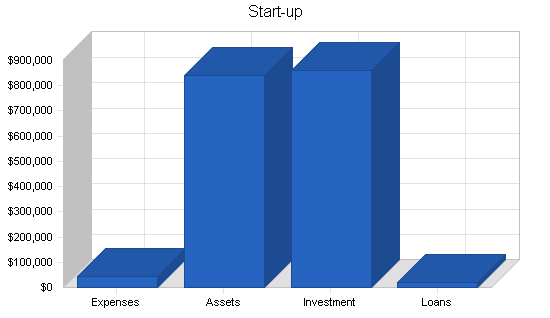
2.2 Company Ownership
Sedibeng Breweries is a Private Limited company incorporated at the Registrar of Companies through the foresight and vision of Mr. X and Mr. Y. Its fiscal year is the calendar year. Though it has only been in existence for seven months it realizes the potential market and opportunity for growth given implementation of the appropriate strategies, aided by the necessary finances.
2.3 Company Locations and Facilities
At present the company plants and offices are located in the growing industrial center of Selebi Phikwe, Kasane and Palaype with intentions of establishing an additional plant in Maun or Francistown, largely depending on the dictates of the market and the obtaining of a lease. Our current facilities provide offices, plants and machinery, office equipment and so on.
2.4 Company Values
Sedibeng Breweries is committed towards an open governance system whereby its activities are managed and undertaken ethically, transparently, and in the interests of all concerned stakeholders.
This shall be undertaken through implementation of the following company values:
- Ultimately we intend to uphold all the above company values, promoting our employees and respective third parties engaged by us to do likewise.
Through promotion and implementation of the above stated company values we believe that we will be able to attain our corporate and stakeholders’ goals and objectives for the benefit of all concerned, in particular the communities in which we will operate.
Sedibeng Breweries produces and markets several products. There are three main products currently in its production line. These are:
All products are periodically taken for testing to the National Food Laboratory for quality checks so as to ensure that they conform to required quality standards.
3.1 Product Description
Sedibeng Breweries produces products of high quality and impeccable taste. The company currently produces three main lines of products, namely X beer, Y beer and Z beer. All three have unique properties that will enable them to excel on the market. We will also be watching for technological developments in South Africa and overseas, allowing us to be first on the market and produce high-quality products through cost effective means. In addition the company will select suitable products for production under license.
Our current product listing is as follows:
- Z Beer This traditional food product is widely consumed as a substitute for regular meals and energy booster, whenever available. Up to now it has only been available in two sources, namely home prepared or more commonly bought from a shop having a fridge to keep the product refrigerated.
This denies the people in rural area access to these delicious and nutritious foodstuffs. In fact, it is so wholesome that a growing child is able survive on one litter of this per day, as it contains protein, starches, calcium, vitamins and other essential trace elements. We have the ability to produce a long life Z that needs NO refrigeration, which can be sold from the shelf in the same fashion as Ultra Mel and similar products. This means that it can be bought by consumers who might not always have access to cooling or refrigeration facilities, to be consumed later, as a food whilst way from home, or as an emergency food supply. This is available in several flavors, such as x, y, w, t, s and other xx flavors that the market might want. It is also a good product to use in school feeding schemes and similar projects.
3.2 Competitive Comparison
Identifying competition in terms of companies that fill the same needs that we do, our competitors are few in our main product lines, though dominant in the market. Hence there will be a need to strongly differentiate ourselves from these other businesses. However on a broader scale our competition comes in several forms:
- On a larger scale manufacturers of other beverages including soft drinks and coffees also constitute competition, but of a generic nature, as people have to choose between them as refreshments. These products being marketed in supermarkets are often advertised on an extensive basis. To this end we intend to implement a strategy that will integrate the various promotional elements or tools such that our products are well known and appreciated on the market.
3.3 Macro-environment
Over the last few months abnormal weather has affected many parts of Southern Africa, including Botswana, during the key summer season. It has been extraordinarily severe with heavy rainfall, flooding and there definitely promises to be low temperatures, particularly in the winter season. This is likely to have an adverse effect on our initial financial performance, though marginal as consumption levels may decrease slightly.
At a large scale, market research demonstrates that the brewing industry market is growing and changing. Generally there is a trend toward more appealing and attractive brews as potential customers either are moving to the urban areas as a result of urbanization or are satisfied with an existing brew in their area. Research indicates that those in the rural areas are often satisfied with the existing brew due to lack of access to other higher-quality brews, whilst the new generation of executives being more educated and aware of the global environment wants to be seen drinking something attractive and recognized by others–status recognition. In addition this same market is not only more image conscious but appreciative of a quality brew as it is more selective. Therefore with the emergence of this generation of individuals, the appreciation of quality brews and packaging, dictates that our product lines will be popular.
Private sector development has been recognized as a vital ingredient in creating employment and training opportunities, and realizing the national goal of sustainable economic diversification. In addition to the country increasingly becoming a tourist destination, we foresee the demand for our products especially in the resorts and lodges where it will be promoted. Through undertaking of our professional business activities we foresee that it should not be too difficult to gain market acceptance provided we deliver the final product on time, of good quality, and at competitive prices.
3.4 Technology
Sedibeng Breweries will strive to maintain the latest and most efficient assembly technology so as to ensure quality-brewed beverages, and maintain low production costs ultimately benefiting the consumer. Keeping abreast with technological developments will ensure we gain and maintain a competitive advantage utilizing the latest production techniques.
3.5 Future Products
In putting the company together we have attempted to offer enough products to allow us to always be in demand by our customers and clients. The most important factor in developing future products is market need. Our understanding of the needs of our target market segments shall be one of our competitive advantages. It is critical to our effort to develop the right new products. We also intend to have what we call a “core product engine” that will be the foundation of future products. This shall be established in time as we determine our core product. In the future, Sedibeng Breweries will broaden its coverage by expanding into additional markets (i.e., the whole of Southern Africa) and additional product areas. In doing so we will strive to ensure that it is compatible with the existing products and assembly technology.
3.6 Fulfillment
- We will turn to reliable farmers, suppliers and distributors who will assist in ensuring that the products are delivered timely and are of the highest quality. We will also rely on these stakeholders for relevant information on the market situation (trends, consumer tastes, feelings and comments amongst other things).
SWOT Analysis SWOT analysis .">
We are in a highly lucrative market in a rapidly growing economy. We foresee our strengths as the ability to respond quickly to what the market dictates and to provide quality brew in a growing market. In addition, through aggressive marketing and quality management we intend to become a well-respected and known entity in our respective industry. Our key personnel have a wide and thorough knowledge of the local manufacturing market and expertise, which will go towards penetrating the market. However we acknowledge our weakness of a medium-sized company without a lot of experience, and the threat of new competition taking aim at our niche. Below are the summarized strengths, weaknesses, opportunities and threats.
4.1 Strengths
- An aggressive and focused marketing campaign with clear goals and strategies.
4.2 Weaknesses
- Establishment on the Internet will produce technological challenges.
4.3 Opportunities
- Increasing number of foreign firms, especially from South Africa looking at penetrating the market.
4.4 Threats
The present growth in the market may result in market saturation, through competition. This competition could emerge from a variety of given sources including:
- Intolerable price increases by foreign suppliers may occur.
Market Analysis Summary how to do a market analysis for your business plan.">
Today we are experiencing rapid growth in the economy of unsurpassed nature. This has been brought about by (amongst other things) the relaxation of foreign exchange policies and macro economic policies geared towards attracting foreign investors into the country. The fiscal and monetary policies of the government geared towards maintaining growth with social justice have largely contributed towards this, evidenced by our economy averaging a growth rate of 7% since 1990–very high by international standards.
The current drive and emphasis by the government on diversification of the industrial base away from the minerals sector presents an opportunity for Sedibeng Breweries to make a valuable contribution towards achieving this goal. This will result in implementation of modern production techniques and transfer of knowledge. Having undertaken a thorough and comprehensive research of the market we realized that there was a need for a manufacturer that focuses on producing affordable thirst quenching brew tailored to satisfying client’s needs. Though there are breweries currently on the market, some of whom have been in existence for a relatively long period of time, we believe that there is a market need for one (ourselves in this instance) that particularly focuses on the low to medium earning individuals. We intend to provide products of extremely high quality–something that cannot be over-emphasized in the international arena with the current drive towards globalization. The marketing mix of the products has been carefully and strategically put together to position them in the market.
Aware of the fact that we will be operating in a predominantly monopolistic market structure we intend to ensure that our marketing strategies are considerate of the importance of the fit between our products capabilities and benefits, and the target market, so as to develop a strong sustainable competitive position in the market. As a result we intend to implement a niche marketing strategy, focusing on certain target markets, particularly in view of XX Breweries dominance on the market. Our initial overall target market share shall be 6% of the local market. This share will vary with the actual products, with ginger beer having a larger share than traditional beer due to its uniqueness.
We appreciate that entering such a market is not a bed of roses, particularly as it is monopolistic. Hence we intend to implement an aggressive marketing strategy, well supported by the other business functions. The above prognosis influenced our decision to enter the brewing industry.
5.1 Market Segmentation
Sedibeng Breweries will be focusing on the corporate and working class who appreciate good quality traditional beer. The working class will range from the miners who constitute a large portion of the market, to administrative personnel appreciative of good quality traditional beer. The corporate or managerial segment will constitute those managers who though aware of their image and reputation, want to put aside their ties and jackets after hours and/or on weekends to drink good traditional beer, easily accessible in the urban areas.
Our most important group of potential customers are those in the rural areas who often converge after hours to socialize and update one another on local news. These are potential customers who want to have an enjoyable time whilst drinking a good refreshing beverage. They do not want to waste their time making their own brew, but appreciate a good quality brew at a reasonable price.
We also intend to appeal to the foreign and local tourists who would be looking at experiencing traditional foods and drinks, a change from the usual beverages they often have.

5.2 Target Market Segment Strategy
Our marketing strategy will be based mainly on making the right product available to the right target customer. We will ensure that our products’ prices take into consideration peoples’ budgets, and that these people appreciate the product and know that it exists, including where to find it. The marketing will convey the sense of quality in every picture, every promotion, and every publication. There is already a sense of segment strategy in the way we define our target market. We are choosing to compete in areas that lend themselves to local competition, service and channel areas that match our strengths, and avoid our weaknesses.
Our strategy calls for the development of relationships with suppliers, distributors and retailers to support our business. Regular visits will be undertaken to these areas so as to ensure that we are meeting their expectations.
5.2.1 Market Trends
Our target markets are increasingly growing towards recognizing the difference between poor quality brews and those of high quality. This development is an important trend for us as it represents our target market. We now are having an increasing number of people who appreciate the traditional brews whilst living in the urban areas. With this in mind we intend to ensure that our packaging is respectable and attractive.
Today’s extremely stressful work environment dictates that individuals consume healthy drinks especially in the summer season, this presents an opportunity that we may exploit, marketing the health aspect of our beverages.
5.2.2 Market Growth
Import statistics provide a reliable guide as to the size of the brewing industry. According to the Trade Department, the market has been growing at a steady rate of 7% per annum although it is projected to increase slightly in 1999 and 2000. According to the most recent Trade Department import statistics for beer and wine, total beer and wine imports stood at 10,421,968 liters ($14,473,000) in 1998 whilst total exports stood at 864,668 liters ($281,363) in the same year. This brought about a total market size estimated at just over 11,286,636 liters in 1998. Specifically, imports for traditional beer stood at 310,627 liters in 1998 which represented an increase of approximately 32.56% from the previous year (1997). In 1997 these imports had risen by approximately 66.14%.
5.2.3 Market Needs
Sedibeng Breweries will set out to provide good quality products that will help instill a jovial environment. Sedibeng Breweries intends to provide the customer with more than a drink to quench one’s thirst. We intend to provide a quality brew that not only quenches one’s thirst but enables one to enjoy themselves and be proud of it. The quality of raw materials and assembly technology evident in our products will serve to enhance the appearance of our customers, in turn adding to their status. The large market is due to the fact that opaque beer is traditional beer for most Botswana. It is consumed for social, ritual and ceremonial purposes and hence appeals to a vast majority of the rural population in particular.
5.3 Industry Analysis
Industry analysis information is presented in the following subtopics.
5.3.1 Competition and Buying Patterns
The key element in purchase decisions made at the Sedibeng Breweries customer level is the availability of an affordable, thirst-quenching product of good quality. The most important factor in this market is the distribution network. This is particularly so considering the good distribution network that XX Breweries Limited has in place enabling them to produce products that are constantly in demand throughout the country.
5.3.2 Main Competitors
Being in a predominantly monopolistic market structure, competition in the brewery manufacturing market as a whole is not that intense (in terms of numbers) at the current time due to the dominance of XX Breweries Limited, which has been on the market for a relatively long period of time. Cognisance should also be taken of home brewers who represent competition on our intended market. However upon closer research we identified several niches in the market that we may exploit, not wanting to confront XX Breweries one-on-one.
In general, our competition will be stiff, as we intend to penetrate the low to medium earning customer. At the same time we shall be differentiating ourselves from XX Breweries. We intend to market ourselves in such a way that with time competitor customers will choose our products over competitors’ on the basis of our higher quality, thirst-quenching brews. We shall now provide a more thorough outline of our main competitors in the same strategic group as ourselves, including their strengths and weaknesses.
XX Breweries Limited and ZZ Breweries – T Brewery Holdings
Arguably the largest and most reputable manufacturer, supplier and marketer of alcoholic and non-alcoholic beverages in the country, XX Breweries has been on the market for a considerable period of time now. Part of the large and extremely reputable conglomerate, YY Breweries International, XX Breweries is currently the dominant domestic producers of beer, sorghum and Coca-Cola products in the country, with an overall market share of more than 95%. XX Breweries is able to take advantage of the financial, managerial and technical clout that it has through YY Breweries International. Due to its size it enjoys an economy of scale and thus the competitive advantage of being able to offer low priced beverages in large quantities to its target markets. YY Breweries International Africa enjoys strong cash flows in the form of royalty payments, management fees and dividends from its Botswana operations due to its dominance.
One of XX Breweries’ main products is S traditional beer, which will be one of our main competitor products. S is currently mass marketed in the whole of Botswana and is popular amongst the rural and town folk. It is also present in the regional countries, including Zimbabwe, Zambia and Mozambique, with current intentions of going beyond these borders. This is mainly because it is in its maturity stage and these efforts of going international are meant to extend its product life. However a frailty of S is that the product does not maintain freshness for a long period, which is debilitating when its intentions are export. Hence Sedibeng intends to take advantage of this weakness.
XX Breweries In Botswana
Recent financial results from T Brewery Holdings indicate that the organization as a whole has continued to perform exceptionally well on the back of a buoyant Botswana economy. Turnover grew by 42% whilst operating profit is up 60% from $21.5 million to $34.5 million. For the 12 months to 31 March 2000, volume growth exceeded non-mining GDP growth by more than 2%, resulting in turnover growth of 12%. According to the audited results, higher volumes and turnover coupled with greater productivity and stringent cost controls translated into excellent earnings growth. With this in mind we strongly believe that there is an extremely lucrative market we may exploit.
Strategy and Implementation Summary
Our marketing strategy emphasizes focus. This will be the key. We are a relatively new company and hence must focus on certain kinds of products with certain kinds of consumers. Initially Sedibeng Breweries will focus on the local market and in the remote and previously inaccessible areas where there is a large market for our products. Hence the form of growth that shall be initially pursued will be that of organic growth mainly due to limited resources and the need to instill confidence in our products. The target customers will include key decision-makers in the retail and supermarket chains who often order or recommend on behalf of the whole organization, the aim being to obtain an initial order and fully satisfy the customer from then on.
- We are focusing advertising on several key media.
We intend to achieve growth by creating a more enthusiastic customer culture than that of our competitors. All criteria from price competitiveness to staff attitudes are to be initially measured six-monthly, and then on a more regular basis as time goes on. The results will go down to depot level and be compared with the overall target. This form of consistent measurement of strategic goals will ensure that the organization remains focused on its goals and objectives, making any necessary adjustments where need be.
6.1 Value Proposition
Our value proposition is offering our customers refreshness and enjoyment at reasonable prices ensuring peace of both body and mind. Hence we intend to:
- Market the company.
This value proposition shall be communicated through advertisements, personal selling, sales literature and catalogues, and referrals that emphasize how the company is able to provide refreshment, enjoyment and fulfillment to the customers.
6.2 Competitive Edge
Our competitive edge will be our dominance of access to previously remote areas, customer orientation and traditional high-quality brew through stringent quality control. Although XX Breweries dominates the local market, it does not penetrate the remote areas as much as we intend to.
Though we shall be serving different market segments we intend to focus on (discussion removed for confidentiality).
6.3 Sales Strategy
We intend to focus on improving our implementation, by working on key objectives and better coordination of marketing efforts. For the short term at least, the selling process will depend on personal selling and advertising to lure and inform potential clients about the products we offer and the benefits of consuming our products. Our marketing does not intend to affect the perception of need as much as knowledge and awareness of the product categories.
6.3.1 Sales Forecast
The sales forecast monthly summary is included below. The annual sales projections are included later in the plan. It should be noted that as we become established and known on the market we project sales to increase at a faster rate than the initial year.

6.4 Marketing Strategy
One core element of our marketing strategy will be that of differentiation from our competitors. In terms of promotion, we intend to sell our company as a differentiated strategic ally, not just our products. In price, we intend to offer extremely reasonable prices in comparison to the competition and we need to be able to sustain that. Market penetration through lower prices shall be undertaken where need be, while premium pricing will be the case of the upper-end of the market.
6.4.1 Service Provision
The service aspect of Sedibeng Breweries marketing mix shall constitute an important element in delivering total quality. This is due to the high degree of exposure our competitors already have. As such we intend our customer service to be key to the retention of customers. We shall follow-up with our clients on a regular basis so as to ensure they are satisfied with our products and delivery times. This is mainly because we intend our customers not to be one-time buyers but regular order seekers. The establishment of a rapport and understanding between our customers and ourselves is going to be an ongoing processes.
We intend to implement database marketing whereby we shall be targeting customers based on their previous purchases, in terms of size, frequency and actual products, so as to forecast their demands and establish long beneficial relationships. Customer service shall be enhanced through infrastructure support in the form of merchandising and credit facilities, and alternative distribution facilities where possible and viable.
6.4.2 Pricing Strategy
Initially our prices will not be under our control but dictated by the market conditions prevailing at the particular time. This is particularly so in the case of products which are also produced by our competitors, as they are often representing a scale for consumers. However we realize that we must charge appropriately for the quality and work we shall be providing, in addition to the distribution of the products. Hence we intend the price will accommodate the mark ups prevailing in the industry, as well as our own costs. To be competitive in the market we intend to offer discounts to customers making bulk orders, which are in competition with the industry. This will also assist in the establishment of customer loyalty. Hence our prices shall be as follows: (discussion removed for confidentiality).
We intend our income structure to match our cost structure, so as to ensure that the salaries we pay to assure good workmanship is balanced by the price we charge. We will make sure that we charge for the product, workmanship and delivery with our aim being to achieve a gross profit margin of at least 30% in our initial years of operation. All in all we intend our prices to be extremely competitive on the market.
6.4.3 Promotion Strategy
Our promotion strategy will be based primarily on informing potential customers of our existence and making the right information available to our target customer. Since we shall be targeting different segments, the promotional tools and messages may vary slightly to match the intended market. However in all cases the marketing will convey the sense of quality, refreshness and health in every picture, every promotion and every publication. Promotional campaigns will seek to promote the ‘sharing aspect’ of the beer, customers drinking these products in groups. Our promotional activities shall be focused towards driving the organization’s overall strategy relentlessly, developing internal consistency and prepare it to confront any radical changes that may arise. In such a market we cannot afford to appear in, or produce, second-rate material that make our products look less than they are. We intend to leverage our presence using quality brochures and other sales literature, including promotional material such as pens, complimentary slips and stickers. Due to the fact that our products are in the introductory phase on the market, promotional expenses are high in order to generate customer attention and knowledge of our products existence.
We intend to spread the word about our business through the following:
Advertising
In view of the fact that we are entering a market largely dominated by XX Breweries Limited which has an approximate market share of approximately 95% (as previously discussed) we intend to undertake extensive advertising of our products in addition to our brand name–company name. This is so as to instill awareness and knowledge of our existence in the market place, which hopefully shall convert into market share. Hence the need to ensure that our products are constantly available to our target market, and of consistent high quality. Whilst we are committed to providing products of uncompromising quality to meet the needs and expectations, the company believes its products should be advertised and promoted in an honest and ethical manner that respects the values of our consumers’ societies. Examples include the Boccim Business Directory which will require us being members of Boccim, Botswana–a review of commerce and industry, Contacts Botswana, and other telephone directories. A constant look out will also be made of any special editions in the local newspapers, which may provide an opportunity to advertise.
These are increasingly becoming important as more firms establish in the country and hence the need to be known. The organization aims to participate in trade shows and quality taste tests. Not only will these increase awareness of the products, but if a particular product were to gain recognition, for example through being chosen #1 at a taste test, the organization will be able to take advantage of this in all its promotional campaigns, adding leverage to its reputation and image. Undoubtedly this would add confidence and pride in our staff complement as their hard work would be recognized often at the highest levels. Communicating such achievements often gives customers a feeling that they can rely on the product, and this builds strong customer loyalty. An example of a trade show we intend to participate at is BITEC. The aim of this exhibition is to provide a conducive environment for companies to display their products in a specialized exhibition. The exchange of technologies, ideas, and contacts will serve as a fertile ground for the blooming of healthy trade relationships and partnerships.
We also intend to participate at the Botswana International Trade Fair (BITF) in August so as to expose our business to potential customers and suppliers. Such fairs serve as important eye openers for both potential customers and ourselves. With time it shall be necessary for us to participate in regional trade shows and fairs such as the South African Exhibition Show so as to gain awareness and ultimately orders from outside the country.
Public Relations
Recognizing that we are relatively new on the market there will be a need to organize an event, of grandeur nature, introducing ourselves onto the market. At this we intend to invite potential customers, senior officials, including the Minister of Industry and Commerce, and other stakeholders so as to penetrate the market. In collaboration with this we also intend to place news stories and features in magazines and newspapers to keep stakeholders updated on the latest developments and to increase awareness. We also plan to have a major festival initially in Selebi Phikwe, appropriately named, that maintains and promotes Botswana culture. This will assist in the recognition and appreciation of our company in the surrounding community especially. Our efforts on community service will show that the company has its community at heart, contributing towards the establishment of a good and reputable image. Homes for the under privileged will be also be built in the medium, to long term as we plough back into the society we operate in. In addition we intend to pursue educational sponsorship for the less advantaged but promising young individuals in the community. This will constitute some of our corporate social responsibility details of which are provided in the respective section.
We also intend to experiment with a road show in the various often-neglected remote areas giving out caps, bags, and other such prizes to individuals who answer questions correctly. This will also enable our business name and products to be better known by the respective communities. However we are extremely confident that these road shows if well planned will be a success as they encourage community participation. Brewery tours shall also be arranged with interested stakeholders including school children and college students. This is so as to increase awareness of our facilities and products and also showing confidence in our production process and standards. Hopefully visitors will leave impressed and confident in our products, adding to the possibility of positive referrals. These same tours will also be arranged with prospective clients/order-takers.
Still in the infancy idea stage we have in mind the hosting of a ‘fest’ whereby guzzlers of our brews as well as first-timers are encouraged to drink as much as possible whilst enjoying themselves. This is likely to be held in the hottest month of the year (October) when people are often extremely thirsty. Hence the name ‘October fest’ might be appropriate. Proceeds of such festivities are to be donated to charities.
Personal Selling
This shall be undertaken in the form of sales calls whereby a sales person will go out to potential customers and distributors informing them what products we are able to offer them. In addition the sales person will listen to client’s needs at close hand, so as to ensure that the product is delivered timely and that it is the right product as demanded by the surrounding community. Close analysis shall also be undertaken of the consumption patterns of the respective communities, that is whether they prefer larger or smaller containers. This will ensure that our products are customized as much as possible to the surrounding community’s needs and wants. In cases where there is the opportunity of obtaining a large order it may be necessary for the top management to go out personally, especially considering the fact that we are still a relatively new firm in the market.
Direct Marketing
This will be used, but only to a limited extent, in the form of telemarketing and informing potential customers and obtaining referrals where possible. In the case of telemarketing it will involve our targeting potential customers/distributors of our products and informing them of our existence and the products we offer. We may then arrange for an appointment with the respective decision-maker/order-maker, with the intention being to lure them into ordering one or more of our product lines.
Internet Marketing
The increasing growth of the Internet as an information source provides an opportunity that we may exploit. This is particularly so in view of the increasing investment and global trade amongst countries, as both large and small organizations look at obtaining the best deal possible. More often than not these organizations will seek out potential clients over the Internet due to the cost of transport and accommodation, apart from the obvious time factor, which is increasingly becoming of importance in view of the dynamic environment. However this will require adequate planning and research so as to establish a professionally done website. This will mainly serve foreign customers and other stakeholders including potential investors.
In all the above we intend to communicate our ability to manufacture good quality brews that will satisfy the customers needs. Hence our messages will influence the buying decision of prospective customers and distributors by emphasizing our unique selling proposition, and persuade prospective buyers that we are different from our competitors. All the above promotional tools shall be well integrated and utilized in tandem so as to maximize their effect.

6.4.4 Distribution Strategy
We believe that through our obsession for improvement, and commitment to a leadership position in our respective markets, we can overcome the traditionally binding constraints of resource base, firm size and narrow conceptualization of our business domain. This shall be undertaken through coordination and logical integration of our distribution operations. We aim to reduce cycle time for key processes, eliminate rework and waste, and optimize our human resources utilization. To attain low lead-times we intend to (discussion removed for confidentiality).
Trade Channels:
- Retail Distribution Channels (discussion removed for confidentiality).
We intend to ensure that our breweries are located close to our major distribution centers not only to minimize costs but also to enable our products to be easily available, in the best condition, in the different markets nationwide. By engaging and establishing good relationships with shebeen owners we intend our products to be readily available to our target market. In terms of actual delivery for every vehicle the daily fuel used, kilometers driven, repairs and maintenance costs must be recorded and compared with the set standard. (Discussion removed for confidentiality.)
6.4.5 Product Marketing
Our product marketing will emphasize the benefits of consuming our products, including refreshment and enjoyment of top-quality brews. We intend to sell the opportunity to enjoy oneself amongst friends, family and/or colleagues. This will come out in our advertising, delivery and collateral such as sales literature and business cards. Our product marketing’s most important challenge will be the problem of being accepted and appreciated on the market as a provider of quality products. Hence we intend to not only meet customers’ expectations but to exceed them, initially targeting a market share of 6%.
We intend to focus on the individual or group who want to enjoy themselves through the consumption and sharing of refreshing healthy beverages. However, not wanting to limit our horizons in the initial period, we intend to be continually looking out for opportunities that we may exploit. In all cases we intend to provide a thorough understanding and appreciation of the products to the customer and the benefits of consuming them.
6.4.6 Product Packaging
Our product packaging shall be of utmost importance, as it will definitely influence our potential customers on whether to try out our products or not. As such we shall ensure that it is not only attractive to consumers but also hygienic. As time progresses we intend to have packaging that enables the container to be used for other purposes after beer consumption, for example keeping water and being able to be deposited to retailers, the former of which we have identified as already being done. In the medium to long term we intend our product packaging to also be recyclable and hence more environmentally friendly–a continuous improvement process. Continuous improvement on packaging will also be undertaken so as to maintain, if not improve product appeal.
Currently the products are served in X ml and Y ml packs. However depending on the dictates of the market, there might be need to introduce new product packs. Hence we intend to ensure that we are flexible if such changes are to occur. A specific example is the X ml T beer pack, which is not being produced by any of the other breweries at the moment, representing an opportunity to be realized.
6.5 Corporate Social Responsibility
Sedibeng Breweries intends to be involved in a wide range of social responsibility engagement programs to invest back into the community in which we operate. Through our social responsibility program we can assist in improving peoples lives. If we contribute to development in a sustainable way, we need to support projects that communities bring to us, rather than strictly creating our own solutions for our communities. This is because if we impose our solution and drive a project it is an artificial response, and the risk is that the project will then always ‘belong’ to us. Whenever the project comes up against a new challenge, we will be expected to fix it, and will be forced to stay in a situation where we have to look after the same few projects forever. Rather we intend to fund several projects that belong to, and will be driven by, the community and become sustainable. However, before we commit ourselves to projects we intend to ensure that skills will be transferred, communities are involved and the projects will be able to become self-sustaining. We know that we cannot address all the development needs of our society. Where we can, we assist and sometimes may form partnerships so as to increase capacity.
We intend to be involved in the following activities:
- Arts and Culture (discussion removed for confidentiality).
Production Summary
Our production system shall strive to attain service excellence in addition to manufacturing safe, quality products. This shall be undertaken through the engagement of modern production techniques using up-to-date assembly technology. This will also result in low production costs being attained by the company. We also intend to ensure that the suppliers we engage are committed and reliable so as not to let down the final consumer in terms of the quality of the product and time of delivery.
In order to improve productivity in our plants we intend to reduce waste and duplication in our breweries by streamlining administrative functions and promoting and instilling a business culture that focuses on the teamwork rather than individual productivity. By the undertaking the above we will optimize our productivity given our available resources.
7.1 Suppliers
Currently the company obtains the vast majority of its raw materials from South African suppliers. However as we are committed to fair terms of trade and promotion of local business we intend to engage local suppliers. Hence raw materials, including x and y, may be sourced from local communal and commercial farmers avoiding intermediaries so as to minimize costs, ultimately benefiting the final consumer. The major advantages of doing so being higher margins, faster payments and lower risks of payment default. Through the use of economies of scale we aim to maintain low input and production costs. This may be undertaken through (discussion removed for confidentiality).
Hence we intend to establish good rapport with all our suppliers and hence long mutually beneficial business relationships. This shall be undertaken through working closely with suppliers to ensure uninterrupted deliveries.
7.2 Receiving
Recognizing that the receiving of our raw materials is an essential element in our entire business, we intend to ensure that it is done by responsible persons who will be present during off loading to check the quantity and condition of the consignment. During the actual off loading the receiving bay personnel will mass check on at least X% of the consignment. Non-confirming raw materials in terms of quality will only be approved with the consent of the managing director who would have undertaken further analysis of it.
7.3 Storage
It shall be the policy of the company to ensure that all raw materials are stored in a secure, clean and pest free manner. Stock takes and reconciliations shall be undertaken on a regular basis, initially done at least once a week. The stock principle of First In First Out (FIFO) shall be implemented. Whenever stock is taken out it shall be recorded on a separate stock or bin card, with reconciliations of raw materials issued to the brewery, issued to production, losses, opening and closing stock taken. Should any deviations arise these must be explained.
7.4 By-Products
Sedibeng Breweries intends to utilize every resource it has to the fullest possible extent. We realize that there shall be a lot of by-products that will be produced from our production of the main product lines. However not wanting to pollute the environment, and our community at large, we plan to utilize by-products whenever possible. This will ensure that our resources are fully utilized.
Management Summary management summary will include information about who's on your team and why they're the right people for the job, as well as your future hiring plans.">
Sedibeng Breweries shall evaluate the jobs it provides, paying competitive remuneration packages against market benchmarks to employees for their agreed and set out tasks. Consonant with its efforts to create added value by employees, Sedibeng Breweries seeks to negotiate the provision of incentive pay delivery mechanisms against achievement of agreed targets relating to accomplishment in the areas of productivity enhancement, savings and other specific successes, that is, the implementation of an effective performance management system.
Hence our human resources strategy will revolve around:
- Stakeholder inclusivity.
- Maintaining preventative health and safety structures for employees and support for surrounding communities.
8.1 Management Team
The management team, mainly comprising of the shareholders, has wide expertise and broad knowledge of the products and markets, which if well planned for, will enable the business to realize its goals and objectives. Daily management will consist of Mr. B in the role of technical and operations, and Mr. G in dealing with government, corporate bodies, and public relations.
Management style will reflect the participation of the shareholders. The company intends to respect its community and treat all employees well. We will develop and nurture the company as community. We do not intend to be overly hierarchical. Management’s ongoing initiatives to drive sales, market share and productivity will provide additional impetus.
8.2 Personnel Plan
We intend to compensate our personnel well, to retain their invaluable expertise and to ensure job satisfaction and enrichment through delegation of authority. Our compensation will include health care, generous profit sharing, plus a minimum of three weeks vacation. As an equal opportunity employer, we respect the diversity and human rights of our people, and strive to achieve optimal productivity, while realizing the full potential of each employee. Awards will be given out to outstanding individuals, groups and plants for hard work and production so as to instill a sense of fun into the work and promote the maintenance of high standards. Sedibeng Breweries recognizes that our employees contribute fundamentally to the company’s long-term prosperity. We intend to enhance our capacity to attract and retain people of quality, through benefits such as housing and family education grants.
Employee health shall be of extreme importance. This is because the health of our people is an integral element of employee well-being at work and at home. Compliance with relevant legislation is a minimum target in our organization. We also intend to minimize if not totally eliminate the number of isolated incidents of intimidation in the workplace, so as to ensure that production and distribution are not materially affected and sound relationships are maintained between employee and employer and between employees as a whole.
8.3 Training
In-house training shall be continuous with regular external training being undertaken particularly following any new developments in the market. This is so as to ensure that we are continuously able to anticipate our markets needs–a proactive approach, which is so essential if we are to gain and maintain a competitive advantage. Courses on brewing will be undertaken primarily in South Africa, preferably with the established and reputable firms, such as YY Breweries. This will ensure that our personnel are exposed to the latest production techniques and are able to set their standards, or benchmark, using these organizations standards. Internal training will not only include product and technical aspects, but also expand to give much greater knowledge of customers, market trends, products, new technology aids, time management amongst other such variables. We intend to conduct health education sessions for groups and individuals on health risks in the workplace, balanced with lifestyle education and employee assistance programs that incorporate rehabilitation and counseling in a range of illnesses and social or personal problems. This is of particular importance in view of the AIDS epidemic that has grappled the country and continent as a whole to unparalleled levels.
We acknowledge the fact that successful recruiting, motivation and discipline procedures are keys to the growth of the organization. Hence we intend to promote and maintain good labor relations, strong morale and high quality work per employee.
8.4 Feedback and Control
- We will encourage our employees to put forward any suggestions they might have regarding the improvement of any of the company’s functions–an open door philosophy. Such a culture will enhance innovativeness and creativity in turn leading to job satisfaction and enrichment.
Financial Plan investor-ready personnel plan .">
We want to finance growth mainly through cash flow and equity. We recognize that this means we will have to grow more slowly than we might like.
The most important factor in our case is collection days, particularly with the bulk order customers. We can’t push our customers hard on collection days, because they are extremely sensitive and will normally judge us on our terms. Hence they tend to have a certain degree of financial authority. Therefore we need to develop a permanent system of receivables financing systems, using a well-coordinated accounting department. In turn we intend to ensure that our investors are compatible with our growth plan, management style and vision.
Compatibility in this regard means:
- Fundamental respect for giving our customers value, and for maintaining a healthy and congenial workplace.
- Respect for realistic forecasts, and conservative cash flow and financial management.
- Cash flow as first priority, growth second, profits third.
- Willingness to follow the company and contribute valuable input to strategy and implementation decisions.
9.1 Important Assumptions
The financial plan depends on important assumptions, most of which are shown in the following table as annual assumptions. The monthly assumptions are included in the appendix. From the beginning, we recognize that collection days are critical, but not a factor we can influence easily. Interest rates, tax rates, and personnel burden are based on conservative assumptions.
Some of the more important underlying assumptions are:
- We assume a strong economy, without major recession.
- We assume, of course, that there are no unforeseen changes in economic policy to make our products immediately obsolete.
9.2 Break-even Analysis
Our break-even analysis will be based on running costs, that is costs we shall incur in keeping the business running, including salaries and wages, rent, water and electricity, insurance amongst others. Hence many fixed costs shall be included in these costs. We will thus aim to ensure that our sales levels are running comfortably above break-even.
The following chart and table summarize our break-even analysis. With fixed costs of approximately $41,040 per month at the outset (a bare minimum), we need to bill approximately $93,000to cover our costs. We don’t really expect to reach break-even until several months into the business operation.

9.3 Projected Profit and Loss
Our projected profit and loss is shown on the following table, with sales increasing from more than $1,466,000 the first year to more than $1,612,000 the second, and approximately $1,806,000 in the third year. Profits are calculated to be around $152,000 before tax the first year during the start-up phase of this business. This will be representative of a net profit margin of approximately 7%, which though may not seem that impressive is relatively good for a start-up firm in our line of business. As with the break-even, we are projecting very conservatively regarding cost of sales and gross margin. Our cost of sales should be much lower, and gross margin higher, than in this projection.
9.4 Key Financial Indicators
The following benchmark chart indicates our key financial indicators for the first three years. We foresee major growth in sales and operating expenses, and a bump in our collection days as we spread the business during expansion.
Collection days are very important. We do not want to let our average collection days get above 30 under any circumstances. This could cause a serious problem with cash flow, because our working capital situation is chronically tight. However, we recognize that we cannot control this factor easily, because of the relationship with our clients.

9.5 Expense Forecast
Initial marketing expenses are relatively high as we seek to become known on the market. This will be brought about by the development of sales literature, advertising expenses, and function expenses (including lunches and dinners with interested stakeholders). As our market share increases and capital is generated, further marketing programs and the expansion of those in existence at the time will be undertaken, to ensure market development. Once these programs will start generating revenue for the business, which we shall in turn reinvest.
9.6 Projected Cash Flow
Cash flow projections are critical to our success. Detailed monthly numbers are included in the appendix. However it should be noted that they do not take into account the required capital injection.

9.7 Projected Balance Sheet
The balance sheet shows healthy growth of net worth, and strong financial position. The three-year estimates are included in the appendix.
9.8 Business Ratios
The table below shows our business ratios.
The local brewing market has been growing steadily over the last few years due to increases in people’s disposable income and opening of the economy. With this in mind we intend our marketing programs to expand accordingly. The introduction of quality catalogues and sales literature will enable Sedibeng Breweries to market to potential customers. We project sales to increase accordingly, though slightly slower as we establish a reputation for ourselves. With time, a presence on the Internet and participation in regional trade shows will be key milestones to expanding sales and marketing potentials through the utilization of new channels and identification of potential customers.
Throughout the year we intend to undertake regular evaluations of our marketing programs so as to ensure that we are in-line with our intended objectives.
In summary we intend to undertake the following:
- Saying no: Though difficult initially, we intend to be able to say no to special deals that take us away from the target focus and are unprofitable.
10.1 Contingency Planning
- Though Botswana overall is rather secure on the labor front in terms of strikes we intend to have in place a mechanism that will ensure that were this to occur the negative effects would be minimized. However further research and analysis into the above is still being undertaken.
Tax Season Savings
Get 40% off LivePlan
The #1 rated business plan software
Discover the world’s #1 plan building software

- Sample Plans
- WHY UPMETRICS?
Upmetrics AI Assistant: Simplifying Business Planning through AI-Powered Insights. Learn How
- 400+ Sample Business Plans
Customers Success Stories
Business Plan Course
Strategic Canvas Templates
E-books, Guides & More
Business consultants
Entrepreneurs and Small Business
Accelerators and Incubators
Educators & Business Schools
Students & Scholars
AI Business Plan Generator
Financial Forecasting
AI Assistance
Ai pitch deck generator
Stratrgic Planning
See How Upmetrics Works →
Small Business Tools
Entrepreneurs & Small Business
Accelerators & Incubators
Business Consultants & Advisors
Strategic Planning
How to Write an Operations Plan Section of your Business Plan

Free Operations Plan Template
Ayush Jalan
- December 14, 2023

Your business plan is an elaborate set of instructions stating how to run your business to achieve objectives and goals. Each section describes a part of the process of reaching your desired goal. Similarly, the operations plan section of your business plan explains the production and supply of your product.
An operations plan is formed to turn plans into actions. It uses the information you gathered from the analysis of the market , customers, and competitors mentioned in the previous parts of your business plan and allows for the execution of relevant strategies to achieve desired results.
What Is an Operations Plan?
An operations plan is an in-depth description of your daily business activities centered on achieving the goals and objectives described in the previous sections of your business plan. It outlines the processes, activities, responsibilities of various departments and the timeframe of the execution.
The operations section of your business plan explains in detail the role of a team or department in the collective accomplishment of your goals. In other words, it’s a strategic allocation of physical, financial, and human resources toward reaching milestones within a specific timeframe.
A well-defined operational plan section of your business plan should be able to answer the following questions:
- Who is responsible for a specific task or department?
- What are the tasks that need to be completed?
- Where will these operations take place?
- When should the tasks be completed? What are the deadlines?
- How will the tasks be performed? Is there a standard procedure?
- How much is it going to cost to complete these tasks?
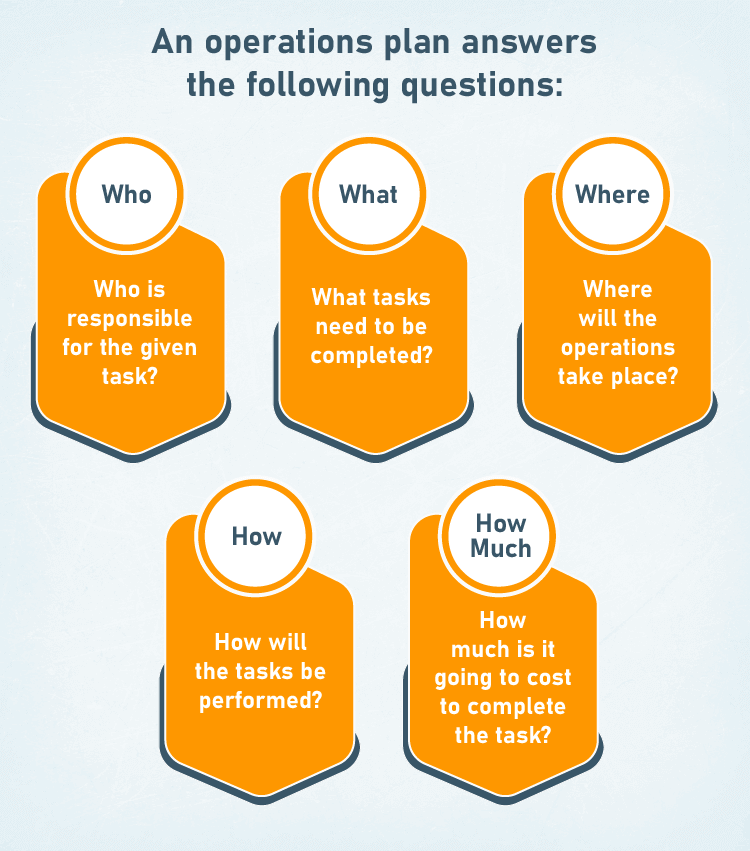
How to Write an Operations Plan Section?
Creating an operational plan has two major stages, both addressing different aspects of your company. The first stage includes the work that has been done so far, whereas the second stage describes it in detail.
1. Development Phase

In this stage, you mention what you’ve done to get your business operations up and running. Explain what you aim to change and improvise in the processes. These are the elements your development section will contain:
Production workflow
: Explain all the steps involved in creating your product. This should be a highly informative, elaborate description of the steps. Here, you also mention any inefficiencies that exist and talk about the actions that need to be taken to tackle them.
Supply chains
Quality control, 2. manufacturing phase.

The development stage acquaints the reader with the functioning of your business, while the manufacturing stage describes the day-to-day operation.
This includes the following elements:
Outline of daily activities:
Tools and equipment:, special requirements:, raw materials:, productions:, feasibility:, why do you need an operations plan.
An operations plan is essentially an instruction manual about the workings of your business. It offers insight into your business operations. It helps investors assess your credibility and understand the structure of your operations and predict your financial requirements.
An operations plan reflects the real-time application of a business plan.
Internally, an operations plan works as a guide, which helps your employees and managers to know their responsibilities. It also helps them understand how to execute their tasks in the desired manner—all whilst keeping account of deadlines.
The operations plan helps identify and cut the variances between planned and actual performance and makes necessary changes. It helps you visualize how your operations affect revenue and gives you an idea of how and when you need to implement new strategies to maximize profits.
Advantages of Preparing an Operations Plan:
- Offers Clarity: Operational planning, among other things, makes sure that everyone in the audience and team are aware of the daily, weekly, and monthly work. It improves concentration and productivity.
- Contains A Roadmap: Operational planning makes it much easier to reach long-term objectives. When members have a clear strategy to follow: productivity rises, and accountability is maintained.
- Sets A Benchmark: It sets a clear goal for everyone about what is the destination of the company and how to reach there.
Operations Plan Essentials
Now that you have understood the contents of an operations plan and how it should be written, you can continue drafting one for your business plan. But before doing so, take a look at these key components you need to remember while creating your operational plan.
- Your operations plan is fundamentally a medium for implementing your strategic plan. Hence, it’s crucial to have a solid strategic plan to write an effective operations plan.
- Focus on setting SMART goals and prioritizing the most important ones. This helps you create a clear and crisp operations plan. Focusing on multiple goals will make your plan complicated and hard to implement.
- To measure your goals, use leading indicators instead of lagging indicators. Leading indicators is a metric that helps you track your progress and predict when you will reach a goal. On the other hand, lagging indicators can only confirm a trend by taking the past as input but cannot predict the accomplishment of a goal.
- It is essential to choose the right Key Performance Indicators (KPIs) . It is a good practice to involve all your teams while you decide your KPIs.
- An operations plan should effectively communicate your goals, metrics, deadlines, and all the processes.
Now you’re all set to write an operations plan section for your business plan . To give you a headstart, we have created an operations plan example.
Operations Plan Example
Operations plan by a book publishing house
Track and Accomplish Goals With an Operations Plan
Drafting the operations plan section of your business plan can be tricky due to the uncertainties of the business environment and the risks associated with it. Depending on variables like your market analysis, product development, supply chain, etc., the complexity of writing an operations plan will vary.
The core purpose here is to put all the pieces together to create a synergy effect and get the engine of your business running. Create an effective operations plan to convey competence to investors and clarity to employees.
Build your Business Plan Faster
with step-by-step Guidance & AI Assistance.

Frequently Asked Questions
What role does the operations plan play in securing funding for a business.
The operations plan defines the clear goals of your business and what actions will be taken on a daily basis to reach them. So, investors need to know where your business stands, and it will prove the viability of the goals helping you in getting funded.
What are the factors affecting the operations plan?
- The mission of the company
- Goals to be achieved
- Finance and resources your company will need
Can an operations plan be created for both start-up and established businesses?
Yes, both a startup and a small business needs an operations plan to get a better idea of the roadmap they want for their business.
About the Author

Ayush is a writer with an academic background in business and marketing. Being a tech-enthusiast, he likes to keep a sharp eye on the latest tech gadgets and innovations. When he's not working, you can find him writing poetry, gaming, playing the ukulele, catching up with friends, and indulging in creative philosophies.
Related Articles

How to Write a Business Plan Complete Guide

Write Products and Services Section of a Business Plan

How to Prepare a Financial Plan for Small Business?
Reach your goals with accurate planning.
No Risk – Cancel at Any Time – 15 Day Money Back Guarantee
Popular Templates

An Ultimate Guide for Better Operations
- Operates towards success
- Describe business milestones
- Plan such as financials, budget planning
- Turn your goals into an actionable plan

- Grasshopper
Operations Plan
- Lesson Materials Operations Plan Worksheet
- Completion time About 40 minutes
The operations section of your business plan is where you explain – in detail – you company's objectives, goals, procedures, and timeline. An operations plan is helpful for investors, but it's also helpful for you and employees because it pushes you to think about tactics and deadlines.
In the previous course, you outlined your company's strategic plan, which answers questions about your business mission. An operational plan outlines the steps you'll take to complete your business mission.
Your operations plan should be able to answer the following:
- Who – The personnel or departments who are in charge of completing specific tasks.
- What – A description of what each department is responsible for.
- Where – The information on where daily operations will be taking place.
- When –The deadlines for when the tasks and goals are to be completed.
- How much – The cost amount each department needs to complete their tasks.
In this session, we explain each item to include in your operations plan.
Goals and Objectives
The key to an operations plan is having a clear objective and goal everyone is focused on completing. In this section of your plan, you'll clearly state what your company's operational objective is.
Your operational objective is different than your company's overall objective. In Course One , you fleshed out what your strategic objective was. Your operational objective explains how you intend to complete your strategic objective.
In order to create an efficient operational objective, think SMART:
- Specific – Be clear on what you want employees to achieve.
- Measurable – Be able to quantify the goal in order to track progress.
- Attainable & Realistic – It's great to be ambitious but make sure you aren't setting your team up for failure. Create a goal that everyone is motivated to complete with the resources available.
- Timely – Provide a deadline so everyone has a date they are working towards.

Different departments will have different operational objectives. However, each department objective should help the company reach the main objective. In addition, operational objectives change; the objectives aren't intended to be permanents or long term. The timeline should be scheduled with your company's long-term goals in mind.
Let's look at the following example for a local pizza business objective:
- Strategic objective : To deliver pizza all over Eastern Massachusetts.
- Technology department operational objective : To create a mobile app by January 2017 to offer a better user experience.
- Marketing department operational objective : To increase website visitors by 50% by January 2017 by advertising on radio, top local food websites, and print ads.
- Sales department operational objective : To increase delivery sales by 30%, by targeting 3 of Massachusetts's largest counties.
Sales department operational objective: To increase delivery sales by 30%, by targeting 3 of Massachusetts's largest counties.
Production Process
After you create your objectives, you have to think strategically on how you're going to meet them. In order to do this, each department (or team) needs to have all the necessary resources for the production process.
Resources you should think about include the following:
- Suppliers – do you have a supplier (or more) to help you produce your product?
- Technology team: app developing software
- Marketing team: software licenses for website analytical tools
- Sales team: headsets, phone systems or virtual phone system technology
- Cost – what is the budget for each department?
In addition to the production process, you'll also need to describe in detail your operating process. This will demonstrate to investors that you know exactly how you want your business to run on a day-to-day basis.
Items to address include:
- Location – where are employees working? Will you need additional facilities?
- Work hours – will employees have a set schedule or flexible work schedule?
- Personnel – who is in charge of making sure department tasks are completed?
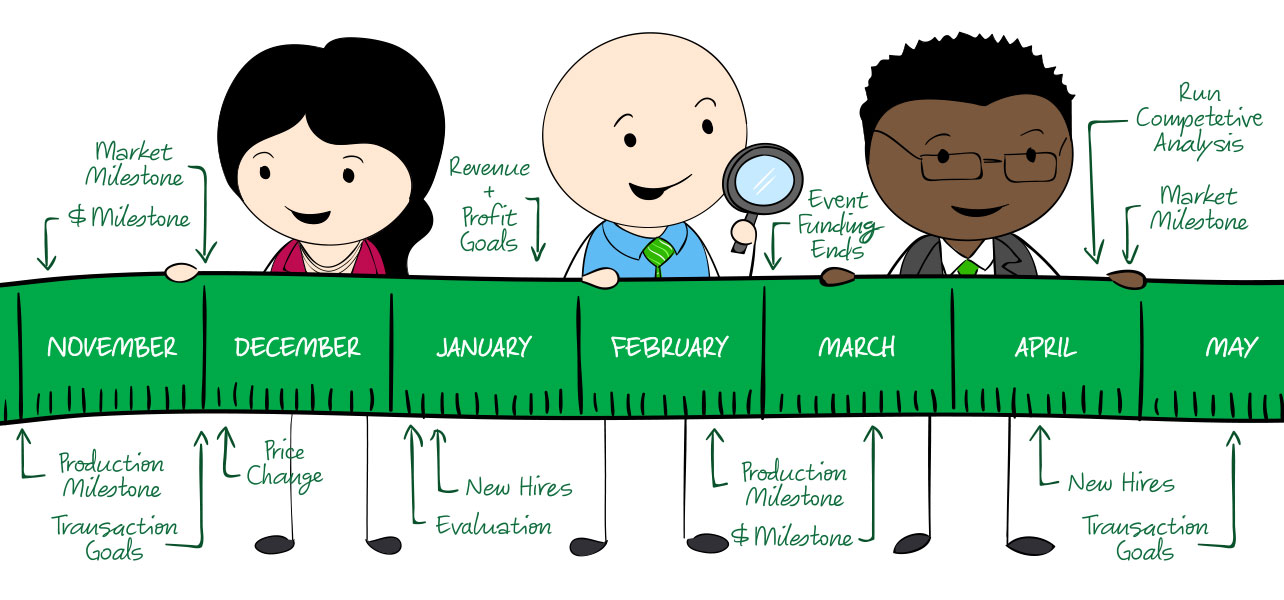
Creating a timeline with milestones is important for your new business. It keeps everyone focused and is a good tracking method for efficiency. For instance, if milestones aren’t being met, you'll know that it's time to re-evaluate your production process or consider new hires.
Below are common milestones new businesses should plan for.
When you completed your Management Plan Worksheet in the previous course, you jotted down which key hires you needed right away and which could wait. Make sure you have a good idea on when you would like those key hires to happen; whether it’s after your company hits a certain revenue amount or once a certain project takes off.
Production Milestones
Production milestones keep business on track. These milestones act as "checkpoints" for your overall department objectives. For instance, if you want to create a new app by the end of the year, product milestones you outline might include a beta roll out, testing, and various version releases.
Other product milestones to keep in mind:
- Design phase
- Product prototype phase
- Product launch
- Version release
Market Milestones
Market milestones are important for tracking efficiency and understanding whether your operations plan is working. For instance, a possible market milestone could be reaching a certain amount of clients or customers after a new product or service is released.
A few other market milestones to consider:
- Gain a certain amount of users/clients by a certain time
- Signing partnerships
- Running a competitive analysis
- Performing a price change evaluation
Financial Milestones
Financial milestones are important for tracking business performance. It's likely that a board of directors or investors will work with you on creating financial milestones. In addition, in startups, it's common that financial milestones are calculated for 12 months.
Typical financial milestones include:
- Funding events
- Revenue and profit goals
- Transaction goals
In summary, your operations plan gives you the chance to show investors you know how you want your business to run. You know who you want to hire, where you want to work, and when you expect projects to be completed.
Download the attached worksheet and start putting your timelines and milestones together on paper.

Talk about this lesson

Film Production Company Business Plan: The Complete Guide
The process of film production is a long and arduous one. It starts with the writing stage, where screenplays are written by a writer or multiple writers.
The screenplay typically has at least three acts that have to be edited for pacing and story development purposes. Once the script is finished, it’s time for pre-production!
There’s a lot of misconception about what film production really entails. This article will clear up some of the misconceptions and give you an idea of what it is like on set, as well as how to break into the industry.
FILM PRODUCTION COMPANY BUSINESS PLAN
What is a film production company business plan.
A film production company business plan is a document that can help you to get investors and loans from banks, but it’s also useful for you to see if your idea is viable. It helps you determine if it’s worth investing money, time, and effort.
Film production company business plans are documents that should be created before starting the business.
They will help you gain investors so you can start your film production company and make money out of your films.
A business plan should have all the necessary information about your film company , including the mission statement, executive summary, market analysis, funding request, financial projections, and management team.
Starting a film production company is an exciting venture that blends creative storytelling with the thrill of entrepreneurship.
Crafting a solid business plan is our roadmap to success, ensuring we navigate the complex landscape of the film industry with confidence.
We’ll jump into the essentials of a film production company business plan, from financial projections to marketing strategies.
Stick with us to learn how to lay the groundwork for a thriving production company that’s ready to take on Hollywood.

Executive Summary
When embarking on the exhilarating journey of starting a film production company, the executive summary stands as a pivotal introduction to the business plan.
It provides a snapshot of the company’s vision and objectives, ensuring that potential investors or partners grasp the core of what we’re building.
In our executive summary, we’ll outline the major points that distinguish our company, such as our unique storytelling capabilities and innovative distribution strategies.
We hone in on our competitive advantage – a blend of seasoned industry professionals and fresh talent that pushes the envelope of what’s possible in film.
We’ll also touch upon our foundational goals:
- Captivate a diverse audience with groundbreaking narratives,
- Create a slate of projects that showcase profitability and creative ingenuity,
- Establish a brand synonymous with quality entertainment.
Financial plans are succinctly summarized to demonstrate the strategic allocation of resources and the anticipated financial trajectory.
Here, investors will find confidence in our capability to manage budgets effectively and produce high-return projects.
Marketing strategies are briefly yet powerfully presented, showcasing how we plan to penetrate the market and gain substantial traction.
We outline our approach to leveraging social media , partnerships, and film festivals to amplify our presence and stake our claim in a crowded industry.
Each element of our executive summary is designed to pique interest and invite deeper exploration into our full business plan.
Through it, we lay the foundation for a dialogue with stakeholders that could translate into lasting support for our creative endeavours.
Company Overview
In the heart of our business plan lies the comprehensive Company Overview section, a detailed portrait of who we are and what we stand for.
As seasoned filmmakers at Filmmaking Lifestyle, we take pride in our ability to tell gripping stories through the lens of our cameras.
We offer a range of filmmaking services, but here’s a snapshot of our core offerings:
- Narrative Film Production – Our signature offering includes developing and producing feature films that resonate with audiences globally.
- Commercial Video Production – We craft compelling marketing videos that help brands tell their stories and engage with their target demographic.
- Innovative Content Creation – With the digital space evolving rapidly, we stay ahead of trends producing content that stands out in crowded platforms.
Our mission goes beyond the visual aesthetics; it’s about weaving narratives that leave a lasting impact.
Each project is an opportunity for us to push the envelope in creative storytelling.
At the core of our operation, we strive to achieve a convergence of artistic vision and commercial viability.
Anchored by a team of dedicated professionals, we bring diverse perspectives and skills to every production.
This synergy creates a fertile ground for innovative filmmaking.
Our work ethic revolves around a relentless pursuit of excellence and a commitment to staying on top of the latest industry advancements.
Focused on scaling our film production capabilities, we’re actively exploring emerging technologies and distribution channels to enhance our impact in the industry.
We’re all about staying ahead of the curve, making sure our films are not just seen, but remembered and revered.
With a portfolio that spans various genres and styles, our flexibility allows us to tailor our approach to each unique project.
Collaboration is key – by joining forces with talented writers, directors, and producers, we amplify our ability to craft unforgettable cinematic experiences.
Investing in our growth, we’ve equipped ourselves with state-of-the-art equipment and editing suites, ensuring professionalism and efficiency in our production workflow.

Convergence of art and technology is critical in our approach and is reflected in every piece of content we produce.
eventually, our Company Overview is not just an introduction to who we are; it’s an open invitation to jump deeper into the possibilities and potent potential of partnering with Filmmaking Lifestyle.
We’re here to bring visions to life and curate a portfolio of work that speaks volumes of our passion for filmmaking.
Vision And Mission
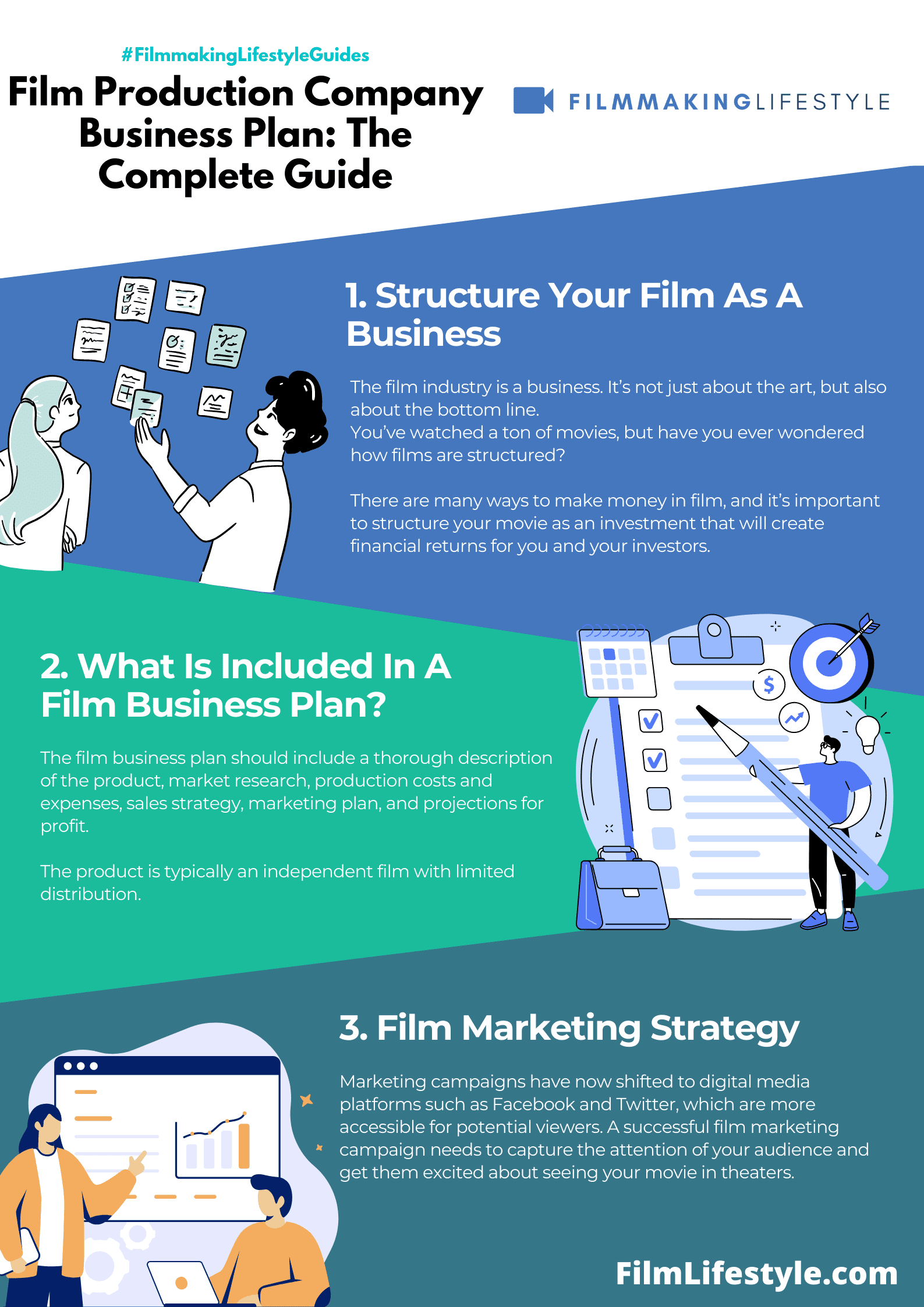
Matt Crawford
Related posts, how to get a movie on netflix: complete guide, 8 best crypto staking platforms in 2024 [ranked & reviewed], earning a living filmmaking: the complete guide, health and fitness for filmmakers, how to pitch a tv show: the definitive guide, 9 tips to starting a videography business in an emerging market.
Iam having a movie by the name from the streets to the world
Best of luck, Kelvin!
Matt .. would you have template of the Biz Plan .. and are you Fine with sharing the same? – AMAAN
Here’s an idea for a template: https://toskaproductions.com/wp-content/uploads/2013/06/TEA-Business-Plan.pdf
Leave a Reply Cancel reply
This site uses Akismet to reduce spam. Learn how your comment data is processed .
Username or Email Address
Remember Me
Registration is closed.
Pin It on Pinterest

Production Plan
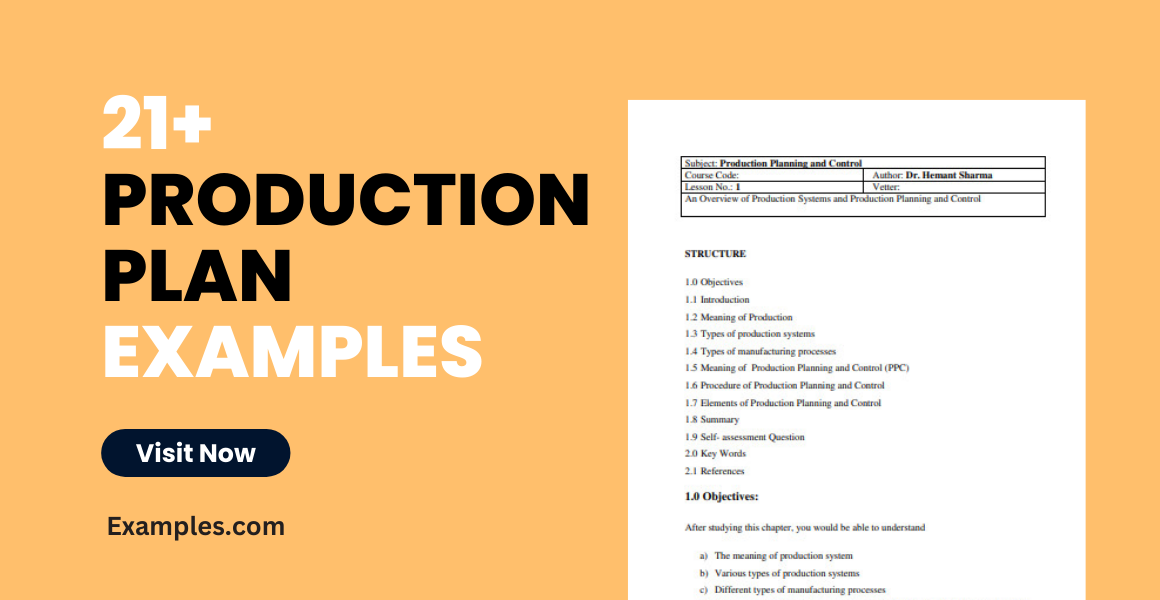
People face failure. Not all entrepreneurs are capable of thriving to survive in this industry. Indeed, businesses fail. And that is the truth about it. But do you remember how all the plans that didn’t push through? If you do, then now is the time to correct mistakes from the past. Don’t take planning as anything. Whether in food, film, or media production, organizing your activities helps in achieving your goals. Take your time to prepare a production plan . Be guided in executing the right activity to achieve your goals. Create a structure and release the doubt. Increase your potential and start planning for the production today.
21+ Production Plan Examples
1. daily production plan template.
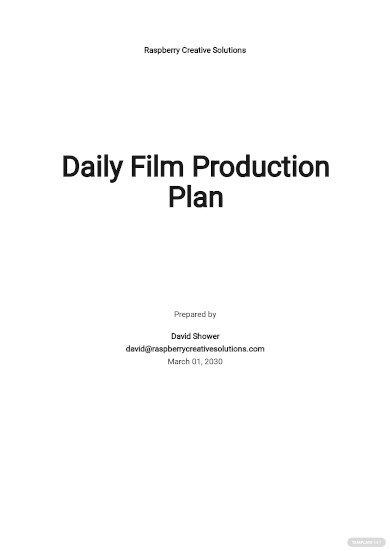
2. Pre Production Plan Template
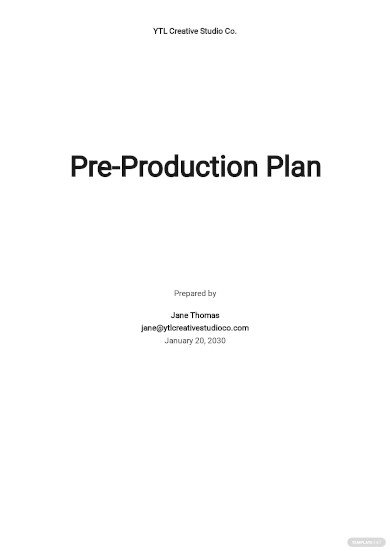
3. Film Production Plan Template
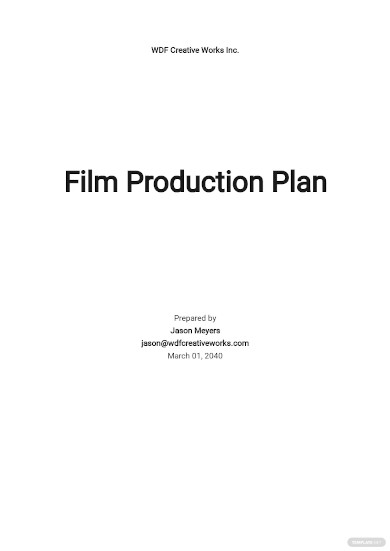
4. Production Control Plan Template
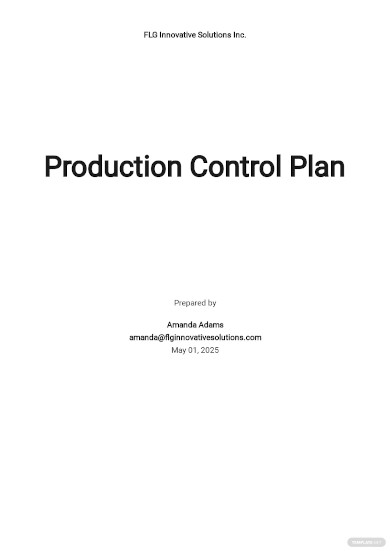
5. Production Support Plan Template
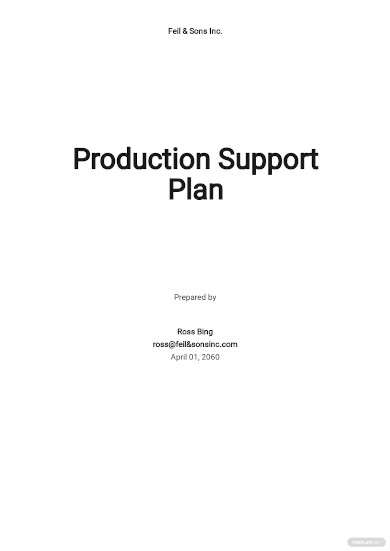
6. Web Production Plan Template

7. Production Company Business Plan Template
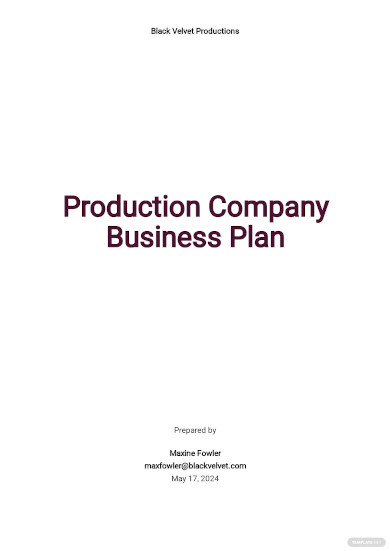
- Google Docs
8. Video Production Business Plan Template
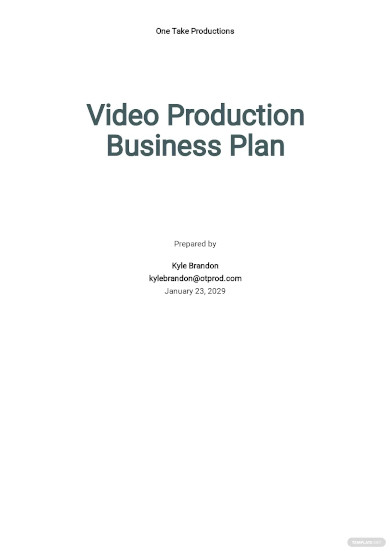
9. Production Plan Template
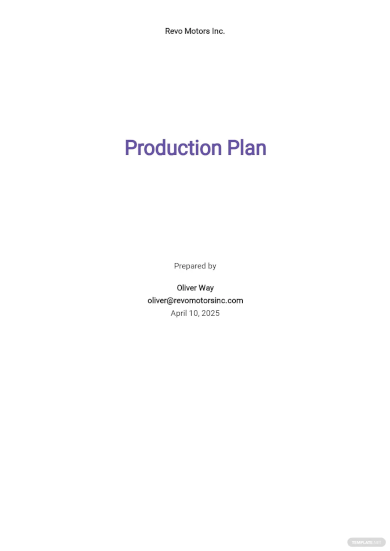
- Apple Pages
Size: 14 KB
10. Production Deployment Plan Template

Size: 23 KB
11. Video production Project Plan Template
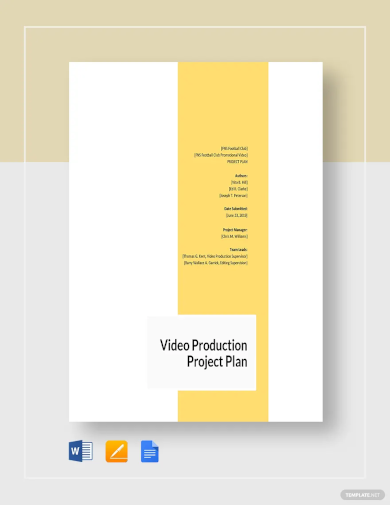
Size: 44 KB
12. Production Plan
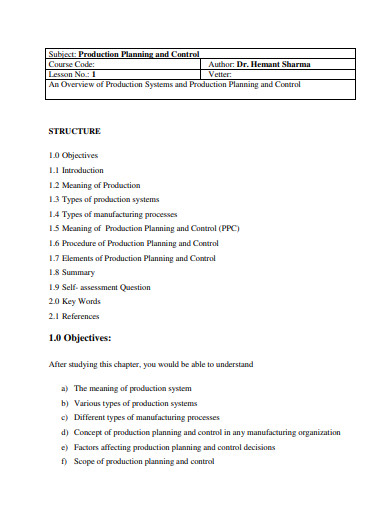
13. Production Capacity and Material Planning
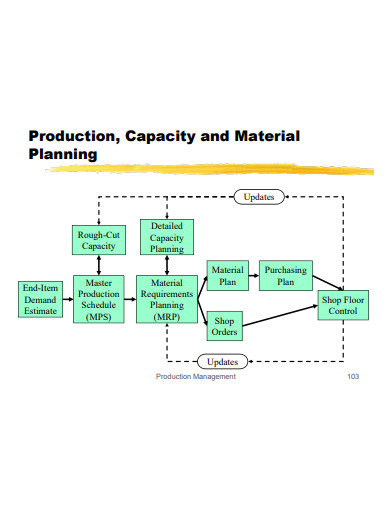
Size: 414 KB
14. Production Planning and Control
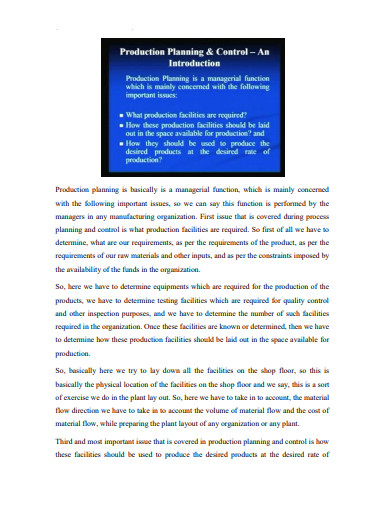
Size: 409 KB
15. Production Planning and Execution
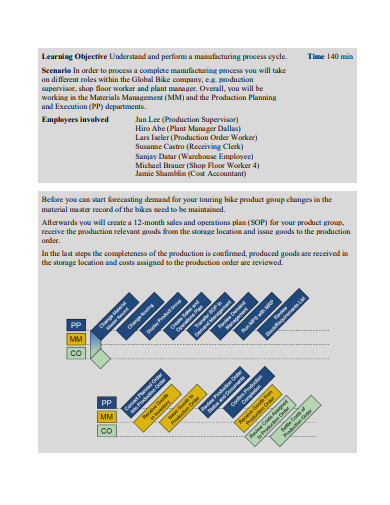
16. Sample Production Plan

Size: 486 KB
17. Simple Production Plan
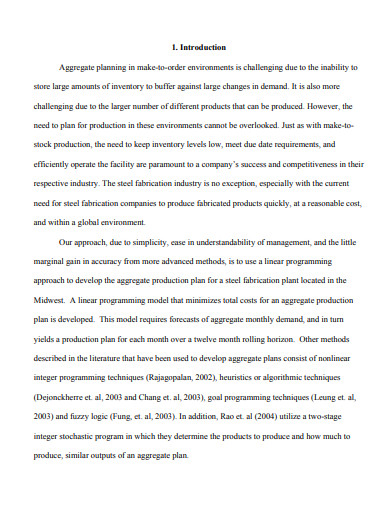
Size: 181 KB
18. Production Line Production Plan
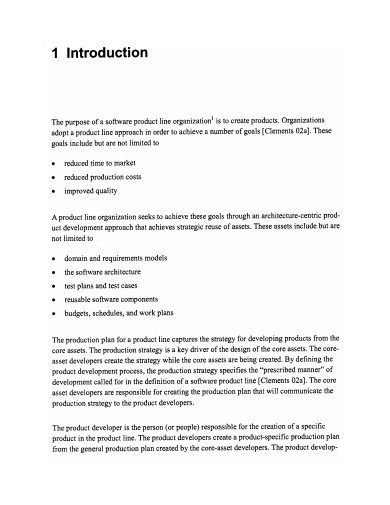
19. Demand Forecasting and Production Planning
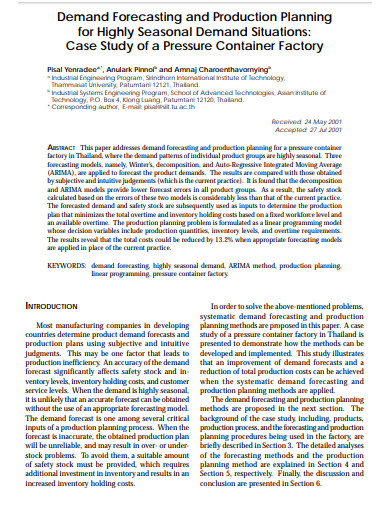
Size: 76 KB
20. Elements of Production Planning and Control
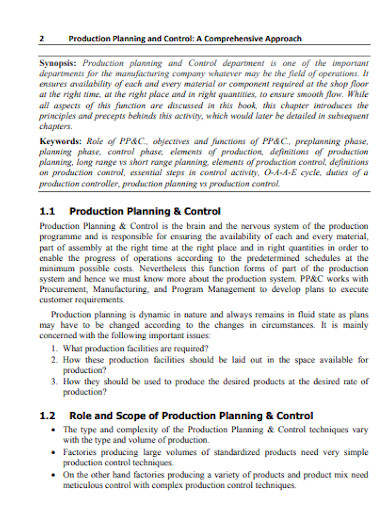
21. Housing Production Plan

22. Production Plan Example
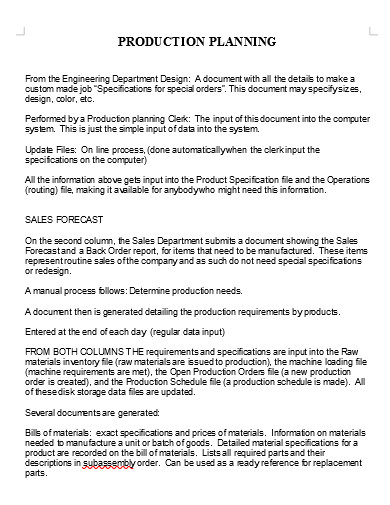
What is a Production Plan?
Small businesses are always tangled with several challenges while starting a business. You can expect that there will be projects, events, and daily activities. A production plan is a detailed document that outlines the structure of the company’s operations. In the plan, there is a structure, schedule, goal, activities, and the definition of resources in between. It is one step closer to success at a time. So, whenever your path is uncertain, a production plan will help in opening the right direction. This is why entrepreneurs must consider rewriting their planning techniques. If you are having issues with the layout, the proper organization saves the day.
Business Production Situation
According to an article published by Forbes, 80% out of 100 small business owners guarantee success in the first year of business operation. It manifests an above-average rate of success. However, behind this curtain are failing attempts for smaller businesses to stand out. Generally, the business industry is at a 50% stake in reaching accomplishment and failure. Surprisingly, many companies today face a battle without enough capital. Sometimes, competition is thick and no weapon to defend. These are just among the factors that affect the whole organization. But, don’t thrive for the worst. You need a little encouragement to compete. Here, you must adjust your business activities, schedule, and operations.
Generally, you need to plan. So, before you start getting back to your daily grind, let us learn more about writing down your production plan. Follow below.
How To Create a Production Plan
If you are a manufacturing firm, it is not always easy to look into the company’s needs. There will always be lapses. And that is one thing that you should avoid. But you can do this through planning. You need your plans outlined to track the inputs of the production. That is why we help you go through it. You should understand every step by following the list below.
1. Forecast Market Demand
First things first, you need to stretch it out. To effectively plan for the future of the business, you need an estimate of the sales through market demand. How many products should you produce to meet the target demand? When should these products be released? Another way to secure this process is through current and historical information. On top of the line, there will be orders in the coming weeks. So, you need to think ahead. In general, take advantage of internal and external resources.
2. Know the Production Options Available
Here, you need to verify the tools and resources necessary to produce your products and services. Take for example, when you have a bakery business, you need to know the machines that are required to produce bread and cakes. You can start this by listing the food on the menu. Then, create a flowchart. Once these are all secured, you can already identify the resources that should be available for the business to operate. You can improve the process by having the right materials.
3. Determine the Human Resources
Aside from the equipment, you need to count how many employees you will need to operate. Of course, it is not enough to operate without the labor workers that control and monitor the production. To do this accurately, separate each team into a department. But base them according to the availability of position and equipment. Your staff should be enough to deliver and produce without delays. But aside from that, you need to weigh in your production budget. Or else, it can lead to a big commotion.
4. Monitor Plan Control
An action plan without constant monitoring is just a waste of time. Neglecting this will eventually lead to pitfalls. So, you need to measure the risk factors. This is where you compare and contrast the production process. Record a report as this helps you determine a recurring problem. Don’t let issues happen in a blink of an eye. Monitor and control while you can.
5. Make the Necessary Adjustments
For the last step, make the adjustments you intend to make with your plan. What are the challenges? Does the plan need tweaking? Production planning can be a little tricky when done wrong. Now that you have monitored and measured the risk percentage, pen down all the actions necessary. Change them according to your evaluation. Here, you should achieve a comprehensive management plan . Weigh the budget, schedule, and activities too.
How do you define a production planning procedure?
Production planning is a process that is taken during manufacturing. It details all the necessary procedures for the company to operate. It includes hiring staff, checking the resources, evaluating the results. Through this process, the production will run smoothly.
What are the essential components of production?
Production consists of various components. These are essentials to execute the manufacturing process. This includes planning, producing, scheduling, evaluating, and following ups—all of these work hand in hand for the company to deliver quality products with no delay.
What are the primary goals of the production plan?
The general objective of production planning is to secure the workflow process of a manufacturing company. As the demand goes up, it is important to ensure that all the products released are of quality.
Are you struggling to meet your daily quota? Remember, one-day unproductive results in several risks in the business. This profoundly affects your reputation, and of course, the sales. But you can change honest mistakes. While you look at the list of tips in creating a production plan, you can resume your manufacturing business and align all the plans with your objectives. Understandably, running a business is daunting and frustrating. But you will never know your potential unless you try. So, start today. Highlight your potential by outlining all the plans necessary.
Text prompt
- Instructive
- Professional
Create a study plan for final exams in high school
Develop a project timeline for a middle school science fair.
Business Plan for Investors
- Bank/SBA Business Plan
- Operational/Strategic Planning Services
- L1 Visa Business Plan
- E1 Treaty Trader Visa Business Plan
- E2 Treaty Investor Visa Business Plan
- EB-1 Business Plan
- EB-2 NIW Business Plan
- EB-5 Business Plan
- Innovator Founder Visa Business Plan
- Start-Up Visa Business Plan
- Expansion Worker Visa Business Plan
- Manitoba MPNP Visa Business Plan
- Nova Scotia NSNP Visa Business Plan
- British Columbia BC PNP Visa Business Plan
- Self-Employed Visa Business Plan
- OINP Entrepreneur Stream Business Plan
- LMIA Owner Operator Business Plan
- ICT Work Permit Business Plan
- LMIA Mobility Program – C11 Entrepreneur Business Plan
- USMCA (ex-NAFTA) Business Plan
- Franchise Business Plan
- Landlord business plan
- Nonprofit Start-Up Business Plan
- USDA Business Plan
- Cannabis business plan
- Ecommerce business plan
- Online boutique business plan
- Mobile application business plan
- Daycare business plan
- Restaurant business plan
- Food delivery business plan
- Real estate business plan
- Business Continuity Plan
- Pitch Deck Consulting Services
- Financial Due Diligence Services
- ICO whitepaper
- ICO consulting services
- Confidential Information Memorandum
- Private Placement Memorandum
- Feasibility study
- Fractional CFO
- How it works
- Business Plan Examples
Production Business Plans
JUL.25, 2013

Do you want to start a Production business plan?
Do you want to start a production company? With how beneficial a production company is, this is a great idea. However, to execute this idea, you will need to write a business plan for production company. You can start a production company at any scale and then expand it as you go. So, there is a lot of potential for scalability.
Writing a business plan isn’t always easy especially if you don’t have any prior experience. If you are new to starting a business, you can enlist the help of professional business plan writers. You can also go through this document if you want to learn how to write a business plan for a production company. You can also take a look at a business plan of a furniture startup for reference.
- Executive Summary
2.1 The Business
Cocoon Productions will be a production company started by Calvin Kornwell. The target of the business will be to provide production services to the businesses in and around Illinois. It will be offering a wide range of services including but not limited to content development, casting and scripting.
2.2 Management of Production Company
To ensure that all aspects of your business are well managed and organized, you need to write a business plan for a production company. Your production company business plan pdf should include all relevant technical and logistic details of your company. If you pay attention to the production portion of business plan, it will help you manage all of your financial and human resources efficiently.
If you want to further improve your business plan, you can take a look at some other plans such as organic skin care business plan . For even more refinement of your business aspects, you can take guidance from business consulting services.
2.3 Customers of Production Company
The customers of Cocoon Productions will belong mainly to the entertainment industry. The main target customers for the business are listed below:
- Event and Live Streamers
- Social Media Marketers
- Big Agencies
- Creative Branding Partners
2.4 Business Target
Our primary target is to become a trustworthy production company in the Illinois area so that they can call upon us any time they need production-related services.
The financial targets we want to achieve in the first three years of launch are mentioned below:
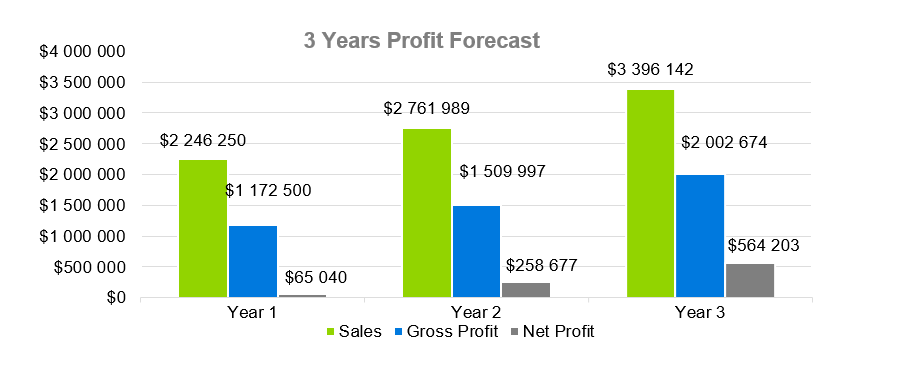
Company Summary
3.1 company owner.
Cocoon Productions will be owned and operated by Calvin Kornwell. He completed his master’s in media studies 4 years back after which he worked for a few production companies. Afterwards, he decided to start his own production company in Illinois.
3.2 Why the Production company is being started
Calvin noticed a lack of supporting production companies in his hometown Illinois. He realized that he could bridge the gap by developing his own production company that focused mainly on supportive functions. He also realized that he could bring a bit of flexibility and innovation to his company that would help it be more beneficial to the aspiring individuals in the entertainment industry.
3.3 How the Production company will be started
Step1: Plan Everything
The first step to starting any business is to write up a business plan for it. So, naturally, you will need to develop a sample business plan production company. You can refer to a template for starting a biodiesel company business plan , etc. to understand the nuances of the document. To help you in creating your business plan, we have provided a reference production management business plan for Cocoon Productions here. You can refer to this document to learn how to make a business plan for a production company.
Step2: Define the Brand
After developing a business plan production company, the next step is to attract customers to your business. For this, you will need to establish a brand for your company that will emphasize your values and benefits to your customers. You will then need to highlight this brand and market it so that your customers can come to you in response.
Step3: Establish Your Corporate Office
Calvin decided to rent out a couple of offices in a commercial building in the business centre of Illinois to start his production company. He will now take care of stocking up on the required equipment to start the business.
Step4: Establish a Web Presence
The success of a business in the entertainment industry is heavily dependent on its reach. Understanding this, Calvin decided to put some manpower towards the creation and maintenance of social media accounts for his production company. He also decided to get a website developed for the business to showcase all the important details and make communication with clients easier.
Step5: Promote and Market
The last step in developing a business is to execute its marketing plan and attract more people to the business.
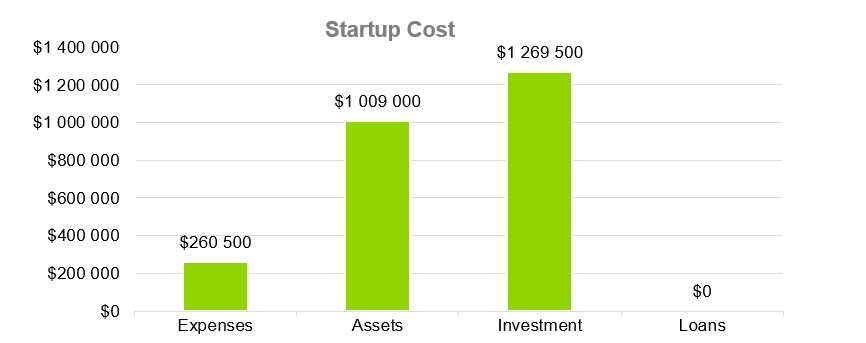
Before you start a production business and start to develop a business plan production, you need to decide on the list of services you will initially be offering to your customers. This filtering is an essential part of describing the production process in business plan. These details in a business plan will help you organize your resources more efficiently so that you can cater to all of your customers in the best way.
Since Calvin decided to offer a wide range of services through his company, Cocoon Productions, you can use this production business plan example to guide the development of a business plan for your business. You can also take a look at guides explaining how to start a candle making business plan for a better idea about explaining your services in a business plan.
Below, we have described the services provided by Cocoon Productions:
- Content Development
Cocoon Production will offer services for the development of different types of media including but not limited to the following:
- Graphic Content
- Sharable Social Media Content
Entertainment companies and media houses usually need to hire talent agencies for casting for different projects. Therefore, we will provide casting services in our company as well.
Just like media companies outsource casting, they often outsource the hiring of the entire production crew. We will offer our clients a developed and filtered list of required candidates for different crew posts.
- Script Writing
We will also offer professional script writing services for our clients. Our clients can hire us for assistance in script and plot development as well as for independent scriptwriting for different projects.
- Logistic and Planning Assistance
Media companies usually handle a lot of projects at the same time. A lot of planning goes into different production projects. Therefore, Cocoon Productions will offer assistance, logistic and planning assistance for our clients as well.
Marketing Analysis of Production Company
When you want to start a business, you should have a deep understanding of the target market. And the best way to gain this kind of insight for your production company is to go through a production business plan sample. Business plan for a production company should contain an analysis of past, present and future market trends. This will help you set prices for your services in a way that is profitable to your business.
excellent work
excellent work, competent advice. Alex is very friendly, great communication. 100% I recommend CGS capital. Thank you so much for your hard work!
To write your business plan for production company, you can take help from an industry business plan. This will guide you when conducting a marketing analysis for your business. A business plan production that contains information about market trends will help you understand your customers better and present your services in a way that gains attraction.
Here, we have described the market trends and customers of Cocoon Productions.
5.1 Market Trends
According to IBISWorld, production companies in the US have a market size of $17 billion with a growth rate of 3.6%. With how much content is consumed daily in just US, there is no expected decline in the industry any time soon. And since the demand is so high, you can be assured that a production company will thrive in the current entertainment climate.
5.2 Marketing Segmentation
The potential customers of Cocoon Productions are categorized as follows:

5.2.1 Event and Live Streamers
Our primary customers will be the agencies holding symposiums and big events. We expect these customers to utilize our services time and time again. So they will be consistent and lucrative clients of the business.
5.2.2 Social Media Marketers
Most corporate agencies have started to embrace the importance of social media in marketing. As such, they will need our services to make videos to post on social media. We expect to gain many corporate clients through this gig.
5.2.3 Big Agencies
Big agencies are always on the lookout for more help on a project here and there. We expect to gain an in into these agencies through our flexible services. So, we expect big agencies to be regular customers as well.
5.2.4 Creative Branding Partners
Lastly, many standalone creative producers and content creators are looking for support. We aim to present our resources to these clients and gain them as long term customers of the business in a content-driven world.
5.3 Business Target
- To become a reliable source of production resources and assistance.
- To expand the services we provide over time.
- To increase the scale of the company over the years.
- To earn a profit margin of around $75k/month at the end of the first 2 years of launch.
- To gain at least 50 regular clients by the end of our third year.
5.4 Product Pricing
Since we are offering a wide variety of services flexibly, our resources will be less pricey as compared to the market standard.
Marketing Strategy
To succeed in a saturated market, you need several competitive advantages over your competitors. And you need to advertise them adequately. The best way to develop and present your brand is by developing a marketing strategy. You need to work on this strategy while creating your production company business plan.
In this sample production company business plan, we are presenting the marketing strategies to be employed by Cocoon Productions. You can use this as a guide to shape your marketing plans.
6.1 Competitive Analysis
- We offer the flexibility of service packages. Our customers don’t have to pay for services they’ll never use.
- We offer support and resources for not just big agencies but also independent content creators.
- We have an excellent rapport with our clients. They can contact us any time they need.
- Our customers can contact us through our website or reach out to us on social media. So there is no need to cover the distance unless the need to.
6.2 Sales Strategy
- We will attract customers through posters, billboards, social media and Google Ads.
- We will offer service packages at a discounted rate for first-time clients
- We will offer regular discounts to regular clients.
- We will offer budget-friendly services to independent creative minds.
6.3 Sales Monthly
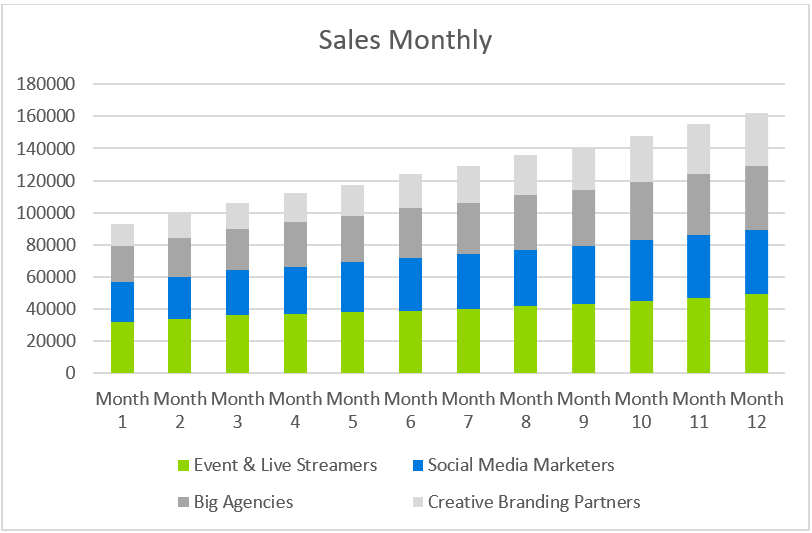
6.4 Sales Yearly
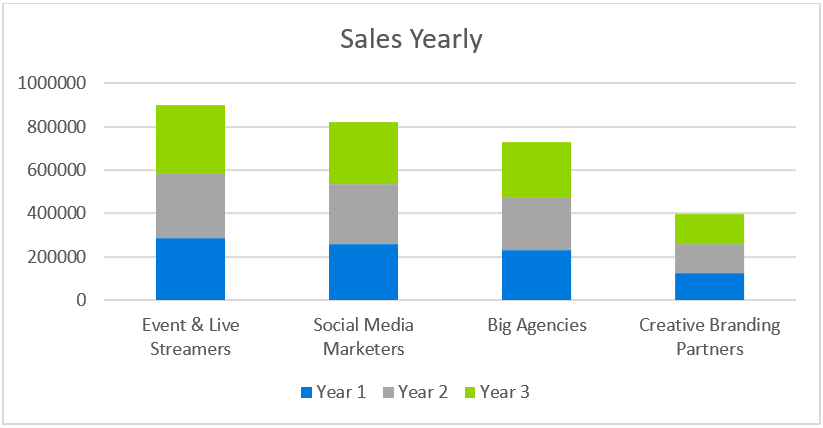
6.5 Sales Forecast
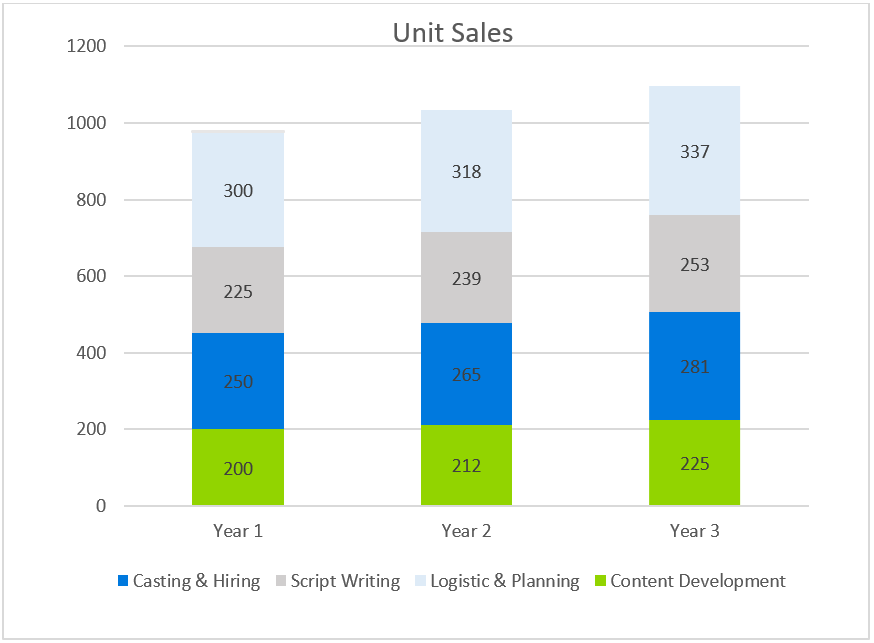
Personnel plan
The success of a business in the entertainment industry needs a lot more than a few clients to be successful. For gaining and retaining clients, the behaviour of employees is essential. Calvin understood the importance of a good rapport between clients and the workforce. Therefore, he decided to implement a selection criterion which he included in the production business plans as well.
To find out how to include details about your employees in your business plans, you can refer to the sample production business plan here.
7.1 Company Staff
- 6 Experienced Production Video Editors
- 6 Experienced Content Creators
- 12 Support Creatives
- 3 Technician to upkeep the machinery
- 1 Web Developer
- 2 Sales Executives to organize and promote sales
- 1 Accountant
7.2 Average Salary of Employees
- Financial Plan
Profits are just one part of the equation of the success of a business. Good management is a very important factor. You need to manage your resources and finances efficiently to make sure that you don’t go into a loss. To ensure good management of all money-related affairs, you will need to conduct a financial analysis. This will help you set the prices of your services in a way that doesn’t bankrupt you and still keeps you attractive to customers.
You can use this production company business plan template to carry out a financial analysis for your business. You can also refer to a production company business plan pdf for help.
Here we’re providing the detailed financial plan for Cocoon Productions. This will help you get a good idea of how to adequately manage your business finances.
8.1 Important Assumptions
8.2 break-even analysis.
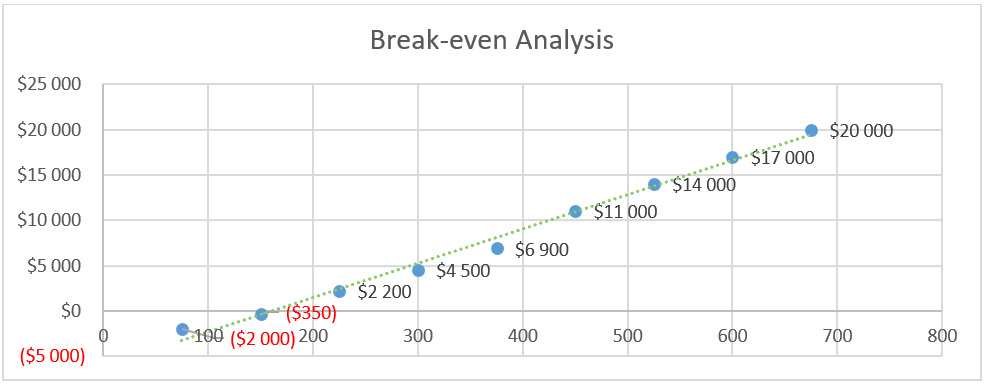
8.3 Projected Profit and Loss
8.3.1 profit monthly.
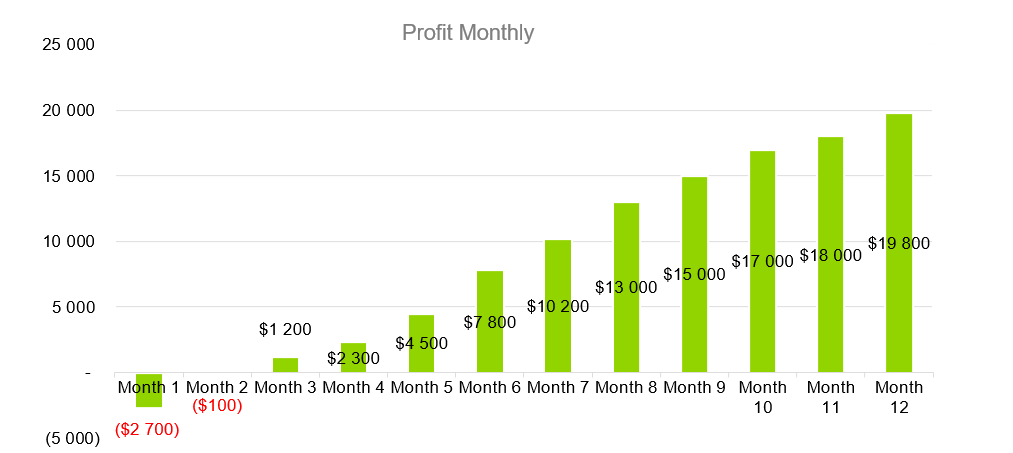
8.3.2 Profit Yearly
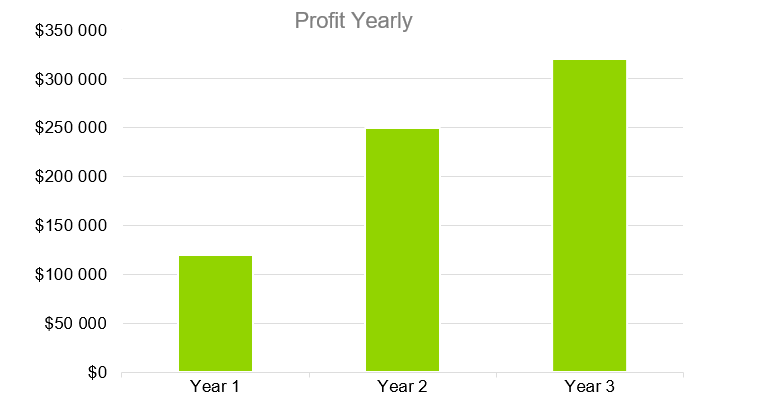
8.3.3 Gross Margin Monthly
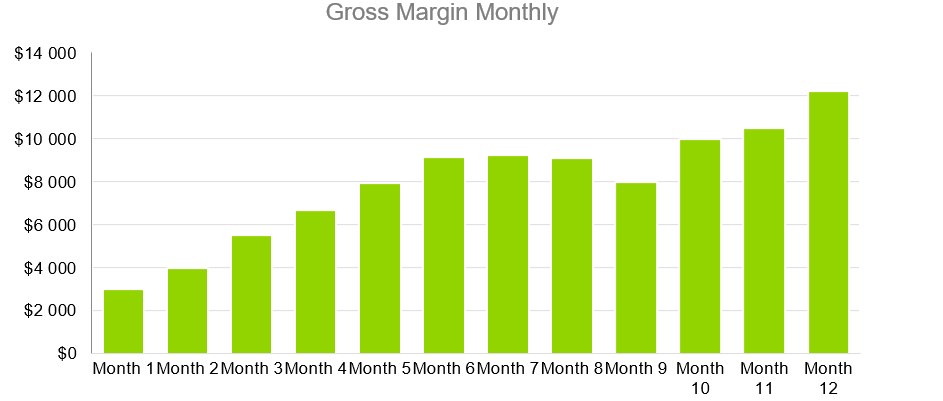
8.3.4 Gross Margin Yearly
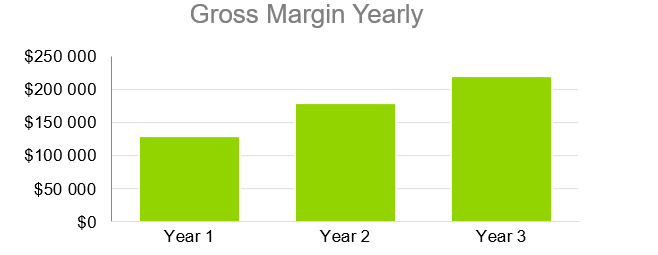
8.4 Projected Cash Flow
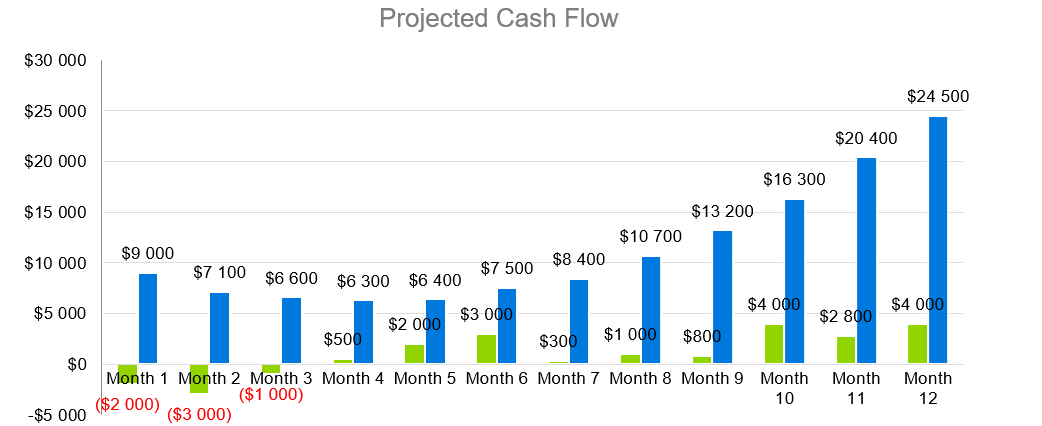
8.5 Projected Balance Sheet
8.6 business ratios.
- How do you write a production plan for a business plan?
You can take a look at the above production company business plan sample to learn how to write a production plan for a business plan.
- What are the 5 basic elements of a business plan?
The 5 basic elements of business plans for production companies or any general business plan are:
- Business Summary
- Services of a business
- Marketing Analysis
- HR Management Plan
- How do I write a simple business plan?
You can write your own business plan by following the template above.
- What are the 4 main parts of a business plan?
These 4 things make an essential part of business plan:
- Management Plan
- Marketing Plan
Download Production Business Plan Sample in pdf
OGSCapital’s team has assisted thousands of entrepreneurs with top-rate business plan development, consultancy and analysis. They’ve helped thousands of SME owners secure more than $1.5 billion in funding, and they can do the same for you.

Add comment
E-mail is already registered on the site. Please use the Login form or enter another .
You entered an incorrect username or password
Comments (0)
mentioned in the press:
Search the site:
OGScapital website is not supported for your current browser. Please use:

Production Planning Template for Excel (Free Download)

In order to be successful, there are many best practices that production facilities need to consider when putting their schedules and plans together. Perhaps most significantly, everyone involved needs to clearly understand every part of the production process, from the small details to the big picture — otherwise, you risk missing key items that could slow down or even halt production.
Having a production plan is a great way to put your production and manufacturing processes on track right from the start, as it helps you prepare for what needs to be done. A production planning template even takes you one step further by providing an outline for your planning process, making it easier to form a cohesive and successful production plan.
What Is Production Planning?
A production plan is a guide that outlines every step involved in the production of a good. With production planning, the production process is more organized and efficient, and there is less of a risk of missing an important step that stops or slows down production. These plans help optimize the manufacturing process, which makes the design, production, and delivery of goods much easier to plan out.
A production plan includes steps for each part of your manufacturing process. This might include what the products are, the type and quantity of materials needed to produce them, the production schedule, and the delivery schedule. It could also include a schedule that shows who is responsible for each part of the process.
Most production plans include details about which machines are needed during the process, how many pieces of equipment are involved, and what quality assurance steps need to be taken before the product is ready for final delivery.
Why Is Production Planning Important?
Like most processes, planning plays an integral part of the production process. When you have a solid plan in place from the beginning, you have clear targets and a firm idea of what needs to happen in order to meet your goals. This reduces the chances of bottlenecks, which can lead to slowdowns that impede your productivity.
The ultimate goal of production planning is to create a more streamlined production process that lends itself to greater efficiency. More efficient processes lead to overall improvement in metrics and key performance indicators (KPIs). Tracking metrics and KPIs via digital tools and dashboards gives you at-a-glance insights into whether or not you are meeting production goals — which can let you know if your production plan needs to be tweaked.
Production planning also helps manufacturing businesses be better at resource management and capacity planning. Rather than having an overabundance of raw materials (or not enough) for production, you can plan out exactly what you need and avoid supply chain hold ups or unnecessary expenses. This gives you greater control over your inventory management and improves your lead times as well.
Another benefit of production planning is the internal alignment it creates. A clear production plan can be shared across your organization, from machine operators to upper management, which keeps everyone on the same page regarding production. When everyone is working from the same plan, you can more easily avoid internal conflict and confusion surrounding production, while also creating a more streamlined workflow across teams with fewer bottlenecks.
Breakout: What Is the Difference Between a Production Schedule and a Production Plan ?
Often, there is confusion around the terms “production schedule” and “production plan.” Both deal with the organization and high-level strategies around production, and while there are similarities, the two terms mean different things. A production schedule has clearly defined and assigned roles for each step of the manufacturing process, along with the timeline for when those tasks need to be accomplished.
The production plan, on the other hand, determines what needs to be produced and how much of it needs to be completed in each run. Another way to think about the two is that the production plan outlines the “what” — the steps and materials needed to produce a good — while the production schedule outlines the “who” and “when” — who is responsible for each step of the process and when they need to have them done.
What Are the 3 Stages of Production Planning?
There are three major stages of production planning that an organization needs to follow. If you complete the stages out of order or leave one out entirely, your production plan could end up being incomplete. This can lead to missed steps and bottlenecks that cause issues throughout the entire production process. Next, we’ll take a look at each phase in greater detail.
Planning Phase
The planning phase addresses the end goals of your production process and helps you determine what type of schedule and plan is best suited to help you achieve your goals. This could include steps like:
- Product development
- Sales forecasting
- Aggregate planning
- Raw material planning
Action Phase
The action phase of the production plan outlines the different steps that need to be taken in order to create the product that your plan is for. This phase addresses all of the steps of production, from the initial job order to the final delivery and everything in between. Those specific steps might include:
- Process routing
- Material planning
- Tool planning
- Machine loading
Control Phase
The final stage of the production planning process is the control phase. This phase helps ensure that all the other steps in the planning and action phases are measured and reported correctly, which ensures that end goals are being met. This also includes any measures needed to fix errors in the plan and addresses any mistakes that might come up during the production process. The main steps in this phase are:
- Progress reporting
- Metric tracking
- Corrective action planning
What Are the Benefits of a Production Plan?
A production plan provides many different benefits that organizations across the globe can benefit from. It provides clear benchmarks for measuring key elements of the production process and ensures that the entire organization is clear about what the production process is. When manufacturers utilize a production plan, they can avoid confusion, waste, and delays. This helps provide a better customer experience and makes sure that manufacturers deliver on the promises they make to suppliers and purchasers. Other benefits include:
- Resource management
- Supply chain planning
- Internal project alignment
- Goal and milestone tracking
- Increased clarity
- Singular database for tracking and minimizing backlogs
- Team-wide visibility into production
- Streamlined workflows
While production planning offers many different benefits, many manufacturers may still shy away from the idea because the process of creating the plan is too overwhelming to think about. Luckily, Anvyl’s production planning template alleviates the pressure of building a plan from scratch, which can get your organization on the right track much sooner.
Download Anvyl’s Production Planning Template
How Do You Create a Production Plan in Excel?
Many production plans are built using spreadsheet software like Microsoft Excel or Google Sheets. You can use these programs to create Gantt charts, which clearly lay out the different elements of the production process in a visual format. This helps with project management and tracking everything from customer orders to the bill of material that is required for each product. These are simplistic charts that any member of your team can follow.
A production plan includes details like:
- Company information
- Customer information
- Current order status
- Production or product numbers
- Product variations
- Starting inventory
- Current inventory
- Manufacturing dates
- Operator or management notes
Each organization functions differently, so no two production plans will be the same. There will be some level of customization required, even if the plan comes from a standardized template.
An Excel template can work as a jumping-off point, allowing your business to build around your own goals and needs without starting from scratch. Keep in mind that a template should be flexible enough to allow for personalization while also being rigid enough that you don’t miss vital steps. The Anvyl production planning template was built with this mentality: to help manufacturers improve their processes and create a better production planning experience with a unique, customizable approach.
Try Anvyl’s Free Production Planning Template
At Anvyl, we understand that there are a lot of considerations to keep in mind as you work on creating your production plan. This is why we provide a planning template that you can use to optimize your production planning, project management, and capacity planning — all while reducing bottlenecks and avoiding production shutdowns.
The Anvyl production planning template was created to make the entire process of production planning easier for you and your team. Rather than creating a production plan from scratch, you can get started faster by using our template. The legwork is already done for you — all you need to do is customize the Excel spreadsheet to fit your business.
Get your free download of our production planning template and get started today .
Take Control of Your Production Process With Anvyl
Having control over your production process ensures that you are optimized for success and efficiency. When you don’t have a production plan, it’s hard to see whether or not you’re hitting your benchmarks — which makes it even harder to hit your goals.
When you have a well-constructed production plan organized in a versatile Excel template, you can build a strong production process that can withstand challenges and produce the results that your organization desires.
Investing in a platform that helps you streamline your processes is a great way to benefit your business. With resources like Anvyl, you can create a centralized database and manage your supplier relations with ease. Our team has been helping manufacturers manage their production planning for many years — try a product demo to learn more about what Anvyl can do for your organization.
Related Posts
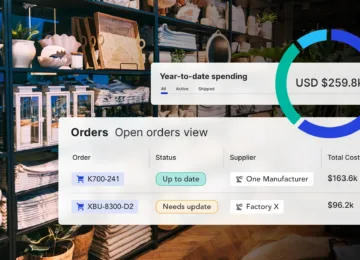
Purchase Order Management Best Practices for Home Goods and Furniture Brands

Women in Supply Chain Series: Petra Jordan

3 Key Takeaways on Navigating the Future of Supply Chain
Ready to get started.
Explore how Anvyl can help you manage your production process today.
Business Plan Template for Video Production
- Great for beginners
- Ready-to-use, fully customizable Subcategory
- Get started in seconds

Are you an entrepreneur or a video production company in the media and entertainment industry? If so, you know that having a solid business plan is crucial for success. With ClickUp's Business Plan Template for Video Production, you can outline your strategies, set objectives, and forecast your financial projections—all in one place!
This template is specifically designed to help you secure funding, attract investors, and guide the overall direction of your video production business. With ClickUp, you can:
- Plan and organize your marketing strategies, production processes, and distribution channels
- Track and manage your financials, including revenue streams, expenses, and profitability
- Collaborate with team members and stakeholders to ensure everyone is aligned towards your business goals
Don't let the complexities of the video production industry hold you back. Use ClickUp's Business Plan Template for Video Production to take your business to new heights. Get started today and make your vision a reality!
Business Plan Template for Video Production Benefits
A business plan template for video production can offer a range of benefits for entrepreneurs and video production companies in the media and entertainment industry. Some of these benefits include:
- Providing a clear roadmap for your video production business, outlining strategies and objectives
- Guiding decision-making and helping you stay focused on your goals
- Assisting in securing funding and attracting potential investors by showcasing your vision and financial projections
- Ensuring a comprehensive understanding of the market, competition, and target audience
- Facilitating effective project management and resource allocation for successful video production
- Helping you stay organized and accountable for the growth and success of your video production business.
Main Elements of Video Production Business Plan Template
When it comes to creating a comprehensive business plan for your video production company, ClickUp has you covered with its Business Plan Template for Video Production. Here are the key elements of this template:
- Custom Statuses: Keep track of your progress with statuses such as Complete, In Progress, Needs Revision, and To Do, ensuring that every aspect of your business plan is accounted for and easily managed.
- Custom Fields: Utilize important custom fields like Reference, Approved, and Section to organize and categorize information within your business plan, making it easier to navigate and update as needed.
- Custom Views: Access five different views including Topics, Status, Timeline, Business Plan, and Getting Started Guide to gain different perspectives on your video production business plan, ensuring a clear understanding of objectives, timelines, and progress.
- Collaboration: Collaborate seamlessly with your team on the business plan, assigning tasks, setting due dates, and monitoring progress using ClickUp's task management features.
- Documentation: Centralize all relevant documents, contracts, and financial projections within the template using ClickUp's Docs feature, ensuring that all essential information is easily accessible in one place.
With ClickUp's Business Plan Template for Video Production, you'll have the tools you need to create a well-structured and organized business plan that sets your video production company up for success.
How To Use Business Plan Template for Video Production
If you're in the video production industry and need to create a business plan, the Business Plan Template in ClickUp can help you get started. Follow these steps to effectively use the template:
1. Define your vision and goals
Start by determining your vision for your video production business. What do you want to achieve? What services do you want to offer? Set clear and measurable goals that align with your vision.
Use the Goals feature in ClickUp to create and track your business goals for your video production company.
2. Conduct market research
Before diving into your business plan, it's crucial to understand the market and your target audience. Research your competitors, industry trends, and customer preferences to gain insights that will guide your business decisions.
Use the Docs feature in ClickUp to compile your market research findings and create a comprehensive analysis.
3. Develop your marketing and sales strategy
A strong marketing and sales strategy is essential for the success of your video production business. Determine how you will reach and attract clients, and outline your pricing structure and sales tactics. Identify your unique selling proposition (USP) and highlight your competitive advantage.
Utilize the Board view in ClickUp to create a visual representation of your marketing and sales strategy, including different stages of client acquisition and conversion.
4. Outline your financial projections
Financial projections play a crucial role in your business plan, as they demonstrate the viability and profitability of your video production company. Estimate your revenue streams, production costs, overhead expenses, and expected profits. Consider factors such as equipment, personnel, and marketing costs.
Use the Table view in ClickUp to create a financial projection spreadsheet, including revenue forecasts, expense breakdowns, and cash flow analysis.
By following these steps and using the Business Plan Template in ClickUp, you can create a comprehensive and effective business plan for your video production company. Remember to regularly review and update your plan as your business evolves and new opportunities arise.
Get Started with ClickUp’s Business Plan Template for Video Production
Entrepreneurs or video production companies in the media and entertainment industry can use the Business Plan Template for Video Production in ClickUp to create a comprehensive plan that outlines their strategies, objectives, and financial projections.
To get started, hit “Add Template” to sign up for ClickUp and add the template to your Workspace. Make sure you designate which Space or location in your Workspace you’d like this template applied.
Next, invite relevant members or guests to your Workspace to start collaborating.
Now you can take advantage of the full potential of this template to create a successful video production business:
- Use the Topics View to brainstorm and organize different sections of your business plan
- The Status View will help you track the progress of each section, with statuses like Complete, In Progress, Needs Revision, and To Do
- The Timeline View will give you a visual representation of your business plan's timeline and milestones
- The Business Plan View will provide a comprehensive overview of your entire plan, including strategies, objectives, and financial projections
- The Getting Started Guide View will serve as a step-by-step guide to help you navigate through the template and complete each section
- Utilize the custom fields Reference, Approved, and Section to add additional information and categorize your business plan
- Update statuses and custom fields as you work through each section to keep team members informed of progress
- Monitor and analyze your business plan to ensure it aligns with your goals and attracts investors.
- Business Plan Template for Models
- Business Plan Template for Bartenders
- Business Plan Template for Offshore Teams
- Business Plan Template for Oracle
- Business Plan Template for Training And Development
Template details
Free forever with 100mb storage.
Free training & 24-hours support
Serious about security & privacy
Highest levels of uptime the last 12 months
- Product Roadmap
- Affiliate & Referrals
- On-Demand Demo
- Integrations
- Consultants
- Gantt Chart
- Native Time Tracking
- Automations
- Kanban Board
- vs Airtable
- vs Basecamp
- vs MS Project
- vs Smartsheet
- Software Team Hub
- PM Software Guide
How to write a business plan for a video production company?
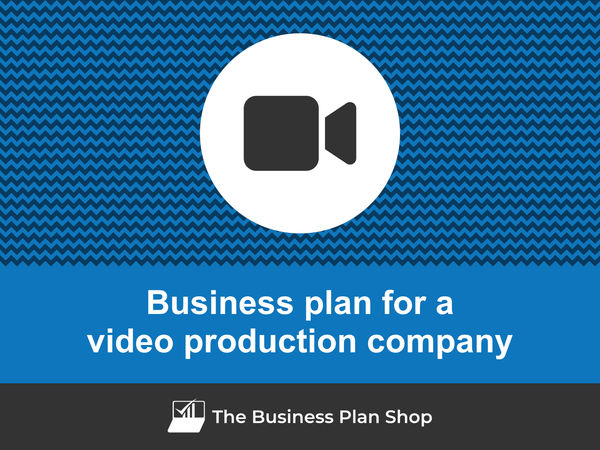
Putting together a business plan for a video production company can be daunting - especially if you're creating a business for the first time - but with this comprehensive guide, you'll have the necessary tools to do it confidently.
We will explore why writing one is so important in both starting up and growing an existing video production company, as well as what should go into making an effective plan - from its structure to content - and what tools can be used to streamline the process and avoid errors.
Without further ado, let us begin!
In this guide:
Why write a business plan for a video production company?
- What information is needed to create a business plan for a video production company?
- How do I build a financial forecast for a video production company?
The written part of a video production company business plan
- What tool should I use to write my video production company business plan?
Understanding the document's scope and goals will help you easily grasp its structure and content. Before diving into the specifics of the plan, let's take a moment to explore the key reasons why having a video production company business plan is so crucial.
To have a clear roadmap to grow the business
Running a small business is tough! Economic cycles bring growth and recessions, while the business landscape is ever-changing with new technologies, regulations, competitors, and consumer behaviours emerging constantly.
In such a dynamic context, operating a business without a clear roadmap is akin to driving blindfolded: it's risky, to say the least. That's why crafting a business plan for your video production company is vital to establish a successful and sustainable venture.
To create an effective business plan, you'll need to assess your current position (if you're already in business) and define where you want the business to be in the next three to five years.
Once you have a clear destination for your video production company, you'll have to:
- Identify the necessary resources (human, equipment, and capital) needed to reach your goals,
- Determine the pace at which the business needs to progress to meet its objectives as scheduled,
- Recognize and address the potential risks you may encounter along the way.
Engaging in this process regularly proves advantageous for both startups and established companies. It empowers you to make informed decisions about resource allocation, ensuring the long-term success of your business.
To maintain visibility on future cash flows
Businesses can go for years without making a profit, but they go bust as soon as they run out of cash. That's why "cash is king", and maintaining visibility on your video production company's future cash flows is critical.
How do I do that? That's simple: you need an up-to-date financial forecast.
The good news is that your video production company business plan already contains a financial forecast (more on that later in this guide), so all you have to do is to keep it up-to-date.
To do this, you need to regularly compare the actual financial performance of your business to what was planned in your financial forecast, and adjust the forecast based on the current trajectory of your business.
Monitoring your video production company's financial health will enable you to identify potential financial problems (such as an unexpected cash shortfall) early and to put in place corrective measures. It will also allow you to detect and capitalize on potential growth opportunities (higher demand from a given segment of customers for example).
To secure financing
A detailed business plan becomes a crucial tool when seeking financing from banks or investors for your video production company.
Investing and lending to small businesses are very risky activities given how fragile they are. Therefore, financiers have to take extra precautions before putting their capital at risk.
At a minimum, financiers will want to ensure that you have a clear roadmap and a solid understanding of your future cash flows (like we just explained above). But they will also want to ensure that your business plan fits the risk/reward profile they seek.
This will off-course vary from bank to bank and investor to investor, but as a rule of thumb. Banks will want to see a conservative financial management style (low risk), and they will use the information in your business plan to assess your borrowing capacity — the level of debt they think your business can comfortably handle — and your ability to repay the loan. This evaluation will determine whether they'll provide credit to your video production company and the terms of the agreement.
Whereas investors will carefully analyze your business plan to gauge the potential return on their investment. Their focus lies on evidence indicating your video production company's potential for high growth, profitability, and consistent cash flow generation over time.
Now that you recognize the importance of creating a business plan for your video production company, let's explore what information is required to create a compelling plan.
Information needed to create a business plan for a video production company
Drafting a video production company business plan requires research so that you can project sales, investments and cost accurately in your financial forecast, and convince the reader that there is a viable commercial opportunity to be seized.
Below, we'll focus on three critical pieces of information you should gather before starting to write your plan.
Carrying out market research for a video production company
Carrying out market research before writing a business plan for a video production company is essential to ensure that the financial projections are accurate and realistic.
Market research helps you gain insight into your target customer base, competitors, pricing strategies and other key factors which can have an impact on the commercial success of your business.
In particular, it is useful in forecasting revenue as it provides valuable data regarding potential customers’ spending habits and preferences.
You may find that there is a growing demand for video production services from businesses that are looking to produce promotional content for their online channels. Additionally, you could discover that there is a potential market for producing educational videos, as more people may be turning to online learning platforms.
This information can then be used to create more accurate financial projections which will help investors make informed decisions about investing in your video production company.
Developing the marketing plan for a video production company
Before delving into your video production company business plan, it's imperative to budget for sales and marketing expenses.
To achieve this, a comprehensive sales and marketing plan is essential. This plan should provide an accurate projection of the necessary actions to acquire and retain customers.
Additionally, it will outline the required workforce to carry out these initiatives and the corresponding budget for promotions, advertising, and other marketing endeavours.
By budgeting accordingly, you can ensure that the right resources are allocated to these vital activities, aligning them with the sales and growth objectives outlined in your business plan.
The staffing and equipment needs of a video production company
As you embark on starting or expanding your video production company, having a clear plan for recruitment and capital expenditures (investment in equipment and real estate) is essential for ensuring your business's success.
Both the recruitment and investment plans must align with the timing and level of growth projected in your forecast, and they require appropriate funding.
A video production company might incur staffing costs such as hiring a camera operator, sound technician, lighting technician, and editor. They might also incur equipment costs such as renting a camera, lighting, microphones, and other necessary production equipment.
To create a realistic financial forecast, you also need to consider other operating expenses associated with the day-to-day running of your business, such as insurance and bookkeeping.
With all the necessary information at hand, you are ready to begin crafting your business plan and developing your financial forecast.
What goes into your video production company's financial forecast?
The objective of the financial forecast of your video production company's business plan is to show the growth, profitability, funding requirements, and cash generation potential of your business over the next 3 to 5 years.
The four key outputs of a financial forecast for a video production company are:
- The profit and loss (P&L) statement ,
- The projected balance sheet ,
- The cash flow forecast ,
- And the sources and uses table .
Let's look at each of these in a bit more detail.
The projected P&L statement
Your video production company forecasted P&L statement enables the reader of your business plan to get an idea of how much revenue and profits your business is expected to make in the near future.
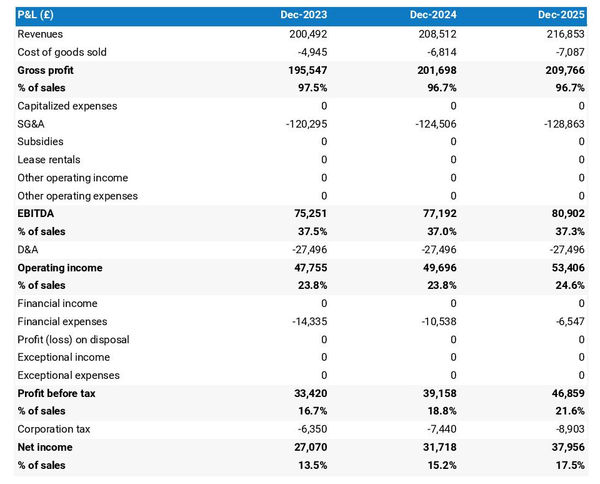
Ideally, your reader will want to see:
- Growth above the inflation level
- Expanding profit margins
- Positive net profit throughout the plan
Expectations for an established video production company will of course be different than for a startup. Existing businesses which have reached their cruising altitude might have slower growth and higher margins than ventures just being started.
The forecasted balance sheet of your video production company
The projected balance sheet of your video production company will enable the reader of your business plan to assess the overall financial health of your business.
It shows three elements: assets, liabilities and equity:
- Assets: are productive resources owned by the business, such as equipment, cash, and accounts receivable (money owed by clients).
- Liabilities: are debts owed to creditors, lenders, and other entities, such as accounts payable (money owed to suppliers).
- Equity: includes the sums invested by the shareholders or business owners and the profits and losses accumulated by the business to date (which are called retained earnings). It is a proxy for the value of the owner's stake in the business.
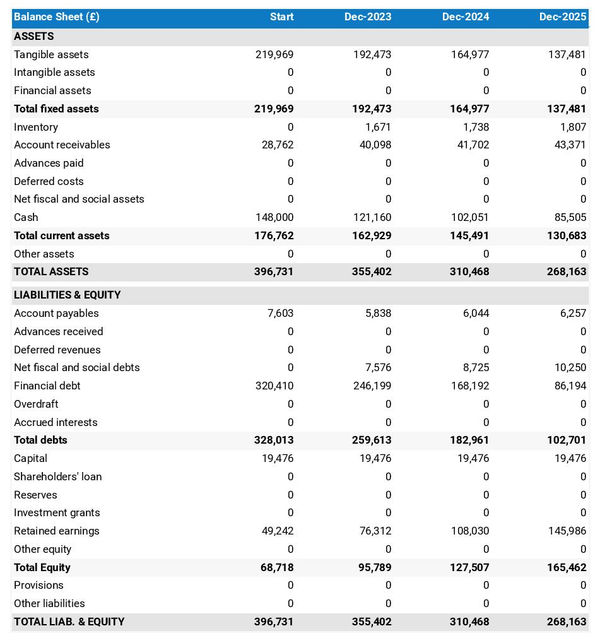
Analysing your video production company projected balance sheet provides an understanding of your video production company's working capital structure, investment and financing policies.
In particular, the readers of your plan can compare the level of financial debt on the balance sheet to the equity value to measure the level of financial risk (equity doesn't need to be reimbursed, while financial debt must be repaid, making it riskier).
They can also use your balance sheet to assess your video production company's liquidity and solvency:
- A liquidity analysis: focuses on whether or not your business has sufficient cash and short-term assets to cover its liabilities due in the next 12 months.
- A solvency analysis: takes and longer view to assess whether or not your business has the capacity to repay its debts over the medium-term.
The cash flow forecast
A projected cash flow statement for a video production company is used to show how much cash the business is generating or consuming.
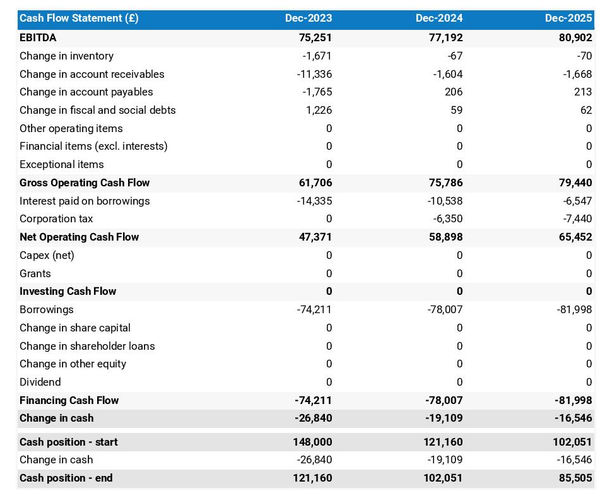
The cash flow forecast is usually organized by nature to show three key metrics:
- The operating cash flow: do the core business activities generate or consume cash?
- The investing cash flow: how much is the business investing in long-term assets (this is usually compared to the level of fixed assets on the balance sheet to assess whether the business is regularly maintaining and renewing its equipment)?
- The financing cash flow: is the business raising new financing or repaying financiers (debt repayment, dividends)?
As we discussed earlier, cash is king and keeping an eye on future cash flows an imperative for running a successful business. Therefore, you can expect the reader of your video production company business plan to pay close attention to your cash flow forecast.
Also, note that it is customary to provide both yearly and monthly cash flow forecasts in a business plan - so that the reader can analyze seasonal variation and ensure the video production company is appropriately funded.
The initial financing plan
The sources and uses table or initial financing plan is a key component of your business plan when starting a video production company.
It shows where the capital needed to set up the business will come from (sources) and how it will be spent (uses).

This table helps size the investment required to set up the video production company, and understand how risks will be distributed between the business owners, and the financiers.
The sources and uses table also highlights what the starting cash position will be. This is key for startups as the business needs to have sufficient funding to sustain operations until the break-even point is reached.
Now that you have a clear understanding of what will go into the financial forecast of your video production company business plan, let's have a look at the written part of the plan.
The written part of the business plan is where you will explain what your business does and how it operates, what your target market is, whom you compete against, and what strategy you will put in place to seize the commercial opportunity you've identified.
Having this context is key for the reader to form a view on whether or not they believe that your plan is achievable and the numbers in your forecast realistic.
The written part of a video production company business plan is composed of 7 main sections:
- The executive summary
- The presentation of the company
- The products and services
- The market analysis
- The strategy
- The operations
- The financial plan
Let's go through the content of each section in more detail!
1. The executive summary
The executive summary, the first section of your video production company's business plan, serves as an inviting snapshot of your entire plan, leaving readers eager to know more about your business.
To compose an effective executive summary, start with a concise introduction of your business, covering its name, concept, location, history, and unique aspects. Share insights about the services or products you intend to offer and your target customer base.
Subsequently, provide an overview of your video production company's addressable market, highlighting current trends and potential growth opportunities.
Then, present a summary of critical financial figures, such as projected revenues, profits, and cash flows.
You should then include a summary of your key financial figures such as projected revenues, profits, and cash flows.
Lastly, address any funding needs in the "ask" section of your executive summary.
2. The presentation of the company
In your video production company business plan, the second section should focus on the structure and ownership, location, and management team of your company.
In the structure and ownership part, you'll provide an overview of the business's legal structure, details about the owners, and their respective investments and ownership shares. This clarity is crucial, especially if you're seeking financing, as it helps the reader understand which legal entity will receive the funds and who controls the business.
Moving on to the location part, you'll offer an overview of the company's premises and their surroundings. Explain why this particular location is of interest, highlighting factors like catchment area, accessibility, and nearby amenities.
When describing the location of your video production company, you may want to highlight the local access to a variety of resources that could benefit your business. You could point out the potential to tap into a large pool of creative talent that may be available in the local area. Additionally, you may want to emphasize the potential for easy access to a wide variety of filming locations, as well as potential tax incentives that could be available. All of these elements could be attractive to a third-party financier.
Finally, you should introduce your management team. Describe each member's role, background, and experience.
Don't forget to emphasize any past successes achieved by the management team and how long they've been working together. Demonstrating their track record and teamwork will help potential lenders or investors gain confidence in their leadership and ability to execute the business plan.
3. The products and services section
The products and services section of your video production company business plan should include a detailed description of what your company sells to its customers.
For example, your video production company might offer customers video production services such as filming, editing, and animation; video marketing services such as creating and promoting videos for social media platforms; and video consulting services such as helping clients to develop a video strategy. These products and services can help customers to create content that is engaging and tailored to meet their needs, while helping them to reach new audiences and grow their business.
The reader will want to understand what makes your video production company unique from other businesses in this competitive market.
When drafting this section, you should be precise about the categories of products or services you sell, the clients you are targeting and the channels that you are targeting them through.
4. The market analysis
When outlining your market analysis in the video production company business plan, it's essential to include comprehensive details about customers' demographics and segmentation, target market, competition, barriers to entry, and relevant regulations.
The primary aim of this section is to give the reader an understanding of the market size and appeal while demonstrating your expertise in the industry.
To begin, delve into the demographics and segmentation subsection, providing an overview of the addressable market for your video production company, key marketplace trends, and introducing various customer segments and their preferences in terms of purchasing habits and budgets.
Next, shift your focus to the target market subsection, where you can zoom in on the specific customer segments your video production company targets. Explain how your products and services are tailored to meet the unique needs of these customers.
For example, your target market might include small businesses. These customers may be looking for an affordable way to create promotional videos to market their products or services. They may also be seeking assistance in making short videos to post on their social media channels.
In the competition subsection, introduce your main competitors and explain what sets your video production company apart from them.
Finally, round off your market analysis by providing an overview of the main regulations that apply to your video production company.
5. The strategy section
When writing the strategy section of a business plan for your video production company, it is essential to include information about your competitive edge, pricing strategy, sales & marketing plan, milestones, and risks and mitigants.
The competitive edge subsection should explain what sets your company apart from its competitors. This part is especially key if you are writing the business plan of a startup, as you have to make a name for yourself in the marketplace against established players.
The pricing strategy subsection should demonstrate how you intend to remain profitable while still offering competitive prices to your customers.
The sales & marketing plan should outline how you intend to reach out and acquire new customers, as well as retain existing ones with loyalty programs or special offers.
The milestones subsection should outline what your company has achieved to date, and its main objectives for the years to come - along with dates so that everyone involved has clear expectations of when progress can be expected.
The risks and mitigants subsection should list the main risks that jeopardize the execution of your plan and explain what measures you have taken to minimize these. This is essential in order for investors or lenders to feel secure in investing in your venture.
Your video production company could face a variety of risks. For example, there might be a risk of not meeting deadlines due to unanticipated events, such as equipment malfunction or illness. Additionally, there could be the risk of not obtaining the necessary permissions or rights to use copyrighted material. Taking the time to understand these risks and plan for them may help to mitigate potential losses.
6. The operations section
The operations of your video production company must be presented in detail in your business plan.
The first thing you should cover in this section is your staffing team, the main roles, and the overall recruitment plan to support the growth expected in your business plan. You should also outline the qualifications and experience necessary to fulfil each role, and how you intend to recruit (using job boards, referrals, or headhunters).
You should then state the operating hours of your video production company - so that the reader can check the adequacy of your staffing levels - and any plans for varying opening times during peak season. Additionally, the plan should include details on how you will handle customer queries outside of normal operating hours.
The next part of this section should focus on the key assets and IP required to operate your business. If you depend on any licenses or trademarks, physical structures (equipment or property) or lease agreements, these should all go in there.
You may have key assets such as expensive camera equipment and editing software that could be of great value to the company. Additionally, the company might have intellectual property such as scripts that could be used to produce original content or existing footage and audio that could be used to create compelling videos.
Finally, you should include a list of suppliers that you plan to work with and a breakdown of their services and main commercial terms (price, payment terms, contract duration, etc.). Investors are always keen to know if there is a particular reason why you have chosen to work with a specific supplier (higher-quality products or past relationships for example).
7. The presentation of the financial plan
The financial plan section is where we will include the financial forecast we discussed earlier in this guide.
Now that you have a clear idea of what goes into a video production company business plan, let's look at some of the tools you can use to create yours efficiently.
What tool should I use to write my video production company's business plan?
There are two main ways of creating your video production company business plan:
- Using specialized business planning software,
- Hiring a business plan writer.
Using an online business plan software for your video production company's business plan
Using online business planning software is the most efficient and modern way to write a video production company business plan.
There are several advantages to using specialized software:
- You can easily create your financial forecast by letting the software take care of the financial calculations for you without errors
- You are guided through the writing process by detailed instructions and examples for each part of the plan
- You can access a library of dozens of complete business plan samples and templates for inspiration
- You get a professional business plan, formatted and ready to be sent to your bank or investors
- You can easily track your actual financial performance against your financial forecast
- You can create scenarios to stress test your forecast's main assumptions
- You can easily update your forecast as time goes by to maintain visibility on future cash flows
- You have a friendly support team on standby to assist you when you are stuck
If you're interested in using this type of solution, you can try The Business Plan Shop for free by signing up here .
Hiring a business plan writer to write your video production company's business plan
Outsourcing your video production company business plan to a business plan writer can also be a viable option.
These writers possess valuable experience in crafting business plans and creating accurate financial forecasts. Additionally, enlisting their services can save you precious time, enabling you to concentrate on the day-to-day operations of your business.
It's important to be mindful, though, that hiring business plan writers comes with a cost. You'll be paying not just for their time but also for the software they use, and their profit margin.
Based on experience, a complete business plan usually requires a budget of at least £1.5k ($2.0k) excluding tax, and more if revisions are needed after initial meetings with lenders or investors - changes often arise following these discussions.
When seeking investment, be cautious about spending too much on consulting fees. Investors prefer their funds to contribute directly to business growth. Thus, the amount you spend on business plan writing services and other consulting services should be negligible compared to the amount you raise.
Another aspect to consider is that while you'll receive the output of the business plan, you usually won't own the actual document. It will be saved in the consultant's business plan software, which will make updating the plan challenging without retaining the consultant on a retainer.
Given these factors, it's essential to carefully weigh the pros and cons of outsourcing your video production company business plan to a business plan writer and decide what best suits your business's unique needs.
Why not create your video production company's business plan using Word or Excel?
I must advise against using Microsoft Excel and Word (or their Google, Apple, or open-source equivalents) to write your video production company business plan. Let me explain why.
Firstly, creating an accurate and error-free financial forecast on Excel (or any spreadsheet) is highly technical and requires a strong grasp of accounting principles and financial modelling skills. It is, therefore, unlikely that anyone will fully trust your numbers unless you have both a degree in finance and accounting and significant financial modelling experience, like us at The Business Plan Shop.
Secondly, relying on spreadsheets is inefficient. While it may have been the only option in the past, technology has advanced significantly, and software can now perform these tasks much faster and with greater accuracy. With the rise of AI, software can even help us detect mistakes in forecasts and analyze the numbers for better decision-making.
And with the rise of AI, software is also becoming smarter at helping us detect mistakes in our forecasts and helping us analyse the numbers to make better decisions.
Moreover, software makes it easier to compare actuals versus forecasts and maintain up-to-date forecasts to keep visibility on future cash flows, as we discussed earlier in this guide. This task is cumbersome when using spreadsheets.
Now, let's talk about the written part of your video production company business plan. While it may be less error-prone, using software can bring tremendous gains in productivity. Word processors, for example, lack instructions and examples for each part of your business plan. They also won't automatically update your numbers when changes occur in your forecast, and they don't handle formatting for you.
Overall, while Word or Excel may seem viable for some entrepreneurs to create a business plan, it's by far becoming an antiquated way of doing things.
- Using business plan software is a modern and cost-effective way of writing and maintaining business plans.
- A business plan is not a one-shot exercise as maintaining it current is the only way to keep visibility on your future cash flows.
- A business plan has 2 main parts: a financial forecast outlining the funding requirements of your video production company and the expected growth, profits and cash flows for the next 3 to 5 years; and a written part which gives the reader the information needed to decide if they believe the forecast is achievable.
We hope that this in-depth guide met your expectations and that you now have a clear understanding of how to write your video production company business plan. Do not hesitate to contact our friendly team if you have questions additional questions we haven't addressed here.
Also on The Business Plan Shop
- How to write a business plan to secure a bank loan?
- Key steps to write a business plan?
- Top mistakes to avoid in your business plan
Do you know entrepreneurs interested in starting or growing a video production company? Share this article with them!

Founder & CEO at The Business Plan Shop Ltd
Guillaume Le Brouster is a seasoned entrepreneur and financier.
Guillaume has been an entrepreneur for more than a decade and has first-hand experience of starting, running, and growing a successful business.
Prior to being a business owner, Guillaume worked in investment banking and private equity, where he spent most of his time creating complex financial forecasts, writing business plans, and analysing financial statements to make financing and investment decisions.
Guillaume holds a Master's Degree in Finance from ESCP Business School and a Bachelor of Science in Business & Management from Paris Dauphine University.
Create a convincing business plan
Assess the profitability of your business idea and create a persuasive business plan to pitch to investors

500,000+ entrepreneurs have already tried our solution - why not join them?
Not ready to try our on-line tool ? Learn more about our solution here
Need some inspiration for your business plan?
Subscribe to The Business Plan Shop and gain access to our business plan template library.

Need a professional business plan? Discover our solution
Write your business plan with ease!

It's easy to create a professional business plan with The Business Plan Shop
Want to find out more before you try? Learn more about our solution here

Researched by Consultants from Top-Tier Management Companies

Powerpoint Templates
Icon Bundle
Kpi Dashboard
Professional
Business Plans
Swot Analysis
Gantt Chart
Business Proposal
Marketing Plan
Project Management
Business Case
Business Model
Cyber Security
Business PPT
Digital Marketing
Digital Transformation
Human Resources
Product Management
Artificial Intelligence
Company Profile
Acknowledgement PPT
PPT Presentation
Reports Brochures
One Page Pitch
Interview PPT
All Categories
Top 10 Production Schedule Templates with Samples And Examples [Free PDF Attached]
![production in business plan example Top 10 Production Schedule Templates with Samples And Examples [Free PDF Attached]](https://www.slideteam.net/wp/wp-content/uploads/2022/10/Production-Schedule-Example-Templates-1-1013x441.png)
Dikshita Sharma
“Productivity is never an accident. It is always the result of a commitment to excellence, intelligent planning, and focused efforts,” Paul J. Meyer, the pioneer of the self-improvement industry, has enunciated.
It's possible that at some point, you may have come across someone asking these questions: “Is it important for an engineering manager to have a project schedule?” Or “Is a shooting schedule needed in a film or TV show plan?” Most will probably answer, “You must be kidding. A good schedule is a must-have."
A good schedule acts as a blueprint not only for a successful day-to-day life, but also for organizations and start-ups, helping managers keep tabs on tasks, processes, and more.
Are you eager to keep track of your tasks and priorities? Go through our exclusive weekly schedule PPT Template and manage your tasks with ease.
Production Schedule: An Overview
In any production and manufacturing unit, scheduling plays a crucial role. Production scheduling is the allocation of resources, operations, and processes required to create goods and services. It is an organized plan used in businesses to balance the needs of customers with available products.
Sometimes, production planning and production scheduling are used interchangeably. But, in business operations, planning and scheduling aren’t two peas in a pod. Planning deals with choosing the right procedures to furnish the goals of the project, scheduling assigns time, tasks, resources, and machinery to the objectives of your marketing plan.
Are you a project manager looking for a tool to take your production facility to the next level? Then check out our comprehensive blog on project schedule and take your first step towards better project execution.
Need to prioritize your projects? Explore our well-designed Top 10 Production Scheduling Example Templates with Samples and maintain a balance among the tasks that pertain to your production. Manage your production schedules and manufacturing tasks well with these customized production schedule templates, and keep track of day-to-day production-related activities with ease and confidence.
Let’s explore now!
Template 1: Work Plan Schedule Production Proposal Template
Clarify your business operations with the use of this production proposal PPT Template. Use this presentation template to schedule your strategic planning, production services, advertising campaign development, strategic partnership, and much more. Download it to create interactive slides with icons and bold colors to engage your audience.
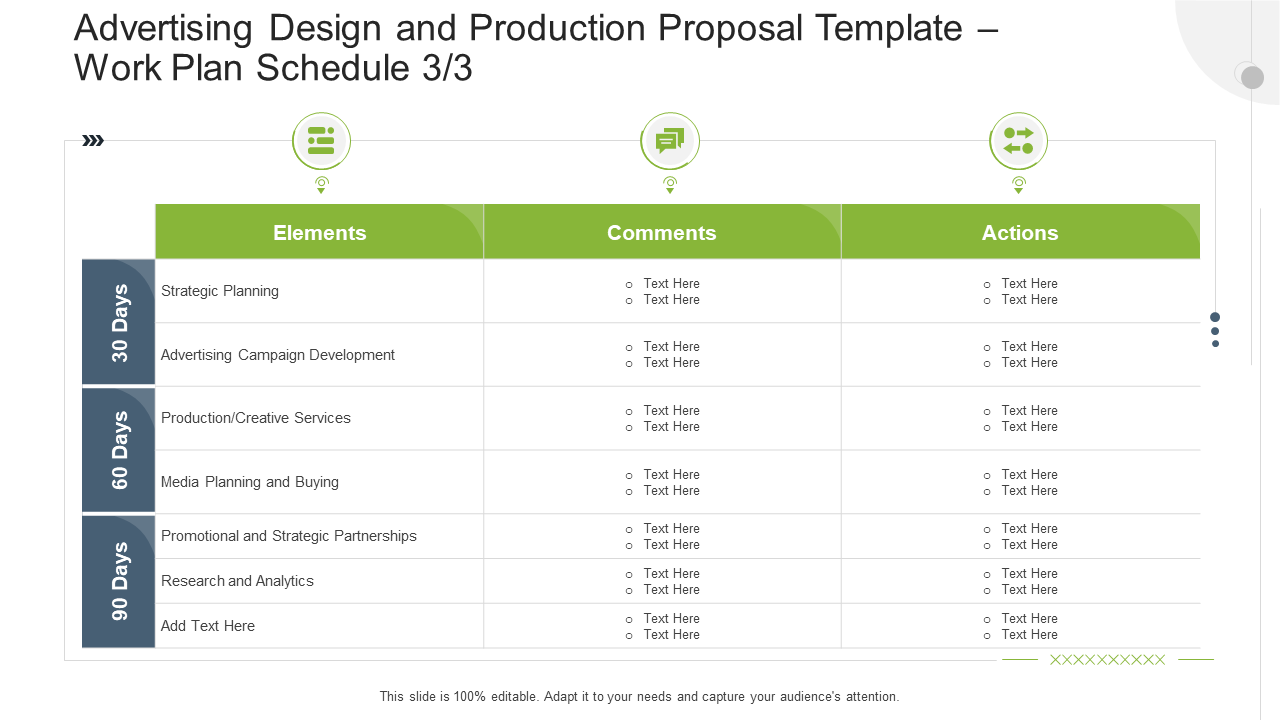
Template 2: Market Activity Schedule Plan for Production Promotion PPT Slides
Are you worried about presenting a product promotion-related activity to your boss? This market activity schedule plan PowerPoint Template will do the needful. Showcase your promotion schedule plan by portraying the promotion’s ideas, description, objectives, and designated employees with estimated cost and budget.
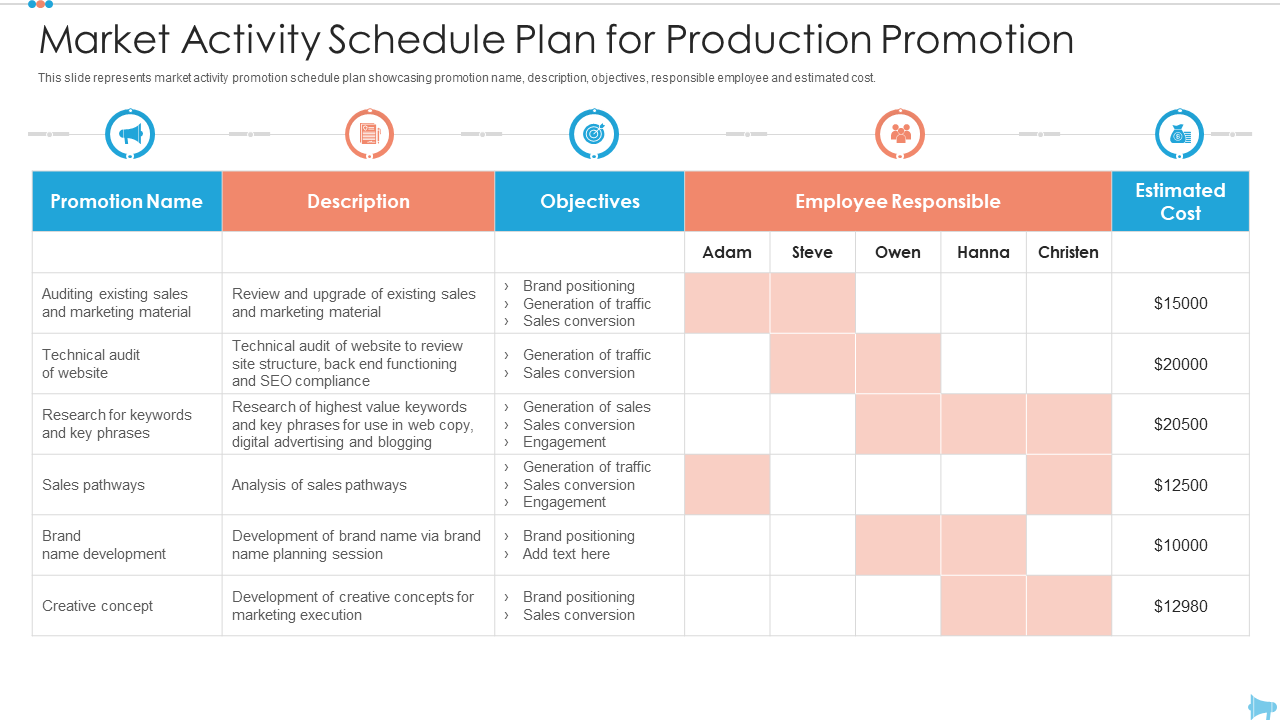
Template 3: One-Pager Production Schedule Sheet Template
Bored of long and massive marketing plans? Use our one-pager production schedule sheet template and pitch your production report with precision. With this presentation template, cover your upcoming production plan for the manufacturing plant focusing on launching stock, sales forecast, quantity to produce, current status (in terms of order fulfilment and production cost), order status, and product categories sold. Optimize the production scheduling sheet and make your team members aware of the process and their own tasks.
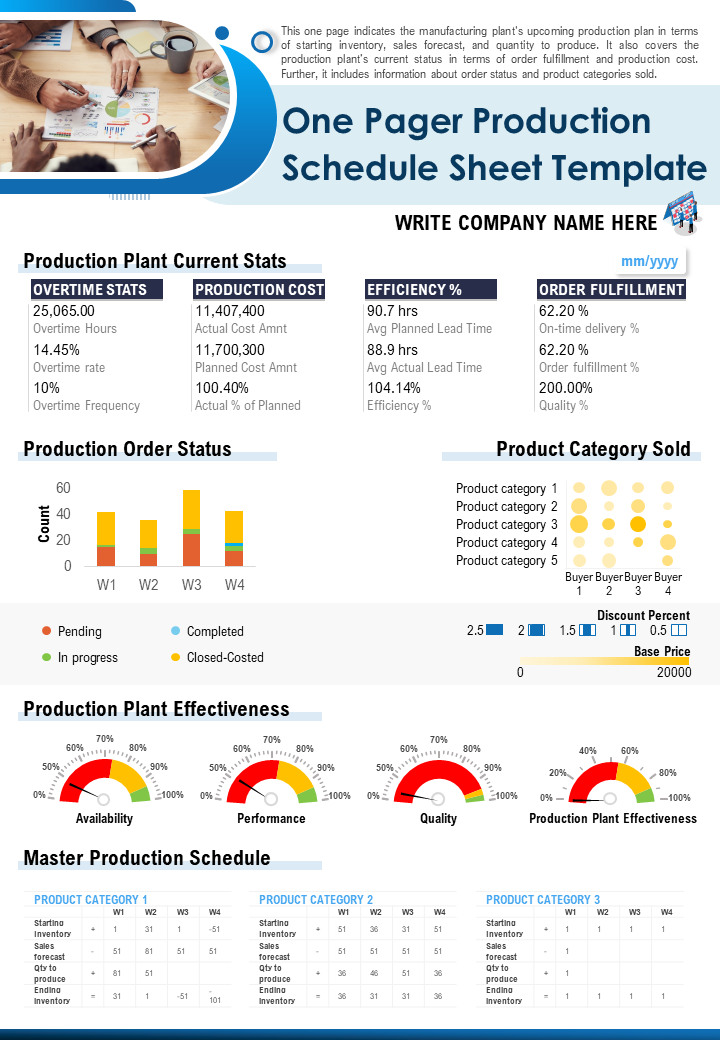
Template 4: Production Schedule Order Amendment Presentation Slides
Manage your production needs with the help of this production schedule PowerPoint Template. It allows you to cover planning and allocation processes, and create a well-organized schedule for your company's functioning prerequisites (proper routing, dispatching, and follow-up). Deploy this template at the earliest to convey your plan, and increase your company’s profitability and productivity.

Template 5: One-Pager Production Schedule Sheet Template Fit for Army Standards
Do you feel preparing a One-Pager data sheet from scratch can be a mammoth task? Deploy our top-notch one-pager army production schedule sheet PPT Template to provide a comprehensive view of the product or service details. This template is divided into Sections: Introduction of your company and its achievements, client requirements, production cost details, production schedule, and project team management. Customize this A4-size template now and present your product details to potential clients.
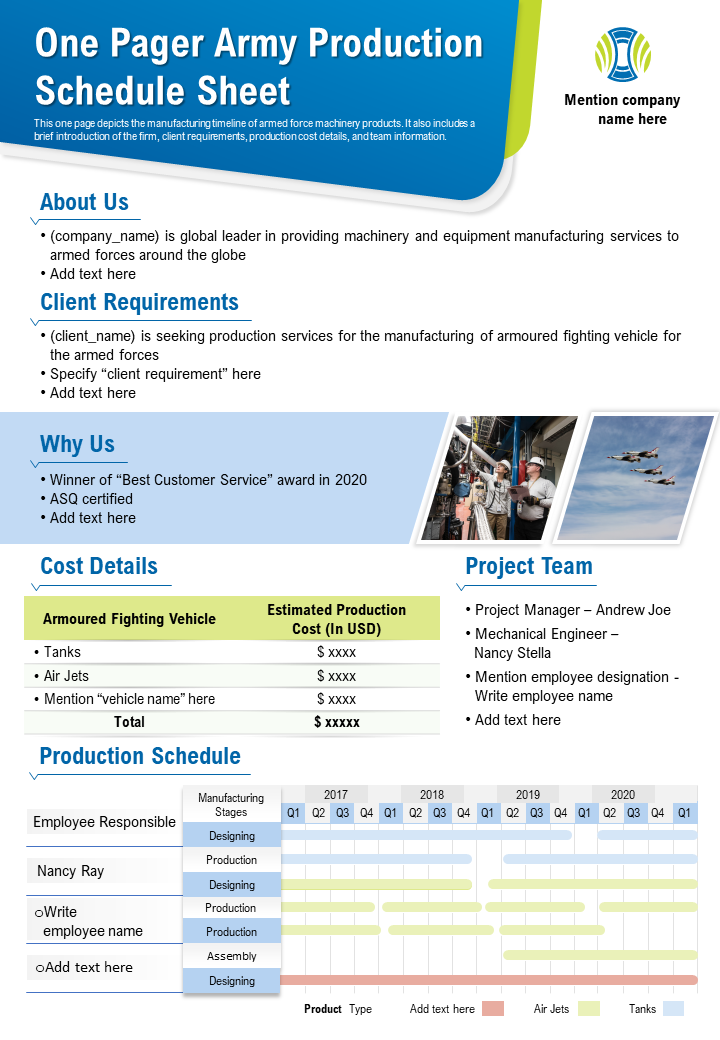
Template 6: Industry Capability Analysis Current Production Schedule Template
Deploy this PowerPoint Template to accomplish industry capacity analysis, in terms of raw material production. This PPT Template is divided into four stages: Current production by the shop, overall equipment effectiveness, production status, and asset status. Keep a check on the equipment effectiveness using a pie chart. Why wait? Grab this template immediately to ramp up production to gain market share.
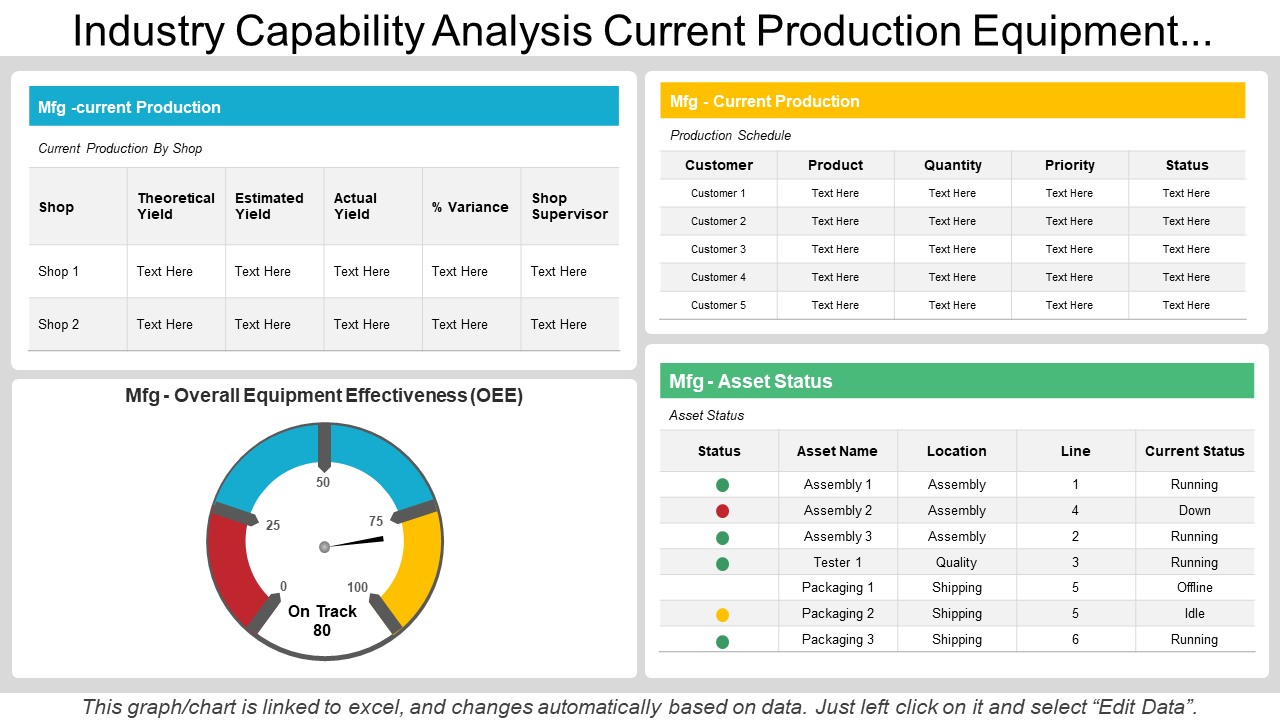
Template 7: Work Plan Schedule Analytics Advertising Design and Production Proposal
Are you looking for a way to get your work plan schedule analytics advertising design and production proposal done like clockwork? Look no further than our innovative new product! This template comes with everything you need to plan and schedule your advertising campaign, including an analytics tracker so you can measure your results. It's easy to use and edit, so you can tailor it to your specific needs.
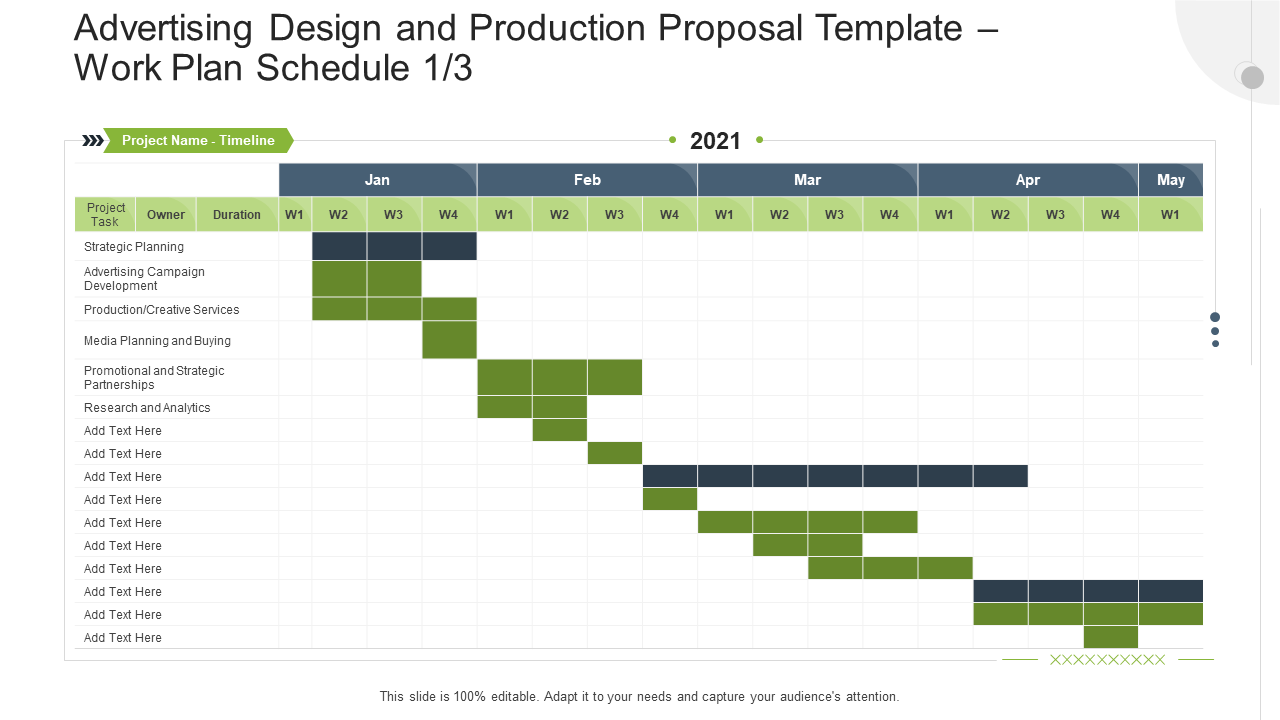
Template 8: Production Schedule Maker PowerPoint Presentation Gallery Template
Use our top-class production schedule maker PPT Template that has four stages. It helps run your manufacturing process smoothly and deliver your products on time under a cost-effective budget. From content (data and statistics, image, text) to layout (font, color, icons), personalize this PPT Template. Without any delay, get started with this template now!
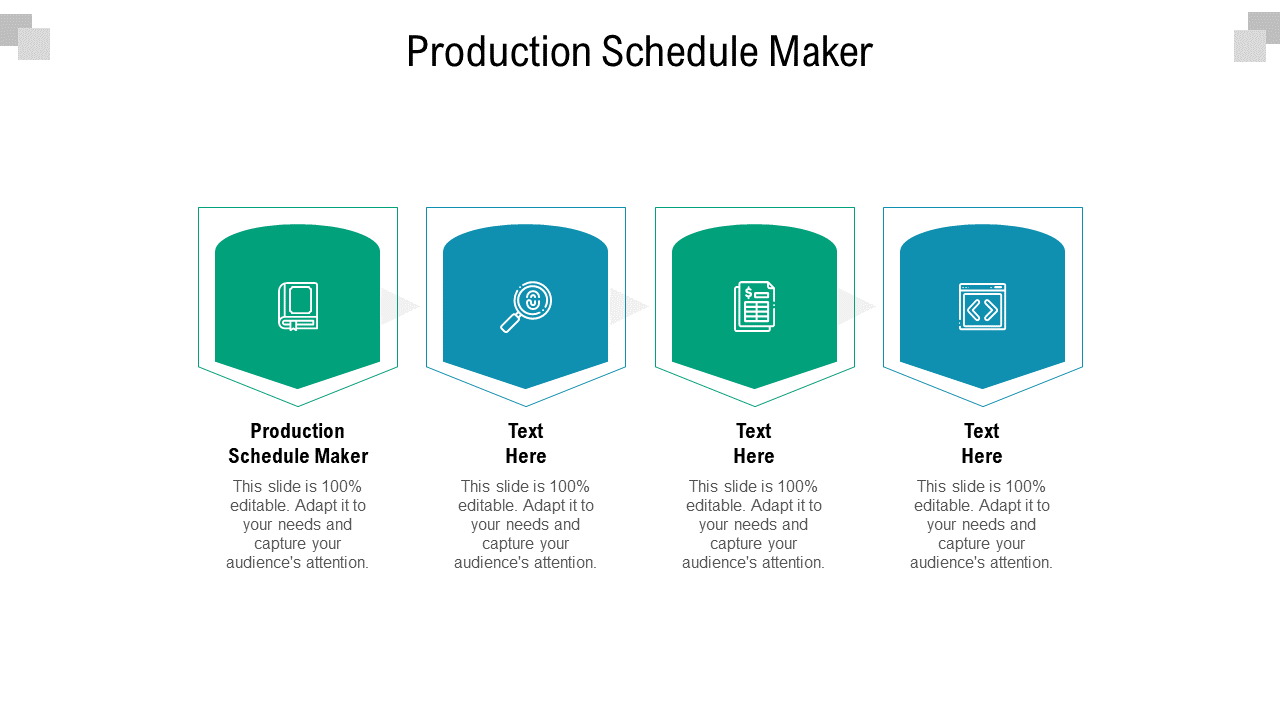
Template 9: Video Production Project Proposal One-Pager PowerPoint Slides
Do you need help presenting your video production project proposal? Use our video production project proposal one-pager Template and say goodbye to all the fuss and confusion. Highlight your project goals, production process, client statement, key deliverables, video package, and much more. Simply customize the presentation template design for a more personalized look, fill in the details and impress clients.
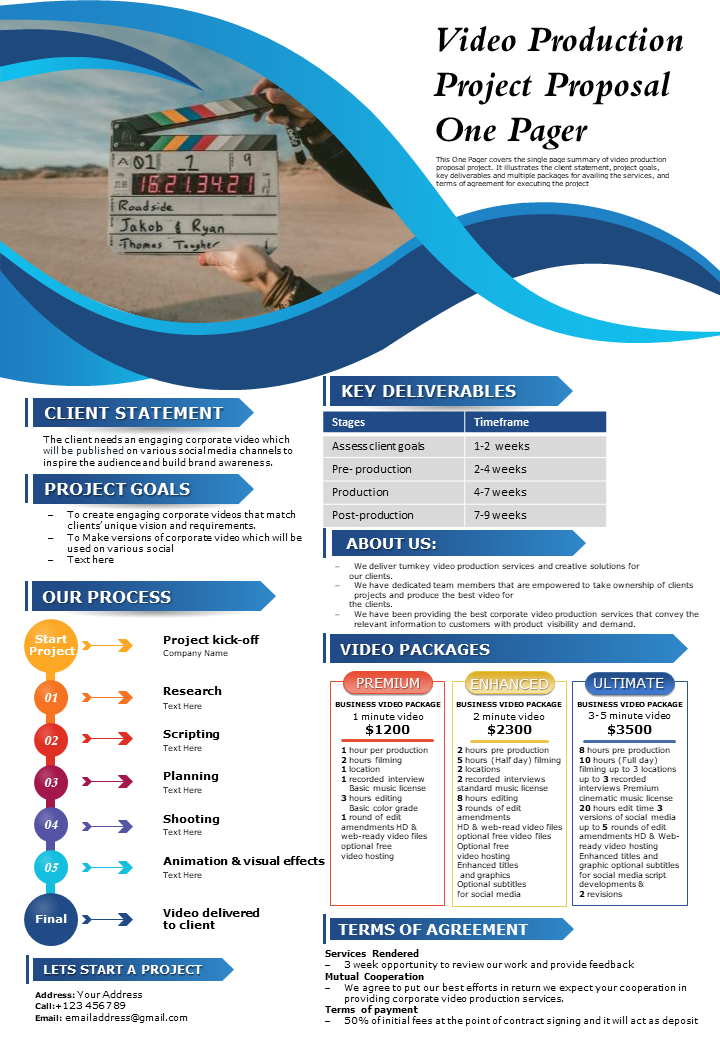
Template 10: Plan of Action for Media Digitalization Production Schedule One-Pager
Looking to develop a production plan for your next idea or project but don’t know where to start? Set a benchmark with our action plan for media digitalization production schedule PPT Template. This one-pager Template offers high-quality visuals and focuses on the scene, location, date, time, cost, equipment, etc. Say no to delays and download this one-pager PPT Template to revitalize you project.
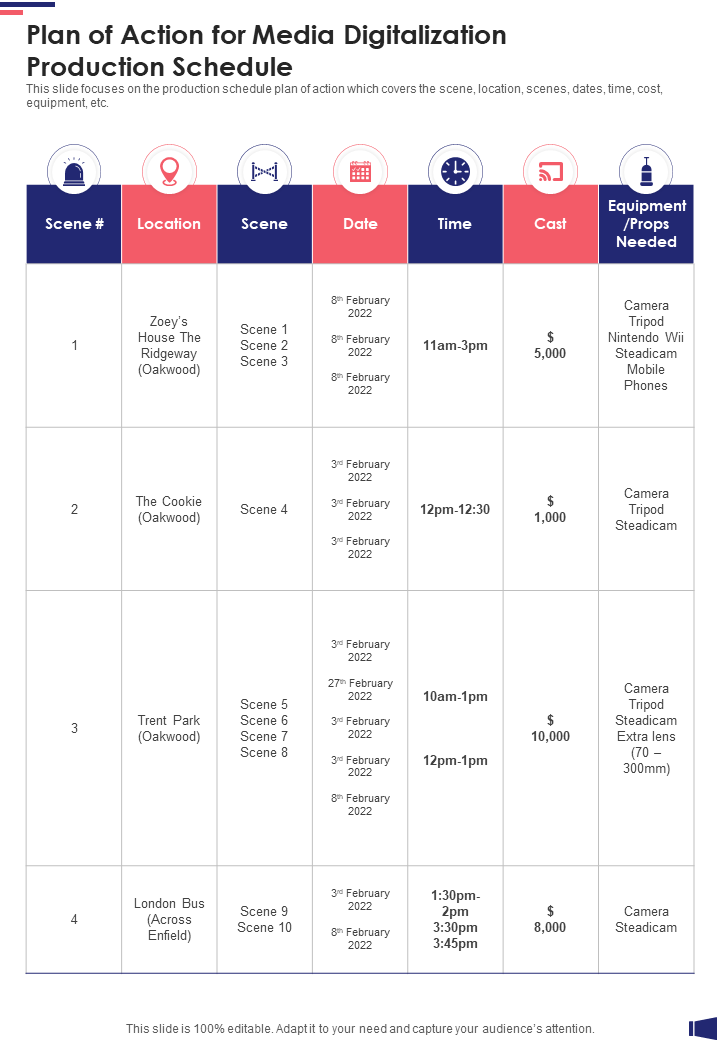
Production Schedule: A Blueprint!
A production schedule is a framework for allocating resources and listing the products that will be manufactured on a timescale. Though, it is a tricky process, SlideTeam offers the Top 10 Production Schedule Templates which will help you create a production schedule in a jiffy. You are just a click away from downloading these actionable slides. Get these Templates now!
PS: Now you have a handy production schedule template by your side, do you want to lay the groundwork for a successful video production business? Peruse our well-designed blog templates and invest your time in creating a comprehensive video production proposal.
FAQs on Production Schedule
What do you mean by production scheduling.
Production scheduling is a versatile document for planning, forecasting, and meeting demands. It is deployed in a manufacturing company to manage and control the execution of the production process. Generally, it describes how to use the manufacturing unit’s resources to satisfy a production plan, or how machines should be used by the company to manufacture products within a time frame. It is essentially the timetable that governs a business’s functioning. Over time, boundaries have blurred between production and services, hence, a production schedule has come to refer to specific business activities as well.
What are the main components of production scheduling?
If you want to formalize your production scheduling process, follow these six components:
- Planning: First, prepare your demand plan. There are two types of planning offered- static or dynamic, to collect and analyze available resources, budgets, timelines, and staff availability.
- Routing: The next step is to identify the place from where you will procure youe raw materials, and how to deliver these to the manufacturing team. Mainly, it focuses on the most cost-effective route.
- Scheduling: After routing, develop a schedule to define how you will meet all requirements, say, contingency plans. During this process, you can create a master schedule, manufacturing schedule, etc.
- Dispatching: It issues orders and instructions on how goods and people will move around from one place to another throughout the production schedule process.
- Execution: This is the final and most important step of the entire production schedule process. Here, you put your plan into action.
- Maintenance: Keep your schedule up-to-date because demand may keep fluctuating throughout the production process.
Production scheduling is a very important process for a manufacturing unit. It So, it should includes the following elements:
1. The most important factor is the product inventory, which lists all the manufactured products.
2. Later on, a variation sub-list (size, color, type) should be included.
3. Don't forget to mention the demand and delivery dates of the products.
4. Lastly, production quantities, say, the number of units you will produce each week are a must.
What to include in your production scheduling?
Production scheduling is a very important process for a manufacturing unit. It includes the following elements:
- The most important factor is the product inventory, which lists all manufactured products.
- Later on, a variation sub-list (size, color, type) should be included.
- Don’t forget to mention the demand and delivery dates of the products.
- Lastly, production quantities , say, the number of units you will produce each week are a must.
How to optimize your production scheduling?
To optimize your production scheduling, here are some strategies that you can implement:
- Improve the prediction accuracy of your market expectation. For this, you have to estimate accurate insights into the production, inventory, and selling of goods.
- Another important step is to standardize your production scheduling. It starts with process mapping to create an alignment between demand expectations and capacity utilization.
- To create solid production plans, use any tweaks and adjustments, say, digital twins, to visualize the efficiency of expected results.
- If you don’t want any delay in the production process, integrate your supply chains. You can integrate IT ecosystems with the supplier’s ecosystems, so that data can be shared in time.
- Get transparency in transport times, parts availability, etc and adjust your production schedules to keep things moving without worrying about unexpected events.
Download the free Production Schedule Templates PDF .
Related posts:
- How to Design the Perfect Service Launch Presentation [Custom Launch Deck Included]
- Quarterly Business Review Presentation: All the Essential Slides You Need in Your Deck
- [Updated 2023] How to Design The Perfect Product Launch Presentation [Best Templates Included]
- 99% of the Pitches Fail! Find Out What Makes Any Startup a Success
Liked this blog? Please recommend us

How to Prepare Best Film Production Company Profile?

Top 10 Video Production Proposal Templates with Samples and Examples

Digital revolution powerpoint presentation slides

Sales funnel results presentation layouts
3d men joinning circular jigsaw puzzles ppt graphics icons

Business Strategic Planning Template For Organizations Powerpoint Presentation Slides

Future plan powerpoint template slide

Project Management Team Powerpoint Presentation Slides

Brand marketing powerpoint presentation slides

Launching a new service powerpoint presentation with slides go to market

Agenda powerpoint slide show

Four key metrics donut chart with percentage

Engineering and technology ppt inspiration example introduction continuous process improvement

Meet our team representing in circular format


IMAGES
VIDEO
COMMENTS
A production plan serves as a roadmap that outlines the steps, resources, and strategies required to manufacture products or deliver services efficiently. By carefully crafting a production plan within a business plan, entrepreneurs can ensure optimal utilisation of resources, timely delivery, cost efficiency, and customer satisfaction.
Traditionally, a marketing plan includes the four P's: Product, Price, Place, and Promotion. For a production company business plan, your marketing strategy should include the following: Product: In the product section, you should reiterate the type of production company that you documented in your company overview.
The production industry in the U.S. is a $26B market with approximately 6.3K businesses and over 46K employees nationwide. The outlook for the production market is positive with demand expected to remain steady over the next several years. The production industry can be categorized by type of production.
This is the standard production company business plan outline, which will cover all important sections that you should include in your business plan. Executive summary. Market Validation. Objectives. Short-Term (1 -3 Years) Long Term (3-5 years) Mission statement. Unique Selling Proposition.
We provide a free business plan template below and will walk you through it. Step by step. Production Company Business Plan. The Executive Summary. Perform a Video Company Self Assessment. How to Get Started. Financing a Video Production Company. Marketing Plan. Day to Day Operations.
By. Susan Ward. Updated on September 13, 2022. Fact checked by David Rubin. In This Article. How To Write the Operations Plan Section of the Business Plan. Stage of Development Section. Production Process Section. The Bottom Line.
If you are planning to start a new manufacturing, fabrication, or production business, the first thing you will need is a business plan.Use our business plan example created using upmetrics business plan software to start writing your business plan in no time.. Before you start writing your business plan for your new manufacturing business, spend as much time as you can reading through some ...
Here are the five types of production planning, with an example of each: 1. Flow. The flow method involves smoothing the connections between manufacturing stages and steps to prevent bottlenecks or delays. Flow manufacturing often involves thorough standardization and intensive quality control.
1. Estimate/Forecast Product Demand. Understanding product demand planning is the best way to decide which product planning method is the best choice for your operation. You'll need to use diverse sales forecasting techniques to better understand what will be the future demand for your product.
When we designed our business plan for a production company, we ensured it was properly organized. The document consists of 5 sections (Opportunity, Project, Market Research, Strategy and Finances). 1. Market Opportunity. The first section is named "Market Opportunity".
A production plan defines the production targets, required resources and overall schedule, together with all the steps involved in production and their dependencies. A well-designed production plan helps companies deliver products on time, reduce costs and respond to problems. Technology has made it easier for small and midsize companies in ...
4.1.5 Strategic Alliances. The company plans to form strategic alliances with clients who require a freelancer to cover various events for them. Michael's Video Service will also develop strategic alliances with video production companies and work with them as a sub-contractor.
Explore a real-world brewery business plan example and download a free template with this information to start writing your own business plan. ... Our production system shall strive to attain service excellence in addition to manufacturing safe, quality products. This shall be undertaken through the engagement of modern production techniques ...
The first stage includes the work that has been done so far, whereas the second stage describes it in detail. 1. Development Phase. In this stage, you mention what you've done to get your business operations up and running. Explain what you aim to change and improvise in the processes.
Create a goal that everyone is motivated to complete with the resources available. Timely - Provide a deadline so everyone has a date they are working towards. Different departments will have different operational objectives. However, each department objective should help the company reach the main objective.
Film Production Company Business Plan: The Complete Guide. Matt Crawford 4. The process of film production is a long and arduous one. It starts with the writing stage, where screenplays are written by a writer or multiple writers. The screenplay typically has at least three acts that have to be edited for pacing and story development purposes.
Using a production schedule template improves your business's efficiency and organization while contributing to the overall success of the production process. Some of the key advantages of using a production planning template include: More efficient resource allocation: A good production plan will help you allocate resources efficiently ...
A production plan is a detailed document that outlines the structure of the company's operations. In the plan, there is a structure, schedule, goal, activities, and the definition of resources in between. It is one step closer to success at a time. So, whenever your path is uncertain, a production plan will help in opening the right direction.
Step1: Plan Everything. The first step to starting any business is to write up a business plan for it. So, naturally, you will need to develop a sample business plan production company. You can refer to a template for starting a biodiesel company business plan, etc. to understand the nuances of the document.
The Anvyl production planning template was created to make the entire process of production planning easier for you and your team. Rather than creating a production plan from scratch, you can get started faster by using our template. The legwork is already done for you — all you need to do is customize the Excel spreadsheet to fit your business.
This template is specifically designed to help you secure funding, attract investors, and guide the overall direction of your video production business. With ClickUp, you can: Plan and organize your marketing strategies, production processes, and distribution channels. Track and manage your financials, including revenue streams, expenses, and ...
A business plan has 2 main parts: a financial forecast outlining the funding requirements of your video production company and the expected growth, profits and cash flows for the next 3 to 5 years; and a written part which gives the reader the information needed to decide if they believe the forecast is achievable.
1. Regular reviews and updates. Markets shift, consumer behavior changes, and your business will grow. Your plan must evolve with these factors, which makes regular reviews and updates a must-do ...
Template 1: Work Plan Schedule Production Proposal Template. Clarify your business operations with the use of this production proposal PPT Template. Use this presentation template to schedule your strategic planning, production services, advertising campaign development, strategic partnership, and much more.